


SATURDAYS IN JUNE

Tours only in June




































































SATURDAYS IN JUNE

Tours only in June
































































Erland Cooper – Asleep on the Wing
ABBA – Eagle
Nina Simone – Fodder in Her Wings
Bill Callahan – Too Many Birds
Kelly Lee Owens – Bird
Cloth – Pigeon














Kate Nash – Birds
Mermaid Chunky – nature girl
Rosalía – CHICKEN TERIYAKI
Alessi Brothers – Seabird
The Trashmen – Surfin’ Bird
EELS – I Like Birds
Oklou – blade bird
They Might Be Giants – Birdhouse In Your Soul
Billie Eilish – Birds of a Feather
The Ophelias – Bird
Bob Marley & The Wailers – Three Little Birds
Nelly Furtado – I'm Like a Bird
Leonard Cohen – Bird on the Wire















Listen to this playlist on Spotify — search for 'The Skinny Office Playlist' or scan the below code

Issue 233, June 2025 © Radge Media C.I.C.
Get in touch: E: hello@theskinny.co.uk











The Skinny is Scotland's largest independent entertainment & listings magazine, and offers a wide range of advertising packages and affordable ways to promote your business. Get in touch to find out more.
E: sales@theskinny.co.uk
All rights reserved. No part of this publication may be reproduced in whole or in part



Meet the team
We asked: In honour of Katie Goh's personal history of the orange, what's your favourite fruit?
Senior Editorial

Rosamund West Editor-in-Chief
"Anything I can get directly from a tree or bush – raspberries and brambles round here, oranges and lemons (much) further south."
Commissioning Editors

Cammy Gallagher Clubs Editor "Mangooo."

Peter Simpson Deputy Editor, Food & Drink Editor
"A big juicy strawberry, the colour and size of a fire engine. Big up my guys in Fife and Perthshire, top work."

Eilidh Akilade Intersections Editor
"I'll always be a raspberry girl, especially at the right time of year. Underrated berry imo."

Anahit Behrooz Events Editor, Books Editor
"Pomegranates. They’re sexy, look like blood (see point a), are eaten in the underworld (see point a), are guarded and withholding and sweet underneath (see point a)."
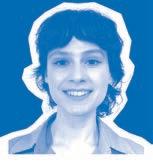
Rachel Ashenden Art Editor "Figs, despite the sacrificial wasps :("

Jamie Dunn Film Editor, Online Journalist "Peaches. I only manage to find a truly delicious one about every five years or so, but this scarcity just adds to their greatness."


Tallah Brash Music Editor
"Despite the fact I've got watermelon and apple tattoos, probably a peach. Like Kramer in that episode of Seinfeld, if you get a peach at the right time, oh my god."

Business

Laurie Presswood General Manager
"I don't do fruit. I've seen one too many grapes smeared underfoot in a primary school lunch hall. Better to just play it safe."
Sales

George Sully Sales and Brand Strategist
"It's gotta be the banana. It's a fickle fruit – too green, it's inedibly fibrous; too ripe, it's mush. But time it right and you'll be rewarded (with potassium)."
Production

Dalila D'Amico Art Director, Production Manager
"A ripe watermelon, pure chaos in fruit form. All flavour, nostalgia, and the anarchic joy of spitting seeds at your loved ones."

Sandy Park Commercial Director "Pineaple. In chunks. And not on pizza."

Phoebe Willison Designer "Aubergine (google it dont @ me x)."

Ema Smekalova Media Sales Executive
"I famously don't like fruit but citrus fruit? Hello?! Love a good pomelo and honorary mention goes to figs – gay ass fruit."
Polly Glynn Comedy Editor "Cucumber "


Rho Chung Theatre Editor "Korean pear."

Ellie Robertson Editorial Assistant
"Cranberries are both a delicious snack and a powerful amulet in defence against the accursed Stones of Kidney."

Emilie Roberts Media Sales Executive "Nothing beats those strawberries you buy from a random vendor on the side of the road on a fierce sunny day on the way to the beach. Makes life worth livin."
Words: Rosamund West
This month’s theme, Migrations, was sparked by Refugee Festival Scotland and a desire to explore a programme which reflects what we believed to be the values of the country we live in – one which celebrates diverse experience, connects communities, builds supportive networks. The Scotland that is rightly celebrated for the Kenmure Street protests, and for just generally being interested in hearing about what life is like for different people and cultures. Then we found out halfway through making the issue that the UK’s supposedly left-wing government has drifted into anti-immigration policy making, complete with Enoch Powell-alluding rhetoric, and it started to feel more urgent to reaffirm our position.
In our opening spread, Anahit Behrooz visits Iranian filmmaker Javad Daraei, who welcomes her into his home to discuss his work and experience as part of a global community of refugees. We also meet Esraa Husain, Refugee Festival Scotland’s Programming Fellow, to learn more about what’s in store in this year’s edition.
We talk to Edinburgh-based author (and our former Intersections editor) Katie Goh to hear all about their debut memoir Foreign Fruit, which explores globalisation, colonialism and migration through the medium of the humble orange. Glasgow-based artist Hanna Tuulikki discusses her new sound work for Folkestone Triennial, which explores the song of the marsh warbler, whose call incorporates samples from dozens of different birds encountered on its migratory path between northern Europe and southern Africa. And Ukraine’s Alice Haspyd and Scotland’s Genevieve Murphy talk about their collaboration for Sonic Interventions, a series of performances and installations of experimental music and sound art, which takes place across Glasgow venues in June.
We meet filmmaker and Beta Band member John Maclean to hear about his second feature, Tornado, a Western set in Scotland whose hero is a Japanese teenager. Duncan Grant, aka CAIN, introduces his debut album Lineage, which draws on his Highland upbringing and bagpiping past to combine Celtic traditions and electronic music.
We take a trip to Govanhill, where the second iteration of community music education programme Big Noise is warming
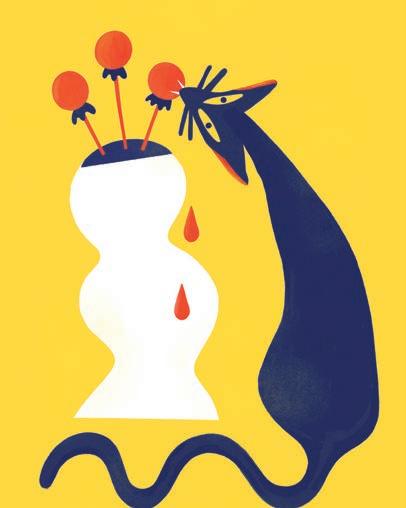
up to perform. Based on Venezuela’s radical El Sistema programme bringing social change through free classical music training, Big Noise started in Stirling’s Raploch before expanding to Scotland’s most diverse neighbourhood in 2013. Intersections closes the Migrations theme with a reflection on Humraaz, a radio show that aims to promote connection amid rising cross-border tension between India and Pakistan.
This issue features not one but two pipers – award-winning composer and small pipes player Malin Lewis is curating a strand in The Queen’s Hall, and we’re collaborating with them on a podcast series to offer an insight into the programme. As summer festival season kicks into gear, we’re most excited about our Pyramid Stage at Kelburn Garden Party, once again curated by our very own Tallah Brash. Read on for a deep dive into this year’s lineup.
We’ve got a Film / Books crossover as film critic Ryan Gilbey talks to us about It Used to Be Witches, his new, very personal study of queer cinema history. Film is also, rightly, extremely excited about the imminent reopening of Edinburgh’s Filmhouse. Theatre explores a new National Theatre Scotland collaboration, The Neighbourhood Variety Show – Sauchiehall Street, part of the ten-year redevelopment plans for one of Glasgow’s central arteries. Design looks forward to Architecture Fringe, bringing a Scotland-wide programme of events and exhibitions emphasising the social and community aspects of building design, and Food takes a trip to Glasgow for some Spain-inspired bites at Corner Shop.
In the middle of the magazine, you’ll find a very special supplement – our annual guide to the Glasgow School of Art Degree Show, an insider’s guide written by non-graduating students taking advantage of their unparalleled access and insight into the nascent artists and designers’ inner workings.
This issue closes with The Skinny On… Snapped Ankles, ahead of their performance at Hidden Door, which returns mid-month to a former paper factory on the outskirts of Edinburgh. Austin Ankles takes a poetic approach to answering the Q&A, with evocative descriptions of picnicking amongst nuclear detritus at Dungeness, and meaning-of-life level quotations from Ursula K. Le Guin.
Cover Artist
Magda Michalak is an Edinburgh-based Illustrator and graphic designer, working for editorial, branding and advertising projects. She likes to combine fine art with design, loves dynamic, colourful and abstract projects. She's always drawing, engaged with projects about human rights, folklore, sustainability and nature.
IG: magda__michalak magdalenamichalak.com
This month’s columnist reflects on taking the road less travelled.
If you’re a marginalised writer or journalist of some description, attending a book launch feels a bit like attending a wedding. Every conversation you have seems to come to one question: “And where’s your book?”
Milestones – books, spouses, babies, degrees – structure the course of our lives, both in retrospect and in imagination. A bit like a wedding, a book launch marks a discrete point in time that stands in for a continuous process. It’s a corner on a life path, a fixed place where one must follow or go off-road.
One of my favourite turns of phrase is the ‘desire path’, referring to an urban planning phenomenon in which a path is formed – often over grass or unpaved terrain – indicating an alternative route chosen by enough people that it becomes worn down, marked by thousands of feet taking it over the one imposed by the pavement.
A desire path is a living record of collective decision making in which strangers agree to diverge from the path one at a time. It’s a collaborative act of rejection built off of individual decisions to go a different way. The study and preservation of desire paths (or ‘erosional paths’, as they’re sometimes called) counteracts the erasure wrought by colonisation and settlement. As the land is paved over with concrete and high rises, the body resists by deferring to intuition. As more feet erode the path, it becomes easier for others to take.
I’m fundamentally resistant to rhetoric that urges us to “forge your own trail,” or “paddle your own canoe.” Maybe I have a book in the pipeline. Maybe I don’t. But, regardless, to share a desire path is a beautiful thing. We don’t have to be walking it at the same time for it to remember our feet.
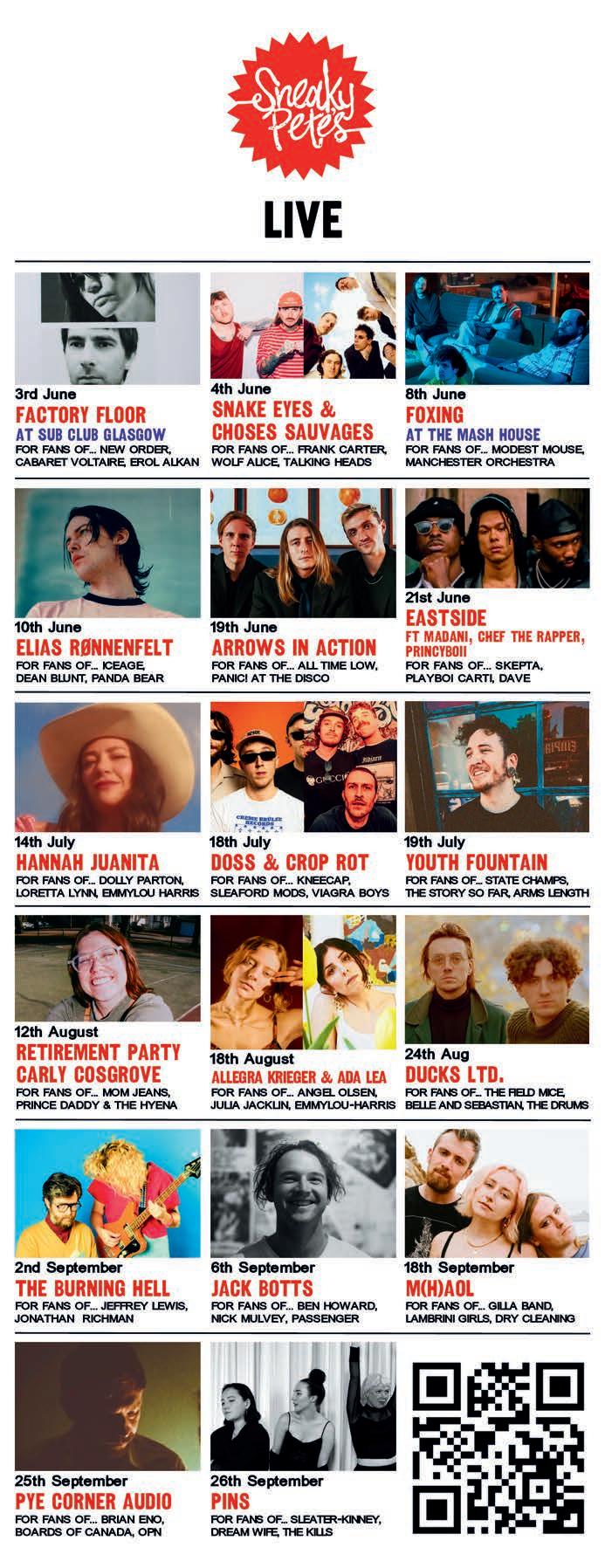
The Paper Factory, Edinburgh, 11-15 Jun
After a smaller scale 2024, Hidden Door makes its big return to Edinburgh’s festival circuit, taking over the massive abandoned Paper Factory on the outskirts of Corstorphine. The lineup is really something, with sets from the likes of Mermaid Chunky and Katy J Pearson, curated club lineups from Samedia Shebeen and Paradise Palms Records and site-specific interdisciplinary collaborations from Acolyte and All Or Nothing filling the factory’s labyrinthine corridors.
EHFM’s Pride Extravaganza
Sneaky Pete’s, Edinburgh, 7 Jun, 11pm
Celebrate Pride month with community radio station EHFM and their June club night, featuring a gorgeous lineup of their favourite queer DJs. Find Millux playing b2b with al gu, Throughline, TTotal, Lietzsche and Buckfast Barbie for an extremely eclectic and genre-bending night of queer joy and dance music.

MJ Lenderman
Old Fruitmarket, Glasgow, 2 Jun, 7pm
Indie darling MJ Lenderman’s music feels deliciously old-school, with scuzzy sounding guitar riffs and rich, quavering vocals reminiscent of the noughties heyday of the indie scene. This nostalgic vibe marries perfectly with his deftly contemporary songwriting and collaborations with the likes of Waxahatchee and Indigo De Souza – find him touring his fourth solo album Manning Fireworks this month.
ECA Graduate Show 2025
Edinburgh College of Art, Edinburgh, 30 May-6 Jun

Summer descends on Scotland, and with it comes a slew of festivals, beautiful exhibitions, and more Pride events than you can shake a stick at
Compiled by Anahit Behrooz



Porty Pride Ball
Portobello Town Hall, Edinburgh, 7 Jun, 7pm
Back for its fourth year, the 2025 Porty Pride Ball is curated by queer poet Jj Fadaka and features a stunning lineup of queer performers and DJs. There’s more to be announced soon, but names so far include DJs Arusa Qureshi and Ria Andrews spinning R‘n’B, amapiano, baile funk, and pop and house edits, with hosting from Saffron Cherry’s iconic drag king Butch Cassidy
20x20: The Skinny x GSA
Vic & Assembly Hall, Glasgow, 3 Jun, 7:15pm
Part of The Skinny’s 20th birthday celebrations, this Pecha Kucha style event spotlights GSA-associated artists, designers and architects who have been featured in the magazine’s history through a series of unconventional presentations. Find an exciting range of speakers, including Darren Cullen, Jonny Mowat, Zara Gladman presenting 20 slides in 20 seconds per slide, followed by a DJ set from Glasgow-based collective HONEY.


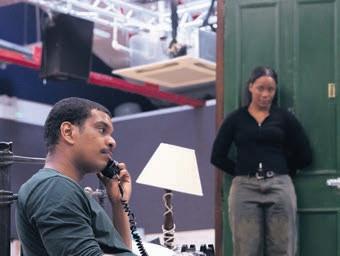
King Tut’s, Glasgow, 22 Jun, 7:30pm

Various venues, Scotland, 1322 Jun
Celebrating 25 years of the Refugee Festival and 40 years of the Scottish Refugee Council, the 2025 edition of the Refugee Festival is themed around Milestones, commemorating decades of community building and cultural enrichment. Highlights include a commissioned film by documentarian Bircan Birol, a food tour of Govanhill, and a collaborative exhibition by displaced artists from Ukraine, Iran, Vietnam, Colombia, Afghanistan, and Pakistan.

EXIT Summer Closing Fundraiser Weekend
Exit, Glasgow, 27-28 Jun
Head on over to Exit for their summer closing fundraiser weekend, spread over the last Friday and Saturday of June. The first night is curated by Glasgow-based legend Plantainchipps and features Jersey club, amapiano and hip-hop aficionado Bellarosa on the lineup, with more to be announced, while the second night has an industrial bent ft. RS Tangent, Faux Naif and more.
Jonathan Baldock: WYRD
Jupiter Artland, Edinburgh, until 28 Sep
Artist Jonathan Baldock’s Jupiter Artland exhibition is a veritable zoo of hybrid animals formed from textile and clay, drawing on animals who exhibit same-sex sexual impulses – penguins, giraffes, crabs and elephants – who mutate into mythic harpies, mermaids and phoenixes. Out of this new taxonomy emerges a fascinating exploration of myth-making, queerness and hybridity.

Malin Lewis Presents: Fri , Marvara, Me Lost Me
The Queen’s Hall, Edinburgh, 31 May, 7:30pm



Part of a beautiful new series curated by award-winning innovative trad musician Malin Lewis, this second gig features a groundbreaking lineup of folk musicians: find dreamy ensemble Fri marrying Nordic folk and bluegrass, high-octane trad band Marvara playing their festival tunes, and experimental folk outfit Me Lost Me showcasing her exquisite songwriting talents.
Wet Leg
Usher Hall, Edinburgh, 27 May, 7pm

Kelburn Castle, Fairlie, 3-7 Jul
There’s some killer names on the Kelburn Garden Party lineup this year, with live sets from the likes of She Drew the Gun and The Allergies, and DJ sets from Auntie Flo and Sofia Kourtesis and stages by baile/ baile, EHFM and Paradise Palms. We’re especially excited for our curated stage, featuring TAAHLIAH, Man of Moon and R.AGGS.
Various venues, Edinburgh, 20-24 Jun
A cultural life – how it is shaped and established and fought for – takes centre stage at Art 27 Scotland’s Culture = Life: Palestinian Artist Programme, a mini festival curated for Refugee Week which explores the power of art in the face of erasure. Find performances – Farah Saleh’s choreographic piece Balfour Reparations 2025-2045 and Alaa Shehada’s The Horse of Jenin – film screenings and a tatreez embroidery exhibition.
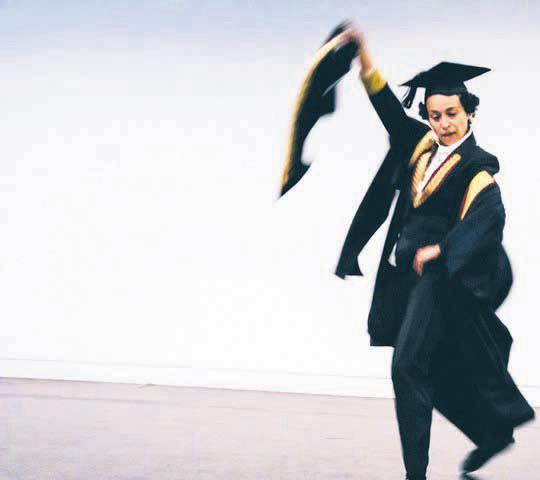

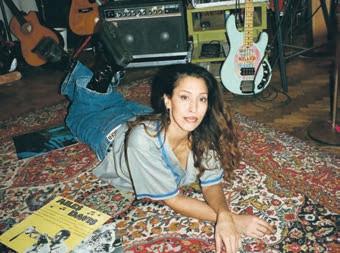
Architecture Fringe Various venues, Scotland, 6-22 Jun
The Hug and Pint, Glasgow, 16 Jun, 7:30pm
It’s a big birthday month, as beloved Glasgow venue The Hug and Pint turns ten. To celebrate, they have a month’s worth of gigs featuring the best of the local music scene and beyond: we’re especially excited by experimental jazz musician Moor Mother and the evocatively titled Brooklyn art-pop outfit Fantasy of a Broken Heart.

The Flying Duck, Glasgow, 6 Jun, 11pm Stereo Pride with Hoe_Mies + Scandal.gla + Shitepop +


June marks the official start of summer festival season, and two family friendly affairs – Eden Festival (Moffat, 12-15 Jun) and Solas Festival (Perthshire, 20-22 Jun) – should be high up the priority list if you want a lovely camping weekend away with friends and/or family with an awesome soundtrack to boot. If being able to crash in your own bed is of higher importance, Hidden Door (11-15 Jun) takes over an old industrial site – The Paper Factory – in west Edinburgh with all manner of installations, performance art and live music set to take place across its five-day run, with Snapped Ankles, Mermaid Chunky, Erland Cooper, Katy J Pearson and Moor Mother heading up the bill.
In Glasgow, a collaboration between Scottish and Ukrainian artists brings Time Based: Sonic Interventions to various venues in the city (11-15 Jun), while the weekend before sees the inaugural Wastelands Festival (6-8 Jun) take over BAaD, Room 2, Slay and Stereo, featuring kitti, Doss, Pippa Blundell, Gaïa, Coffin Mulch and more. Later in the month, The Rum Shack host their second Hand of God All Dayer (21 Jun) with excellent South Londoners Blood Wizard topping the bill, plus local lovelies like Town Centre, Hound and Craig John Angus also set to play. Glasgow Jazz Festival also returns this month (18-22 Jun); as part of it catch Fat-Suit at Òran Mór and Matt Carmichael at Saint Luke’s (both 19 Jun) and Theon Cross ft. Graham Costello at Òran Mór (21 Jun).

Festivals aside, at the top of the month Glasgow singer-songwriter Pippa Blundell celebrates her debut album common thread with a listening party at The Glad Cafe (4 Jun), while on the same night Tom McGuire and the Brassholes launch their third album, A Name For Everything I’ll Ever Be, at The Rum Shack. The following night, our April cover star Jacob Alon brings their debut album In Limerace to The Art School, while the next week Kathryn Joseph celebrates WE WERE MADE PREY. at Saint Luke’s (11 Jun). On 20 June, wonky art-punks Water Machine launch their debut album God Park with a show at The Old Hairdresser’s, supported by Dancer, giving you an early taste of what to expect on our stage at Kelburn in July, while at the end of the month her picture launch their gorgeous debut EP Feed Me Hope at Stereo (27 Jun). Also, this month, Happy 10th Birthday to The Hug and Pint, who have a packed programme. Highlights include: Moor Mother (16 Jun), Raz & Afla (19 Jun) and F.O. Machete (22 Jun).
In Edinburgh this month, AMPLIFI returns to The Queen’s Hall with another stellar lineup of rising Scottish talent – expect Afrobeat from Pillz the Energizer, rap from A.K.A. Prince and soulful jazz from Aiysha, while on 13 June Faith Eliott launches their latest album, the absolutely stunning dryas, with a show at the Leith FAB Cricket Club. Over in Dundee, singer-songwriter Theo Bleak brings their latest EP, Bad Luck Is Two Yellow Flowers, home for a show at brand new venue, Canvas.
When it comes to tours, there’s a lot going on in Glasgow this month. Factory Floor play a gig slot at Sub Club (3 Jun), caroline bring caroline 2 to Saint Luke’s (7 Jun), Pulp celebrate More, their first album in almost 24 years, at OVO Hydro (7 Jun), Horsegirl bring Phonetics On and On to Mono (22 Jun), and catch Lana Del Rey at Hampden Park (26 Jun). At the Barrowlands, choose between Waxahatchee (8 Jun), Bright Eyes (22 Jun) and Japanese Breakfast (30 Jun), while in Edinburgh catch Osees at The Liquid Room (19 Jun) the night after their SWG3 show, or Lucy Dacus at Usher Hall (30 Jun).
[Tallah Brash]
There’s a bunch of film festivals heading your way in June. First up, Refugee Festival Scotland (13-22 Jun). The multi-arts festival has over 150 events planned across the country, many of them cinema-related. Take the opening



night screening at CCA, Glasgow, Within the Fragments of Gurbet, a documentary in which filmmaker Bircan Birol brings together fellow migrants and refugees living in Glasgow to map their own version of their new home. Also look out for Javad Daraei: Two Dead Films and One Still Alive, in which Daraei presents a pair of short films he made in Iran alongside footage from a new short he’s currently making in Scotland (Cameo, Edinburgh, 18 Jun). Find out more about Daraei’s films on p22.
Also look out for SAFAR Film Festival, the UK-wide celebration of Arab Cinema. The programme blends premieres of contemporary Arab cinema with a smattering of classics thrown in, and Glasgow Film Theatre hosts the festival’s Scottish events (19-27 Jun). Highlights look to be two urgent documentaries: Sudan, Remember Us, which follows four young Sudanese activists fighting for freedom in their war-torn nation using spoken word and poetry, and A State of Passion, a moving portrait of Dr. Ghassan Abu Sittah and the heroic work he’s performed in emergency rooms in Gaza.
The UK Green Film Festival also takes place up and down the country, with screenings at GFT (29 Jun-2 Jul), DCA (21-29 Jun) and Eden Court in Inverness (23-26 Jun); head to ukgreenfilmfestival.org for the full lineup. And in Edinburgh, check out some filmmakers of the future with the inaugural Edinburgh International University Film Festival, which aims to showcase films by university students from across the UK; it runs 31 May to 2 June at the Scottish Storytelling Centre.
We’re also looking forward to a pair of upcoming retrospectives at Glasgow Film Theatre celebrating two of cinema’s greats. Coincidentally, both filmmakers are masters of slick, hard-edged thrillers, and both are named Michael – Michael Mann and Michael Haneke. Full details at glasgowfilm.org
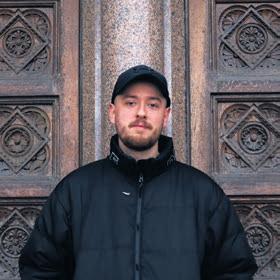
Cameo’s year-long celebration of the late David Lynch continues apace with all eight episodes of Twin Peaks season one screening at the Edinburgh cinema this month in double-bills over four consecutive Saturday evenings (7, 14, 21 & 28 Jun). The chance to see this masterful TV series on the big screen is incredibly rare, so don’t miss it.
Many great Q&A screenings are happening across June too. If we’re to choose just one, we’ll plump for Cameo’s screening of Lollipop (2 Jun), Daisy-May Hudson’s vivid drama about a single mum trying to keep custody of her kids. The screening is presented by Reclaim the Frame’s Eilidh Akilade (who also happens to be our brilliant Intersections editor), who’ll be chatting with Hudson after the screening. [Jamie Dunn]
Turbocharge your midweek at Sub Club on Tuesday 3 June, where Factory Floor (Live) returns from a lengthy hiatus with post-industrial dance cuts – support from noise maverick Russell Haswell.
On Thursday 5 June, experimental saxophonist and Joy Orbison collaborator Ben Vince plays an intimate set at The Glad Cafe from 7.30pm.
Michael J. Blood, joined by Richard Chater and Mother, continues to make lo-fi house cool at ENVY inside Glasgow’s EXIT on Friday 6 June. Meanwhile, in Edinburgh, Simontron keeps it sexy as ever for Hot Mess: Queer Dance Party at Sneaky Pete's.
Also at Sneaky's on Saturday 7 June, send it for the EHFM Pride Extravaganza with Al Gu, Buckfast Barbie, and more. Over at The Bongo Club, Chromatic showcases Kami-O and his serious selections of grime and dubstep.

Leftfield bass fans lock in on Friday 13 June – Flipside x Amity are back behind the The Berkeley Suite booth alongside Laksa + AKUMU. Otherwise, check out Tanum Sound System at EXIT with 5 Gate Temple – think drone, dub, and the wonkiest techno.
On Saturday 14 June, powered by Hometown Sound System, London’s former pirate station lands on Renfield Lane for Rinse x Stereo in Glasgow with Trim and Neffa-T – support from SMIFF, Chicha, and Tekhole.


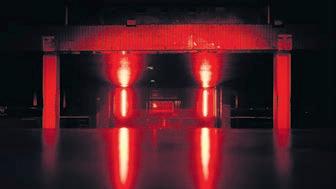


Friday 20 June sees the debut of Rat Capital, a new experimental showcase by Events Research Programme at The Flying Duck, spotlighting varied electronics from KOPI-O, ISO YSO, and zolf b2b spxo.
Closing out the month, Good Clean Fun hosts a sober all-day party at Strange Field Warehouse on Friday 28 June. Meanwhile, DVS1 delivers a 3-hour techno masterclass at The Mash House for Pulse in Edinburgh (27 Jun). Finally, give Glasgow’s rowdiest dancefloor one last rinse at the EXIT Summer Closing Fundraiser Weekend (Fri 27 and Sat 28 Jun).
[Cammy Gallagher]
It’s degree show season, baby! By the time the June issue reaches you/the streets, you may just be able to catch the tail end of the Degree Show 2025 at the Duncan of Jordanstone College of Art & Design (DJCAD), Dundee. Open for a limited time only (until 1 Jun), this is a celebratory showcase of graduating students’ work spanning a range of media, processes and ideas. Edinburgh College of Art (ECA) and Glasgow School of Art (GSA) unveil their graduate shows to the public on 30 May, closing on 6 and 8 June respectively. For a flavour of what’s in store at GSA, flick to the art section to read a preview of the exhibition by the students themselves.
Besides degree shows, there’s a few new exhibitions for your radar. Firstly, Garden Futures: Designing with Nature at V&A Dundee (until 25 Jan '26) offers a hope-filled possibility of a greener, more imaginative future through the visionary work of artists, designers and landscape architects. Then, atop Edinburgh’s Calton Hill, Fire on the Mountain, Light on the Hill opens at Collective on 20 June, continuing until 7 September. This solo exhibition presents recent work by Amsterdam-based visual and performance artist Mercedes Azpilicueta who is attuned to hidden stories from history, particularly acts of care and resistance. At Collective, Azpilicueta presents Potatoes, Riots and Other Imaginaries (2021), a mixed media installation that is rooted in research on the 1917 Potato Riots led by working-class women in the Jordaan neighbourhood of Amsterdam. Azpilicueta looks at present-day action, too, by platforming Ni Una Menos, a feminist social movement in Argentina. Resistance, an exhibition dedicated to the art of protest dreamed up by legendary artist and filmmaker Steve McQueen, travels from Turner Contemporary in Margate to Modern Two in Edinburgh. Opening 21 June, Resistance traces the mainstreaming of photography and the power of an image to instigate sociopolitical change in the UK. Lesser-known protests such as the Blind March of 1920 and the 1930s hunger marches led by the National Unemployed Workers’ Movement can be found here. Black-and-white imagery photography also captures LGBTQ+ resistance against Section 28 of the Local Government Act and the fight against fascism in the 1930s and 1940s, including the Battle of Cable Street, East End London. [Rachel Ashenden]
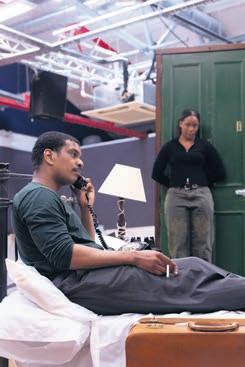
Edinburgh’s Royal Lyceum Theatre hosts Katori Hall’s Olivier-winning play, The Mountaintop (31 May-21 Jun), set at the peak of the American Civil Rights Movement. The play follows a fictionalised Martin Luther King Jr. on the eve of his assassination in Memphis, Tennessee, weaving the mythologised version of Dr King we know today in with the intricacies of human life. The production is directed by Rikki Henry and stars Caleb Roberts and Shannon Hayes. Over at Glasgow’s Òran Mór, A Play, A Pie and a Pint opens the month with Meme Girls (2-7 Jun), a new musical about internet culture and virality. Written, composed and directed by Play Pie Pint regular Andy McGregor, the musical explores what happens to a friend duo when one of them finds herself on the receiving end of the hammer of internet infamy.
Edinburgh-based Icelandic playwright Kolbrún Björt Sigfúsdóttir brings her award-winning new play, This Is A Gift (24 Jun-11 Sep), directed by Sam Hardie, to Pitlochry Festival Theatre this summer. The play is set in Leith and


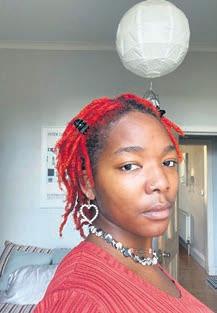
based on the story of Midas. Starring Scottish actress Blythe Jandoo, This Is A Gift explores class, care and the double-edged blade of wishing.
Twenty-five years after playwright Douglas Maxwell’s Tron debut, Tron Theatre presents Maxwell’s new play Man’s Best Friend (19 Jun-12 Jul), directed by the Tron’s artistic director Jemima Levick. Performed by Jordan Young, the play is a solo show about walking dogs, losing them, and finding uncomfortable truths. The play opens at the Tron this month before touring Scotland in September. [Rho Chung]
It’s a bit of a sexy time at Lighthouse Bookshop this coming month: author and literary translator Arielle Burgdorf launches their queer experimental novel Jeanne (5 Jun), Anastasiia Fedorova launches Second Skin: Inside the Worlds of Fetish, Kink and Deviant Desire (17 Jun), and Melissa Febos is in conversation with Dina Nayeri about her new book exploring a year of celibacy The Dry Season (26 Jun). There’s also some great poetry: two launches at Lighthouse (Ilisha Thiru Purcell’s What She Said ft. Jj Fadaka, Zainab Imran and Mymona Bibi, 25 Jun and Michael Mullen’s Goonie, 20 Jun); Loud Poets returning to Scottish Storytelling Centre (13 Jun); and a poetry open mic at Glasgow Zine Library on 11 June.
For more book launches, head to The Portobello Bookshop on 12 June, where Irene Solà will be launching I Gave You Eyes and You Looked Toward Darkness, and on 18 June, where Xani Byrne and Yara Rodrigues Fowler launch the anthology on the joys of cycling, Freewheeling; or to Waterstones Sauchiehall Street, where Glasgow author Gillian Shirreffs launches their novel Elephant. And over at Mount Florida Books, Jen Calleja launches Fair: The Life-Art of Translation (16 Jun) and beloved literary magazine Extra Teeth launch their new issue (13 Jun, find them also at The Portobello Bookshop on 4 June). [Anahit Behrooz]
We’re spoiled for choice on 4 June. In Edinburgh, there’s super-sharp Kate Cheka at Monkey Barrel (8pm) with her debut hour about God complexes, and an upgrade from her Fringe venue last year (a tiny tent by Potterrow). And in Glasgow, you’ve got a choice between Jack Skipper: Skint (The Stand, 8pm) who was our ‘Book Ahead’ tip from last month, or something new from Scottish comedy fave Amelia Bayler with her infectiously catchy musical comedy (Blackfriars, 8pm).
Elf Lyons’ Horses, a top pick from last Fringe clops off in Edinburgh (Monkey Barrel, 6 Jun, 8pm) and Glasgow (The Stand, 7 Jun, 4pm) for another outing of the very first comedy hour performed entirely by a horse. Charming, playful and with a hint of the bittersweet, if you didn’t catch it last summer, don’t miss it on tour.

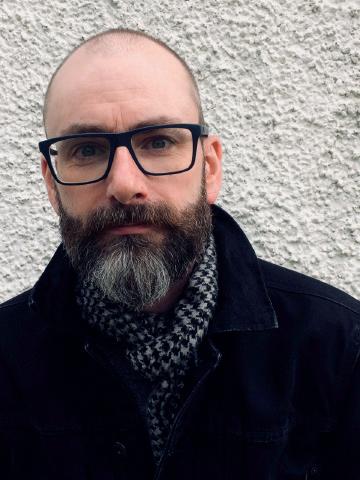

Now for some big hitter WIPs. Twice Edinburgh Award-nominated Janine Harouni swings by Monkey Barrel to work up her third solo hour (14 Jun, 6pm). Expect slick stand-up about family, parenting and marriage. She also comes to Glasgow Stand with Tamsyn Kelly in July too (16 Jul).
We also have local champs Christopher Macarthur Boyd and Josie Long joining forces for a double-header WIP on 18 June (Rum Shack, Glasgow, 8pm), while Ayo Adenekan and Jack Traynor both work up their debut hours in Glasgow Gael & Grain, (21 Jun, 6pm for Jack and 7.15pm for Ayo) and Edinburgh (Dragonfly, 29 Jun, 7.15pm for Ayo and 8.30pm for Jack) together. Those two are presented by Good E Comedy (run by Scottish comic Ross Leslie) who have a fab series of WIP gigs planned this month and next. Full listings on goode comedy.co.uk
Finally, the brilliant Krystal Evans releases her debut novel, The Hottest Girl at Burn Camp, on 19 June, published by Octopus. On the same day, you can catch her in conversation at Portobello Bookshop (7pm). [Polly Glynn]


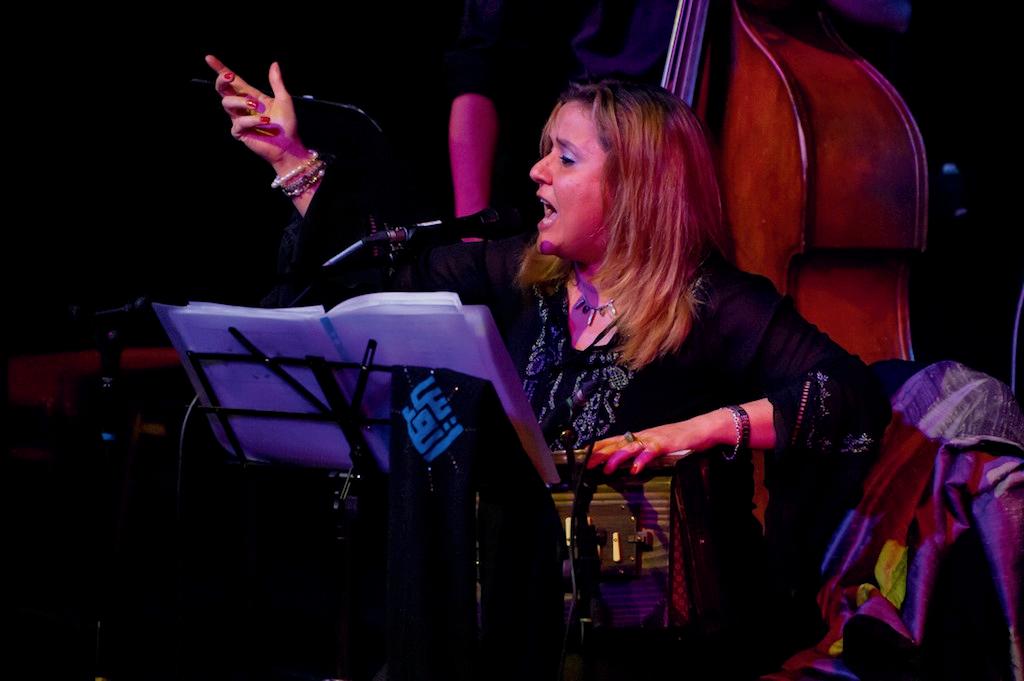





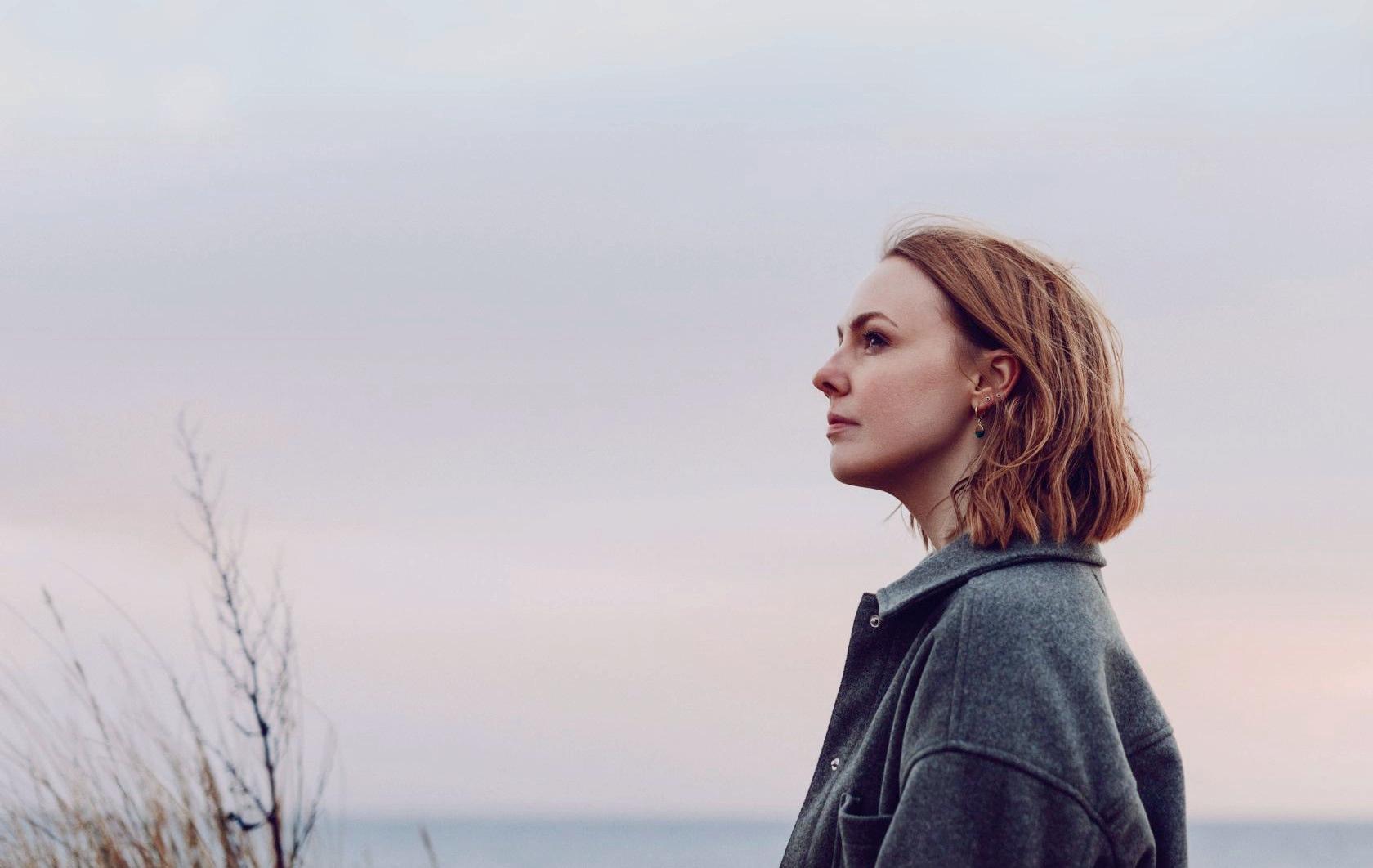


















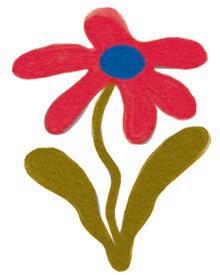



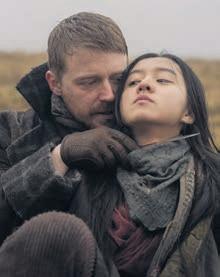



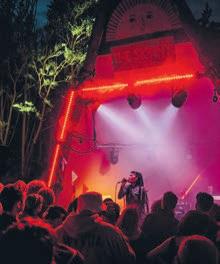
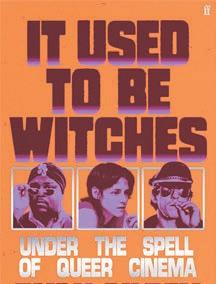

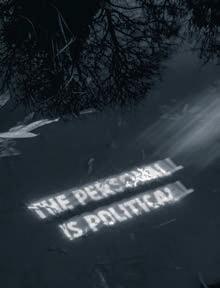
Features
22 Refugee Festival Scotland — we learn about what’s in the programme, and meet Javad Daraei, an Iranian filmmaker whose work is screening in the festival.
25 We meet Ukraine’s Alice Haspyd and Scotland’s Genevieve Murphy ahead of their forthcoming collaboration at Sonic Interventions.
26 Hanna Tuulikki tells us about her new sound-based work which traces the migratory path of the sampling marsh warbler.
28 Katie Goh on their new memoir Foreign Fruit, which uses the symbol of the orange as a potent metaphor for talking about identity.
30 Director John Maclean on his second feature Tornado, a Western set in Scotland centred on a young Japanese woman who’s handy with a samurai sword.
33 Former junior worldwide bagpipe champion CAIN discusses combining Celtic traditions and electronic music on his debut album.
34 We visit Govanhill’s Big Noise, the community orchestra project offering a masterclass in social cohesion.
40 We catch up with award-winning composer and small pipes player Malin Lewis
42 As Kelburn Garden Party gears up for its 15th iteration, we take a closer look at our Pyramid Stage lineup.
47 Ryan Gilbey on his new queer cinema book It Used to Be Witches
48 Looking forward to The Neighbourhood Variety Show, a Glasgow-based community project that celebrates a rich tapestry of local talent.
49 A special 16-page guide to the Glasgow School of Art Degree Show 2025, written by the students themselves.
On the website...
Two podcasts! Our new music pod launches with a chat with Malin Lewis; our fortnightly film podcast The Cineskinny continues with More Talk Re: The Movies. Also, our weekly new music Spotlight! A recap of this year’s Alchemy Film and Moving Image Festival! Our Zap! events newsletter – sign up for that! Oh, and a bunch of gig and theatre reviews!
Kathryn Joseph supporting Mogwai @ Barrowlands, Glasgow, 18 May by
Laura Muraska-Ross

Relocated – roped out (anag) (8)
Renew – brief (6)
Unconscious (6)
Recurring (8)
Mexican music (8)
Permits (6)
Wrote – hemmed (in) (6)
Openings (8)
National – I'm costed (anag) (8)
Excursion (3,3) 22. Perfect society (6) 24. Climbable – resizeable (8) 26. Coriander (in the US) (8) 27. It's rad (anag) – groups of three (6)
Shackle (6) 29. Looking for food (8)
– voyage (7)
Compliance (9)
Subject (5)
Parking (e.g. a boat) (7)
Not yet mapped (9)
Bore – practice (5)
Glasgow arts venue (feat. lovely café) – aw, my art! (anag) (7)
Critic (9)
Travelling on foot – rangy waif (anag) (9)
Al fresco (7)
Discard – set free (e.g. a ship) (4,3)
Unburdened (7)
Steal (5)
Later (anag) (5)
Email crossword@theskinny.co.uk
to page 7 for the solutions
Compiled by George Sully










In this month’s advice column, one reader asks how to tell a friend to move on from a past relationship
How do I (gently) tell my friend they need to get over their ex, who is in a new relationship?
There’s this tweet I think about often (cursed sentence), which goes something like ‘Taylor Swift’s music is for people who have never gotten over anything that has happened to them ever’ (also cursed sentence). I think about it often because, as alienated as I feel from Taylor Swift and her carbon emissions equivalent to those of a small landlocked country, I too have never gotten over anything that has happened to me ever, and I don’t really intend to start anytime soon. I think it lends my life a certain je ne sais quoi, and my bank account a certain deficit in therapy fees, that is both compelling and character building. It’s a bit like being a Greek tragic hero stumbling beneath the weight of the past, except the past is a handful of avoidant exes, a series of erotically charged and emotionally devastating encounters that I recall with the anguish of a Vietnam war veteran, and someone who once said hello to me weirdly in a pub.
Which is to say, really, that I am the wrong person to ask this question of, because I really don’t think you can put a timeline on when and how and why people should get over things. Relationships affect us differently, and love burrows very deep beneath our skin, and being hung up on an ex isn’t necessarily about denial – it’s about processing the ongoing loss of a past that now feels untrue and a future that now won’t happen.
I really understand the impulse to want to fix your friend’s hurts. Obviously if we could all just get over our exes, our lives would be so much happier and the Instagram attachment theory cottage industry would go out of business. But life unfortunately isn’t a narrative, and we can’t skip to the end point of the healing process just because it’s where we should and will eventually end up. If your friend still isn’t over their ex, there is clearly something that they’re stru ling to let go of, an imagination of or attachment to a particular life that won’t quite go away. Maybe sit with them in it for a bit, and see what comes out of it.
Do you have a problem Anahit could help with?
Get in touch by email on pettyshit@theskinny.co.uk, send us your quandaries with an almost-unhelpful level of anonymity via NGL, or look out for Ask Anahit callouts on our Instagram stories
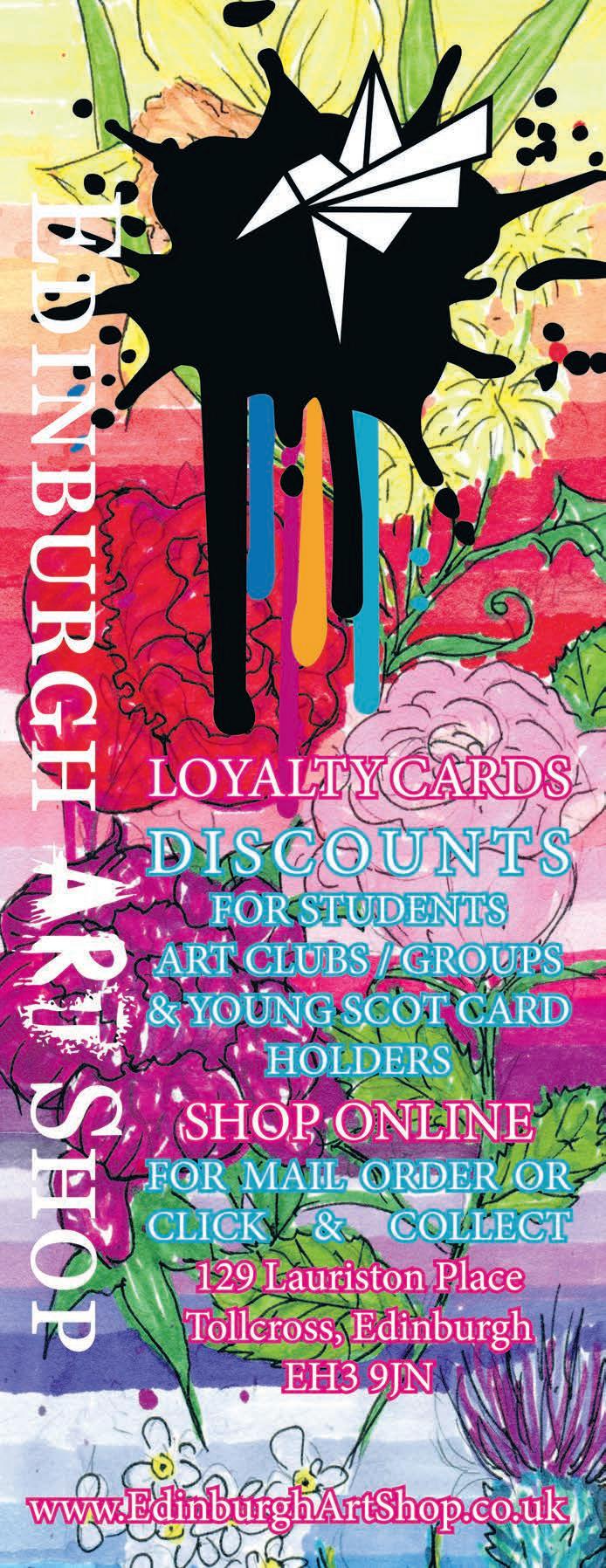














THE SCOTTISH DEBUT JULY 4TH | 2025 “ECLECTIC



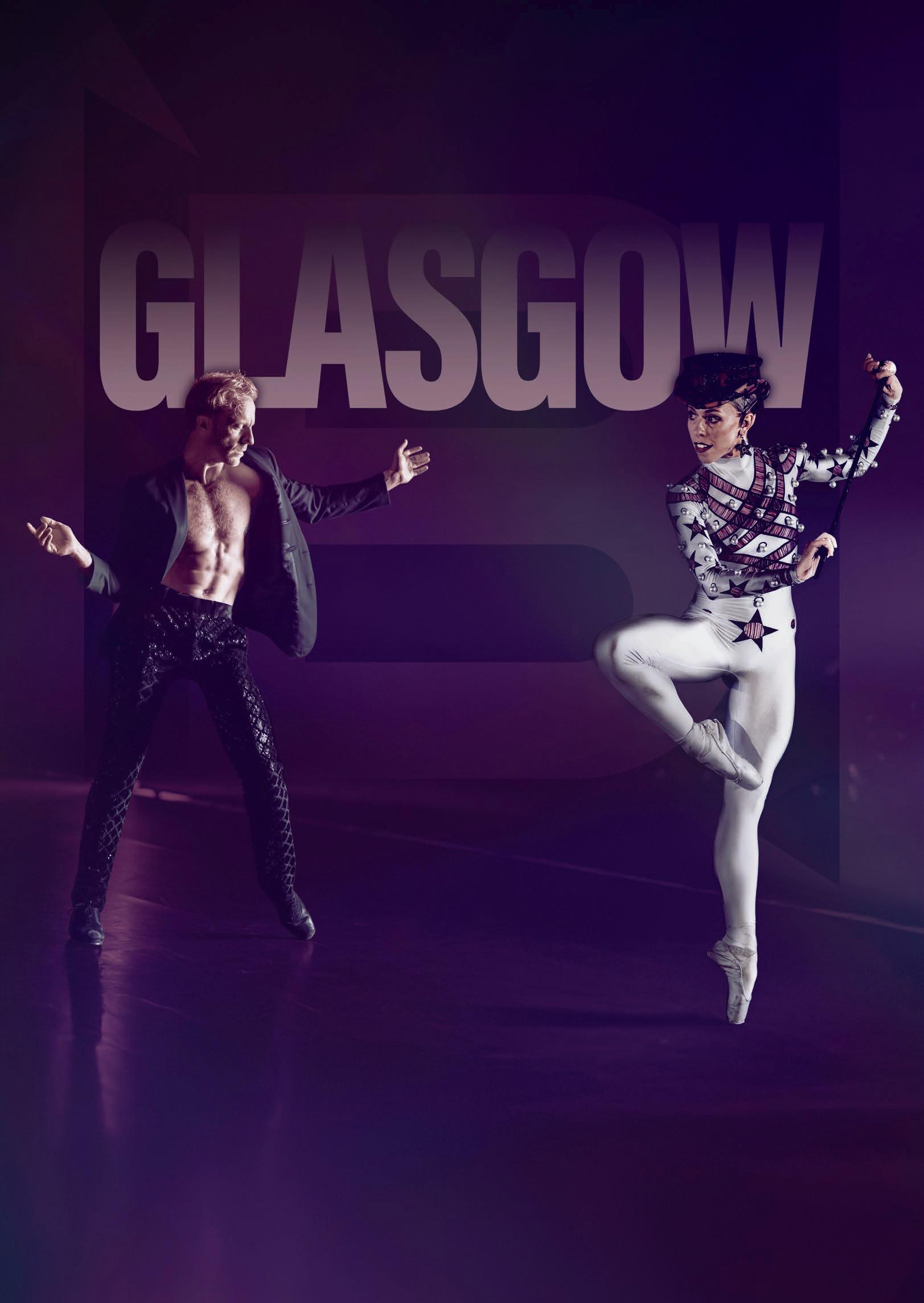
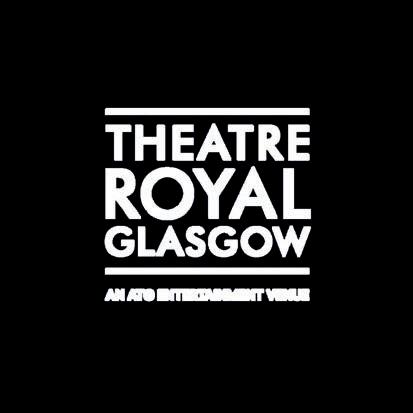
Words: Anahit Behrooz
This year marks 25 years of Refugee Festival Scotland and 40 years since the establishment of the Scottish Refugee Council. It also marks uncountable years of the UK’s inhumane treatment of refugees and immigrants, a tradition continued this year with new policy su estions aimed at limiting immigration even further. In response, we present the Migrations issue, an exploration of the complexity and depth of the immigrant experience and all the ways it shapes and enriches our cultural landscape. From artists presenting work at Refugee Festival Scotland to a gorgeous memoir on the entanglement between citrus fruit and migrant identity, this month is all about the generative possibilities of moving across and beyond borders.

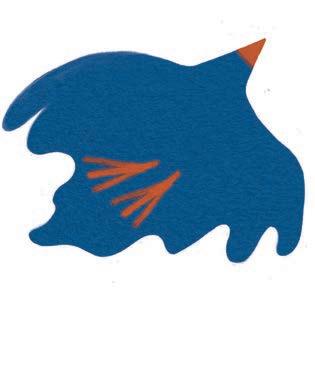

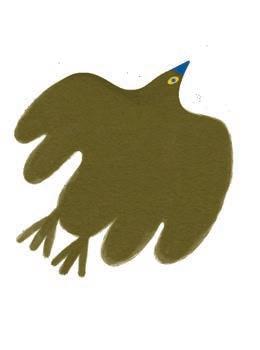
Imeet Javad Daraei mere days after the UK government – under the leadership of a supposedly left party – announces new plans for limiting immigration, including raising skill and language requirements and doubling the timeScotland-based director Javad Daraei welcomes us into his home to discuss Iranian cinema, the refugee experience and acts of defiance
“When you say refugee, it shows a big family around the world”
Javad Daraei
check my dietary requirements; he and his partner have made lunch, a tender act I hadn’t expected but should have, because no one loves offering food to guests more than Iranians. “Please don’t stress too much about feeding me!” I write, a lifetime of being raised in the UK seeping out. “Haha x” comes the reply.
Daraei doesn’t feel like a stranger when I meet him: perhaps he reminds me of my brother a little, or my father, who also left Iran one day and never returned. He swings himself around his flat on crutches, days after a knee surgery to heal injuries sustained at the hands of the Iranian state, and he is unfailingly sweet and friendly, if a little low following his procedure. He and his
Words: Anahit Behrooz Illustrations: Magda Michalak


takes on a horror-style tone as it explores disability rights; his 2021 feature Metamorphosis in the Slaughterhouse tackles the violent mistreatment of women. It doesn’t take much in Iran to be a dissident filmmaker: all films require sign-off from the Ministry of Culture and Islamic Guidance, multiple permits, and have to pass stringent censorship checks. Needless to say, Daraei’s films did not even attempt to follow the rules.
I’m curious how this alters Daraei’s sense of identity, and what it means to be part of a national cinema more broadly. Does he consider himself an Iranian filmmaker? “In Iran you have two cinemas,” he explains to me, “one is independent, underground cinema, and the other is supported by the government. We can’t say one is better [in terms of] technique and knowledge. But the personalities are so different. As a filmmaker, I respect the technique of these filmmakers, but as a person I cannot, because they are a tool of the government.”
In this way, Daraei’s move away from Iran and screening within festivals such as Refugee Festival Scotland makes sense: he sees himself predominantly as “an international filmmaker,” he explains. “When you say refugee, it shows a big family around the world,” Daraei tells me. “Before I felt I had to be a representative of the Iranian people. But now my family… the population is so much bi er.” In the same way that the idea of a singular Iranian cinema has begun to fracture as underground and diasporic cinema takes a stronger hold, the ability of borders to demarcate self-identity begins to collapse when it becomes impossible to feel belonging within the country that is supposedly yours. Daraei is excited to have his films screened at the festival; while they’ve been screened in previous festivals abroad, they never showed in Iran. He is currently working on a new film (having done some shooting in his flat in
Ahead of Refugee Festival Scotland this month, we chat with Esraa Husain, the festival’s Programming Fellow, about creating safe spaces, platforming refugee voices and welcoming communities far and wide
Words:
Eilidh Akilade

Glasgow) that will be his first English-language film, and is also working on a play and novel. His work continues to be political – an act of defiance against the Islamic regime, even when it is so far away – although he is less certain about the ability of art to affect political change.
“I think people are stronger than artists,” he explains, speaking particularly of the Woman Life Freedom movement in 2022, and the mass dissidence of the Iranian people. “I saw a lot of artists easily changed [by the government], but the people – no. The people fight and they won’t be changed.” Does this change how he feels about filmmaking? “I don’t want to say that a filmmaker can change everything,” he says. “But for me, it’s enough to record the life I’m living and the world around me. Whether it leads to change or not, I’m happy to tell these stories.”
He pauses, frowning. “You haven’t eaten,” he tells me. I think of the white paper again, and what it means to be a stranger, and the quiet, determined intimacy of feeding people and giving voice to your silenced community and seeking to connect to the world through every means possible. Here, in the heart of Glasgow’s migrant neighbourhoods, Starmer’s island of strangers feels like a strange joke. I pick up my spoon.
“I’ve never believed in seeing this work as a competition; it’s more of a collaboration,” says Esraa Husain, a creative writer, facilitator, community organiser, researcher and, this year, Refugee Festival Scotland’s Programming Fellow. In recent months, they’ve collaborated with the festival’s small but mighty team to deliver a programme of events which celebrates and connects refugee communities across Scotland, from 13 to 20 June.
This year’s festival theme, Milestones, speaks to the 40th anniversary of Scottish Refugee Council and the 25th anniversary of Refugee Festival Scotland. For Husain, this year also marks ten years of their living in the UK. “It means so much to me to find community here and establish a network and feel more at home and at ease,” they say. Husain’s programme, Building Solidarity and Kinship, consists of five events, spanning in-person and online spaces. With film, poetry, movement, performance, discussions and community meals, the programme offers something for everybody. In particular, they’re looking forward to a poetry reading event at Listen Gallery and short film screenings at Glasgow Film Theatre and Eden Court.
“It gives us a sense of agency. It makes our voices heard.”
Esraa Husain, Programming Fellow
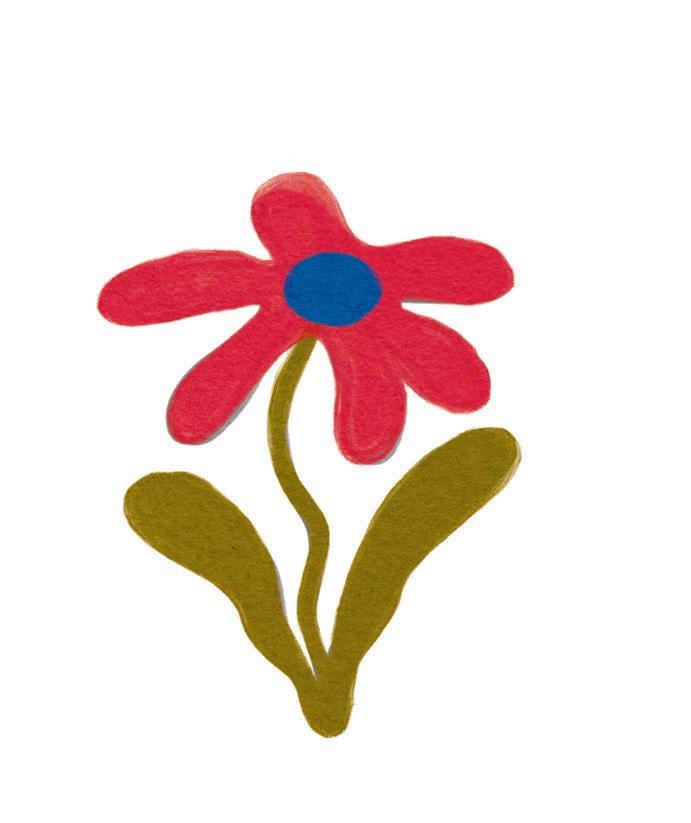
“I think that language of Building Solidarity and Kinship is a language that I’ve been navigating and exploring and understanding for years now, especially moving here from the Global South, and moving around different cities, different countries... It’s something that’s very integral to my experience of movement and displacement,” they say. Currently completing their PhD on Black – another milestone for Husain – they’ve found this solidarity and kinship arise within their research time and time again. “They [Black Scottish writers] became more than just research, just academics. They became part of my practice.”
Refugee Festival Scotland takes place across the country and Husain’s programme is no exception. Previously living up north, Husain was keen that their programme reached far and wide. “Based on my experience, I noticed that there are special barriers and a special sense of isolation when you live in the north and the Highlands... the cities and the communities are smaller, also in terms of transport,” they say. There’s a common misconception that refugee communities – as well as migrant communities and communities of – solely find themselves in Scotland’s Central Belt. In reality, Dundee, Aberdeen and
Inverness are also home to growing refugee communities. “I know we are there and we are everywhere – the communities who come from migrant backgrounds are everywhere.” The festival’s access provisions also speak to the diversity of the refugee experience: this year, for the very first time, the festival will have BSL interpreters and a Wellbeing Officer while an online event in Husain’s programme opens the door even wider.
For Husain, it’s crucial that individuals feel welcomed and supported when attending – after all, Refugee Festival Scotland is a festival for and by refugee communities. “I want them to know that it will be enough for them just to be there and share their presence. And I hope that it’s not going to be demanding in any way,” they say. Husain is also keen that the festival encourages other individuals to pursue their own hopes and interests. Last year’s Programming Fellow, Huss Al-Chokhdar – a queer Arab multidisciplinary artist and programmer – inspired Husain to apply for the role this year. Attending the festival saw Husain make connections within and outwith the community; they’re excited to offer such opportunities to audiences this year.
With the offer of event guidelines and funding opportunities, refugee-led groups and refugee support organisations are invited to contribute to the festival through hosting their own events. As such, the festival isn’t purely curated by one centralised programme team; rather, it’s reflective of and driven by the community’s wants and needs. “It gives us a sense of agency. It makes our voices heard.”
In curating their programme, Husain has sat with the weight of our current socio-political climate. “It comes with a responsibility, and with a lot of ethical questions,” they say. Last summer, we saw racist riots; only last month, Keir Starmer announced a terrifyingly hostile immigration policy. “People’s rights are under threat. The political environment that we’re in is very scary and can be very hostile,” says Husain. This threat is increasingly present for disabled, queer and trans refugee individuals amid the UK’s continued legislative attacks upon such groups. Community is more important now, than ever.
“It’s very challenging to find that balance between not just pumping the traumas and the pain, but also at the same time celebrating us and celebrating our talents and skills and what we have to offer,” they say. There is, indeed, a lot to celebrate – but the festival is keen to offer audiences solace in trying times, as well as joy. As Husain notes, “It’s a work in progress.” And it’s a work we can progress together.
Refugee Festival Scotland runs from 13-22 Jun across Scotland
More information & tickets available at refugeefestivalscotland.co.uk/







WEDNESDAY 11 - SUNDAY 15 JUNE
Turnhouse Road, Edinburgh

5 days, 100s of artists, 1 huge abandoned industrial site
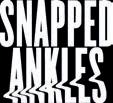




















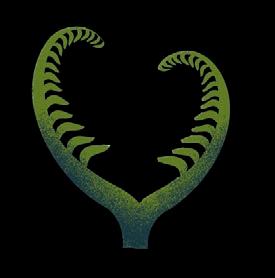

hiddendoorarts.org #HiddenDoor2025



Opening reception: Friday 6th June, 7.00pm - 9.00pm
Opening Hours:
Monday 9th June: 9.30am - 4.30pm
Tuesday 10th June: 9.30am - 4.30pm
Wednesday 11th June: 9.30am - 4.30pm
Thursday 12th June:10.00am - 7.00pm
Friday 13th June: 9.30am - 4.30pm
Saturday 14th June: 9.30am - 4.30pm




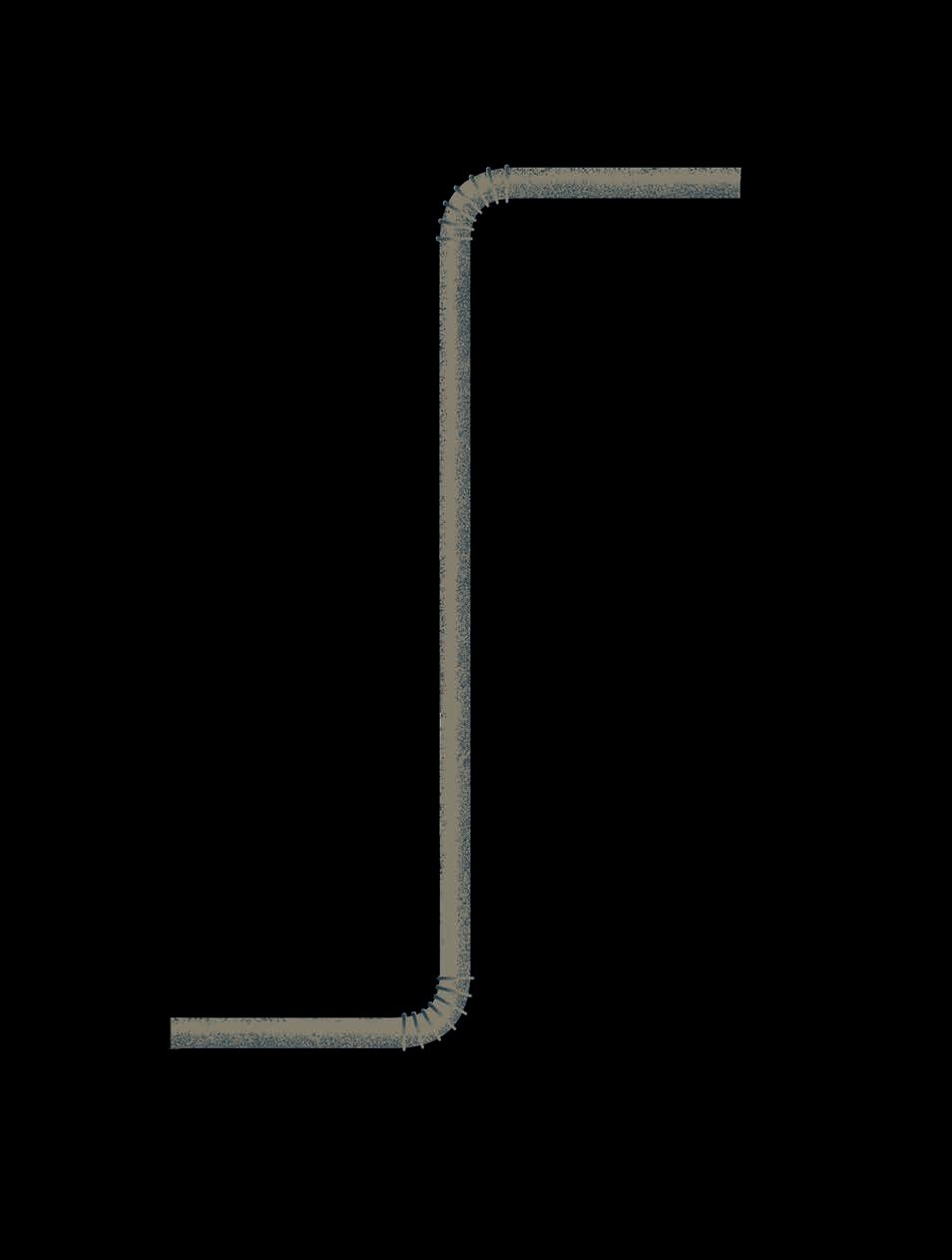

Ahead of their forthcoming collaboration at Sonic Interventions this month, we catch up with Ukraine’s Alice Haspyd and Scotland’s Genevieve Murphy to find out more
“Ukraine suffers difficult times of depression at the level of millions of people. Art, music disappears. Producers who we recognise in the world are going to war. We need to continue to support the scene in Ukraine as long as possible.”
These are the words of Alice Haspyd, an experimental artist from Ukraine whose audiovisual work has been on show at festivals and galleries across Europe. Like all Ukrainians, her life and artistic practice is in a state of constant flux due to the ongoing Russian war in Ukraine. As this piece is written, Haspyd’s hometown of Odesa has been the subject of yet another drone strike by Russian forces.
“We have to choose the right to sing and be on occupied lands”
Alice Haspyd
The old cliché of stru le producing good art is not valid when you are paralysed by war. “As Ukrainians, we love to philosophise that we cannot feel the influence of war,” Haspyd writes via email. “But as long as you are here, you are feeling [it]. We feel different, try to smile and see happiness. As for me – the pleasure of silence on quiet days, the onset of spring is a miracle every time, even if the seasons have been going on for years. We all have changed a lot, but this is its beauty and strength. This experience is not [one] to repeat or simulate.”
Her call to action to support artists in Ukraine has been matched in a small way by the upcoming Sonic Interventions, a series of performances and installations of experimental music and sound art that will take place across Glasgow venues in June. The programme was conceived by Olha Bekenshtein, founder of Time Based, an organisation created to promote the work of Ukrainian musicians, sound collagists and artists. The lineup matches UK- and Ukraine-based artists, emphasising collaboration and the importance of cross-cultural exchange. Scottish artist Zoë Irvine has worked with media collective Photinus Studio to map and remix the sonic landscapes and natural habitats of Ukraine and Scotland, while Ukrainian artists and performers Anna Khvyl and Piotr Armianovski will engage slightly differently by leading a ‘sound walk’ ending at the Glasgow Women’s Library.
From discussions with Haspyd and her collaborator for the programme, the classically trained musician and performance artist Genevieve Murphy, what comes out of these impromptu pairings will be the result of the artists’ process
together. However, Time Based has emphasised themes of dissent, solidarity and art in the face of a ression. Haspyd and Murphy are still putting together what will be a live performance piece when we speak, a collaboration that has bloomed remotely online, with Haspyd in Ukraine and Murphy between Scotland and the Netherlands.
“I’ve never had an experience like the one Alice is having in Ukraine,” says Murphy. “But I want to find a way to channel what Alice wants to communicate. The thing with music is it can be abstract, and maybe through this collaboration there can be this sort of abstract world that gives the audience a feeling of the complexity of working with somebody that is in a very emotionally profound situation.
“I don’t think art can change the world,” Murphy continues. “But the opportunity to convey your art can feed your identity. For a Ukrainian artist, maybe war seems like their whole identity just now. Whereas if they can stand there and give their art, they’re actually showing they have a voice which is unique to that person. And that helps us to connect even more. That’s where empathy starts. Sometimes if you only look at the big picture, people as a mass you put within a certain category, you don’t really learn about individuals, and some people don’t find the empathy there. But being given an opportunity to learn about a person is a powerful thing [art can provide]. I feel happy that I can share that space.”
Words: Tony Inglis


The Sonic Interventions programme seems to want to create the connections Haspyd and Murphy mention, but also empower its participants to feel like they are a part of collective action. Geopolitics seems far away from an arts festival though, and it is not something that has been easily afforded to people in other parts of the world, whether that be those afflicted by the Russian war in Ukraine, the civil war in Yemen, or the ongoing genocide of Palestinians by Israel.
In her missive, Haspyd understands that as much solidarity as some in the west may be willing and able to provide, often people experiencing conflict and a ression are, shamefully, left to fend for themselves.
“Music as one of the greatest manifestations of art is the voice of all Ukrainians,” emphasises
Haspyd. “We have to choose the right to sing and be on occupied lands. Our music must play there and be our language. If you sit and stagnate the enemy slowly destroys your values and culture. It is a mass stru le at all levels. We have to shout about our freedom because no one will do it for us.”
Genevieve Murphy & Alice Haspyd perform at Civic House, Glasgow, 11 Jun as part of Time Based: Sonic Interventions, which runs across various venues in Glasgow, 11-15 Jun
Time Based: Sonic Interventions is funded by the British Council’s International Collaboration Grants, which are designed to support UK and overseas organisations to collaborate on international arts projects
Ahead of the Folkestone Triennial, Glasgow-based artist Hanna Tuulikki tells us about her new sound-based work which traces the migratory path of the sampling marsh warbler
“The marsh warbler is an extraordinary bird,” says artist Hanna Tuulikki. “It’s a small migrating bird that breeds in Northern Europe, and then it migrates through the Mediterranean, through the Balkans, through the Middle East, right down through East Africa – some over winter in East Africa – and then some go right down to South Africa, which is an incredible feat in itself.”
Tuulikki’s love for the marsh warbler has nested itself in this year’s Folkestone Triennial, an outdoor contemporary art festival based in Kent. Curated by Sorcha Carey, Director of Collective in Edinburgh, this year’s iteration is titled How Lies the Land?, taking place from 19 July to 19 October. Through the lens of deep time, the festival explores the land’s pasts and imagines its futures. For Tuulikki, the marsh warbler offers a route to fly between the two.
“What’s amazing about the marsh warbler is that it composes its song entirely from mimicry, from imitations or samples,” says Tuulikki. In the 1970s, Belgian ornithologist Françoise DowsettLemaire found that the marsh warbler was imitating species along its migratory path, emerging as an audio travelogue of sorts. Mimicry – in its many forms – has long been a focus of Tuulikki’s soundbased work. “I define that [mimesis] as a practice of becoming-with, so the imitation or the emulation of more-than-human sound or movement within the human body, or with the human body, as a practice of making kin as a way of fostering empathy.”
Such empathy is key in Tuulikki’s research on Kent and its relationship with migration. With some migrants forced to enter the UK via crossing the Channel, the county is often held as a focal point from which right-wing media launch violent attacks upon migrants themselves. Politicians with similar motives have capitalised upon this rhetoric, thereby creating and exacerbating divisions within the community. In this, a history of defence within Kent persists: nowadays, disused military watchtowers and sound mirrors – made to detect enemy aircrafts – find themselves along the coast.
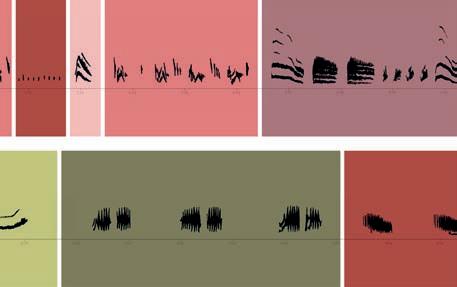
Like all birds, the marsh warbler is no stranger to defence. “There’s two main reasons why scientists say birds sing: to find a mate and in defence of
Words: Eilidh Akilade
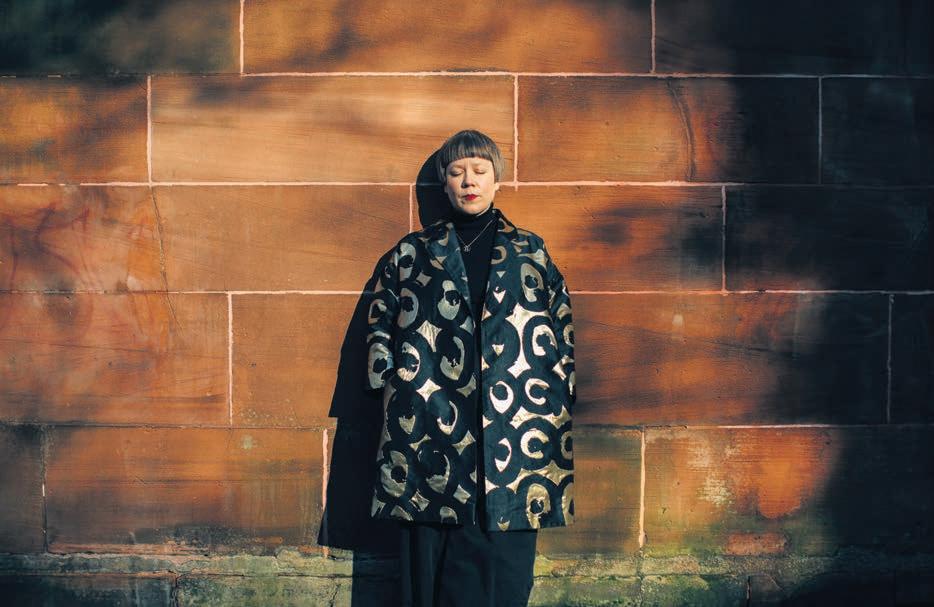
“What’s amazing about the marsh warbler is that it composes its song entirely from mimicry, from imitations or samples”
Hanna Tuulikki
territory,” says Tuulikki. “And I was really interested to remix these ideas and think about territory – not as a place of defence or a place of natural selection – but territory as a place of encounter.”
Collaborating with musicians across 27 nations, Tuulikki has collected songs from each territory along the marsh warbler’s migratory path. “It’s been such a word-of-mouth thing – one person leading me onto the next person and the next person,” says Tuulikki. These songs have been remixed using the marsh warbler’s song structure, based on a seven-and-a-half-minute audio-recording of a marsh warbler taken by Tuulikki’s collaborator Geoff Sample, which has been extended to its human scale of roughly 21 minutes. “This composition is the imagined song of a speculative human avian hybrid.” Nowadays, the marsh warbler no longer resides along the Kent coast; Tuulikki’s composition, then, will be something of an imagined homecoming.
Love songs emerged as a natural note to follow. From the romantic to the familial, Tuulikki’s collected songs span the great breadth of love. “What’s really striking is some of the shared themes that are emerging in the love songs, both lyrically and musically,” says Tuulikki. After all, we’re both migratory creatures: marsh warbler and human alike. “You can really feel the connections along this migration route.”
But no single song is the same. The composition will be mixed live with microphones positioned at the sound mirrors, collecting and reflecting each day’s unique rhythms and melodies. Audience members will listen to the composition in one of Folkestone's military watchtowers.
“It’s a very gentle, playful work as well,” says Tuulikki. Indeed, the artist is keen to connect with audiences – whether local or from further afield – and invite their own questions and ideas. “It’s not dictating how we should be in the world. It’s really open and it’s made with love.”
The festival will see Tuulikki spread her wings in a number of performances, wearing a 1940s military aviation suit made complete by fabric printed with a visual score of the composition. Tuulikki’s composition will reshape itself yet again as she activates the sound mirrors with her own voice.
In her research, Tuulikki has learned a great deal from the marsh warbler and its travels; she’s excited for others to share in this joy. Through migration, we connect with others; and, if we’re lucky enough, we might pick up a song or two.
The Folkestone Triennial takes place from 19 Jul to 19 Oct creativefolkestone.org.uk/folkestone-triennial/





We chat with Edinburgh-based author Katie Goh about their debut memoir Foreign Fruit, and why the symbol of the orange is a potent metaphor for talking about identity
When reflecting upon issues like globalisation, colonialism, and migration, as well as personal concerns such as familial lineages and racial identity, citrus might not be the first thing in most people’s minds. But as Katie Goh proves in their new memoir, Foreign Fruit, the roots and branches of humanity are more entangled with the history of the orange than one might readily assume.
In the prologue of the book they write: “The morning after a white man murdered six Asian women, I ate five oranges.” This moment prompted the introspective and literal journey which would later sprout their memoir. The eating of fruit as an emotionally significant response to violence first became the opening image of Goh’s essay Oranges in Extra Teeth Issue 4, in which they reflect on new ways of writing about identity. The idea would take root, grow too large to be contained in a single essay, and eventually become Foreign Fruit
When asked to tell us more about the origin and the writing process behind this project, Goh explains: “I have been a journalist for a long time. I got into journalism by doing a lot of personal writing about myself and my identity. People really wanted opinion pieces on what it’s like to be a mixed race woman, a queer woman... This sort of writing feels like packaging your identity up in neat parcels, and I was getting really burnt out doing this. It got to the point, during lockdown, when there was a lot of anti-Asian violence and [I was] being bombarded by that in the news, and I feel like I just broke. I thought ‘I’m not doing that anymore’, and decided to find a different way of writing about my identity.”
"I can't just go somewhere and feel like I found my people or found myself. We create these narratives to give ourselves some comfort, but identities are not static, they are living things"
Katie Goh
What they found was sitting right in front of them: a literal bowl of oranges on the table. Soon it
seemed to be everywhere else too, from plastic bottles of juice concentrate in modern fridges to open-air markets along ancient Silk Roads, as well as other, more unexpected places. The research Goh began conducting for their original essay proved the orange to be so ubiquitous in history that the citrus became the central motif of their book. “I started reading about these different significant moments in time, and the orange just kept popping up,” they say. “For example, in [Foreign Fruit] I write about this awful massacre that happened in LA in the 1800s, where many members of the Chinese community were attacked by white citizens. I was reading a book about the tragedy and found something I didn’t know before: that when these people were hiding from the mob, they hid in the orange groves around LA.”
Goh makes it clear that citrus fruit is not only seemingly omnipresent, but its impact can hardly be overstated – the world would look very different without it. “The sailors who were travelling from Europe to colonise lands might not have been able to do that without citrus,” Goh explains as another example of the unexpected ways in which fruit played a fundamental role in history. “They would get scurvy from lack of vitamin C and die, or be forced to go home. Something like an orange or a lemon is the reason why the world is shaped the way it is.”
Looking into the history of the fruit itself also offered many insights, its significance and connection to the author’s life becoming increasingly apparent. “The orange is a hybrid fruit that has two different parent plants [a product of botanical grafting], and its meaning and symbolism has changed as it moved across the world in different times,” Goh explains. “It’s both a real fruit that has had a real impact in the world, and also a symbol that has had all these meanings and metaphors bestowed on it.”
This duality became a fertile ground for the author’s vision. “For me, the orange became a metaphor for mixedness and hybridity,” they elaborate. “It comes from China, but it’s moved across the world in a way that follows my own family history: moving from Asia over to Europe. I kept reading about it and realised that it could be a neat entry point to write about big issues I had been trying to grapple with for a long time. So I let the orange guide where I wanted to take the story. It became a really useful way of structuring the messiness of writing about what it feels like to be a person in the world right now.”
More than just a memoir (and Goh’s success at finding an innovative way of writing about their personal history and identity), Foreign Fruit is an impressively well-researched document chronicling centuries of human (and plant) migration, exploitation, violence and ultimately perseverance. “If I’m writing about myself, I need to write about the world as well,” Goh explains. “I don’t think there’s a rigid
Words: Venezia Paloma
boundary between me and other people, or history and the future. I am Irish, Chinese, my family migrated from China to Malaysia at a time when it was under British occupation. I feel like there is so much history in a lot of parts of my identity, and if I was wanting to write about myself, and especially about my family and my heritage, I had to write about things like colonialism and migration. We are all creatures of our circumstances, so if I didn’t write about the wider history around it, then it wouldn’t be authentic.”
Of course, such a task can be incredibly daunting. “I was unsure when I started writing,” they confess. “[I had] a lot of anxiety around it, thinking ‘why am I writing about this?’ ‘Am I the right person to do it?’ I had to let go of the idea of having a completely neutral or balanced way of looking at history. Instead, [this book] is my experience of it, my perspective.”
“The sailors who were travelling from Europe to colonise lands might not have been able to do that without citrus”
Katie Goh
The construction of a personal narrative and myth-making in general are important themes in Foreign Fruit. “Humans are storytelling creatures. It makes sense that we would turn our past into stories, and then pass [those stories] on to different generations. It creates a sense of belonging, but I think it also has the potential to be very dangerous if you don’t let other perspectives or any other myths into that narrative,” Goh says. “For example, growing up in the North of Ireland, being educated in the British system, we weren’t taught in school about slavery or colonialism. Many people think of the British Empire as a uniquely positive thing, completely ignoring all the death and suffering it caused. Mythologising history can be very reductionist.”
Similarly, personal myth-making is rarely straightforward. “When I was a kid I would really romanticise China,” Goh recalls. “I felt like I didn’t belong to the place where I was growing up and thought that if I could just go to China, everything would be fine. I did have the privilege to go when I was a teenager – as I write about in the book – and it was not that romantic vision I had. I loved meeting my family and seeing the places of the stories I’d heard, but there was no sense of a great homecoming. It was just people living and they didn’t
really know me. I think it was a very important thing for me to experience because I realised I can’t just go somewhere and feel like I found my people or found myself. We create these narratives to give ourselves some comfort, but identities are not static, they are living things.”
The metaphor then goes full circle. As Goh observes: “The orange as we know it has been cultivated over many, many years, to taste perfect, to look perfect, and to appeal to our senses. History has created the fruit the way history creates people.” Sometimes through natural programming, other times as the result of violent dynamics, both human and fruit are constantly transformed by their environment, and in turn transform each other. About the way Foreign Fruit explores this entangled web of connections, Goh adds: “I wanted to dissolve the border between nature and humans, to write about feeling the weight of history propelling all of us forward, and everything that had happened in history dictating what the future will grow into.”


It’s been ten years since John Maclean burst onto the movie scene with his stylish Western Slow West. His second feature, Tornado, is another Western riff, this time set in Scotland and centred on a young Japanese woman who’s handy with a samurai sword
The opening text of Tornado informs us that its events take place sometime in 1790s Britain. But don’t be braced for bonnets and corsets: this is not your typical Georgian-era costume drama. It’s the second feature from Scottish director and Beta Band alumnus John Maclean, and like his knockout debut, Slow West, from 2015, it’s a fat-free, earthy example of a genre rarely made on these shores: a Western, albeit one with much influence from the East.
“When I made Slow West, no one was really making Westerns, especially not as their first film,” Maclean tells me when I ask him about his penchant for oaters. “So it felt like something quite unique.” It was also an excuse to explore a topic he’d recently been absorbed in: migration. “I’d become very interested in America, and particularly in Scottish people going to America, so I started thinking of a Western that would feature American immigrants.”
That earlier film concerned a lovelorn Scottish teenager (played by Kodi Smit-McPhee) travelling across the heartless plains of Colorado to find the woman he loves. Tornado switches the dynamic: its hero, the title character Tornado, is a Japanese teenager (played by newcomer Kôki) travelling with her father (Takehiro Hira) through a pitiless, almost mythic Britain, where they eke out a living through their marionette show about an avenging samurai warrior. The film opens in the heat of action, with Tornado running across a desolate landscape pursued by a criminal posse led by Sugarman (Tim Roth) and his son Little Sugar (Jack Lowden), before flashing back to earlier in the day to reveal what incident caused her predicament.
The igniting spark for Tornado’s script was Maclean’s love of Japanese cinema. Not just the samurai films of Akira Kurosawa, like Seven Samurai and Yojimbo, which Maclean pays homage to throughout Tornado, but Japanese cinema of every stripe. “I’d been getting into all sorts: Onibaba and Women of the Dunes, Mizoguchi films and Ozu films, everything from the 1920s to the 70s basically. But I didn’t want to make a Japanese film, because I’m not Japanese, so I struck on bringing a Japanese character to Britain.”
Tornado was shot in the Pentlands, but Maclean intentionally keeps the location hazy. “It could be the Yorkshire Moors, or it could be Cornwall, or it could be the Lake District, or it could be the Highlands,” he says. “I wanted to comment on the multicultural nature of early Britain; I wanted it to be a Britain full of all different kinds of people – a Japanese samurai, a French weightlifter, an African bandit. And I think if I’d been more specific about where it’s set, I might have lost a bit of that power.”
Words: Jamie Dunn

While the world of Tornado feels almost mythic, the wants and needs of the people inhabiting this world are pretty simple: they’re just trying to survive. It feels like an antithesis to the buttoned-up emotions and petty concerns of the stately costume dramas that are a staple of UK cinema. “I wanted to stay away from kings and queens and the politics of the day, and even class to an extent,” says Maclean, “although I think class seeps into everything everyone does.” He wanted to create an anarchic atmosphere similar to Sergio Leone’s spaghetti Westerns, which, like Tornado, were also heavily indebted to Kurosawa. “I just felt that surely there were wild times here,” says Maclean. “Surely, 1790s Britain had the same kind of lawlessness as perhaps 1860s America did.”
The landscapes of Tornado certainly add to this feeling of lawlessness. Maclean shot the film in January last year. Not the ideal point in the calendar to make a film in Scotland, but at the time it felt like “now or never” for the director, who’d been trying to get the film financed since 2018. “I just seized the chance, even though it got dark at four or five o’clock, which is quite mad when you’ve only got 25 days to shoot a film,” he says. The production was gruelling – “we had to work so fast, like crazy fast” – but the time of year
did have some advantages. “On the plus side was, it’s winter, so it doesn’t all look like a golf course, you know? You get this ru ed look, and it’s full of rough browns, and it’s got the Scottish weather – we had a weather machine on set, but we hardly used it because the wind rarely let up.”
This landscape might look familiar to fans of The Beta Band. Maclean shot a video in that same spot with his former band for the song Trouble around 25 years ago, and it turns out there’s a personal connection to the location. “I set the video there initially because that’s near where our drummer [Robin Jones, who also moved into the movie business, and is the art director on Tornado] is from, so it just made absolute sense to go to where he knows, and use the same location.” That short was also a samurai flick, a mini-action epic about a kilt-wearing samurai out for revenge. It features an assassin who’s deadly with a fishing rod and a death by sgian-dubh, plus copious splurts of blood that shoot across the screen. “It was sort of my first attempt at a samurai film,” laughs Maclean. “It was more influenced by Shogun Assassin, maybe, so it’s slightly more superficial, but yes, it laid the groundwork.”
Tornado is released 13 Jun by Lionsgate


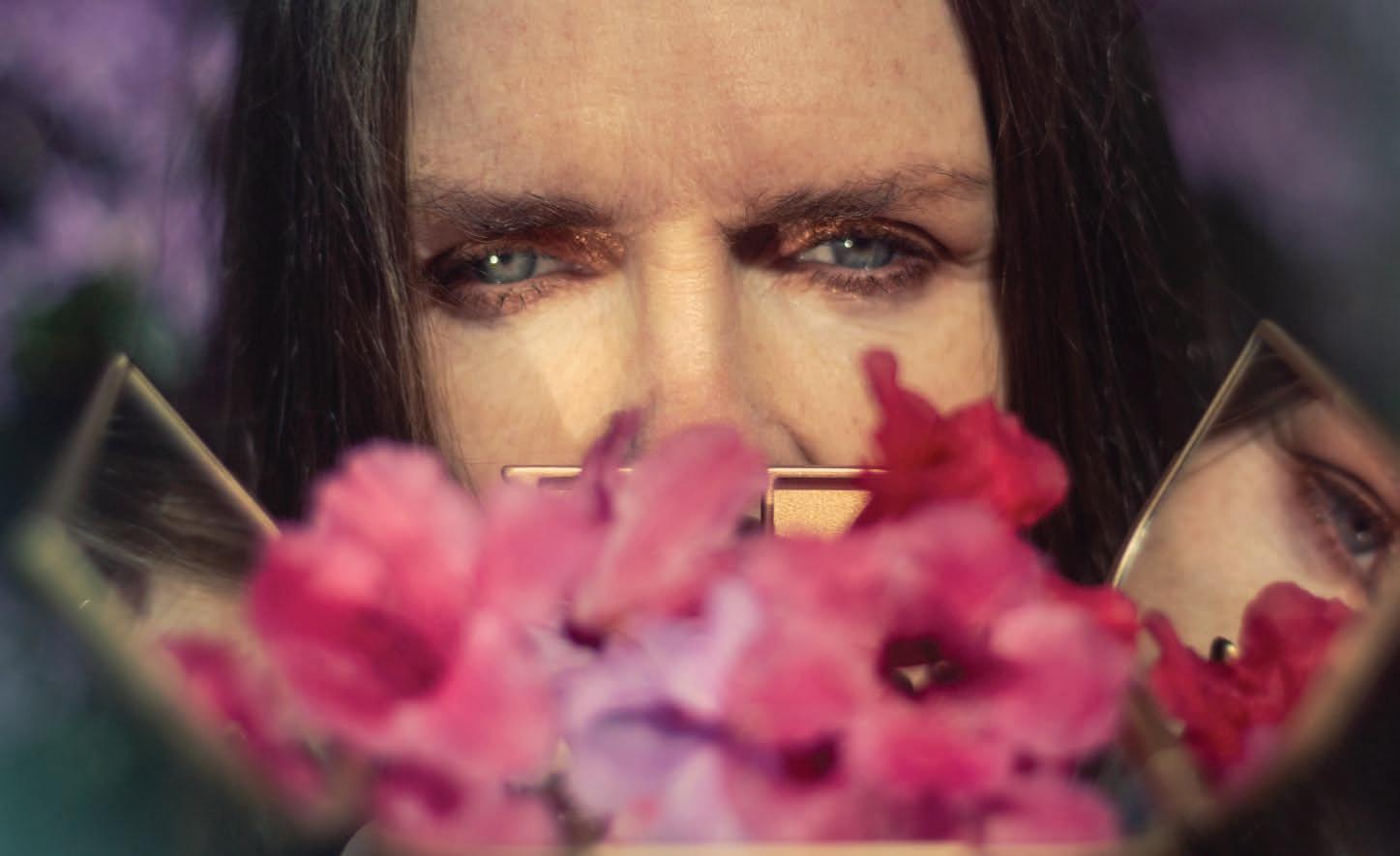


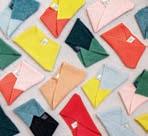

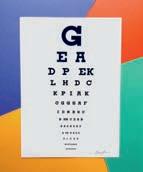


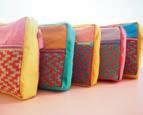

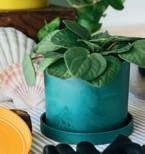
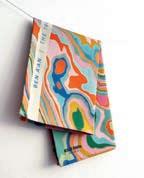
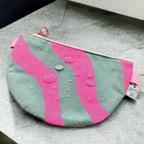
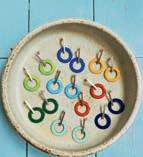











Decades after being crowned the junior worldwide bagpipe champion, CAIN combines Celtic traditions and electronic music on his debut album
Celtic traditions and electronic music culture haven’t historically crossed paths, particularly for CAIN – the dance music alias of Duncan Grant – a bagpipe prodigy who sna ed the junior world championships as a teen. After determinedly dropping a string of work soon championed by Ben UFO and Gilles Peterson, he hung up his sporran and hit the European club circuit. Over a decade later, the Highlander’s debut album Lineage arrives on 19 June, championing Celtic musical traditions beyond the ceilidh session.
The Skinny: How have you been spending time since wrapping your debut album?
CAIN: My full-time day job is in London with the National Youth Orchestra, so I’m always trying to balance writing tunes with that. But I’m currently prepping for a show at Glastonbury with my bagpipe MIDI controller.
A bagpipe MIDI controller?
It’s this thing called a Blair chanter. It’s basically a bagpipe chanter but has all these light sensors, and you can plug it into any synth and control any sound you want with it.
Probably not something you see much in London. It’s funny... Since living in London, I’ve felt more Highland than I ever did back home. I think because the city is such a melting pot, you naturally end up talking about your own culture more here.
What was the culture like growing up at home?
I’m from Errogie on the south side of Loch Ness, so every summer, I was rolled out as the kid piper at the Abernethy Games to pipe in the chief, and afterwards I would listen to hip-hop records in the evening. It was frustrating because it felt like the people in each of these scenes didn’t understand what I loved in the other... it was like two separate worlds.
How often do you play the pipes now?
Pretty much every day... If you grow up doing something all the time, it just becomes part of your identity, so it feels weird not to be doing it. I feel guilty if I haven’t had a tune that day, you know? Like I’ve done something wrong. It’s just kind of instilled in me – my dad was a piper.
What does he think about the album?
I think he’s still scarred by me stopping competitions, so he tends to be quite dismissive and doesn’t really listen properly, which is frustrating. It’s one of those lifelong quests to impress your dad kind of thing, but I think he’s gradually coming
around to it, particularly because I was working with Celtic musicians like Brìghde Chaimbeul, who wrote a tune for him when she was 13.
That’s quite the full circle moment. Why did you wait until now to merge the two styles?
In a way, I had a desire to do something like this before I even wrote any music, but I just didn’t know how until now. I wanted to work with Gaelic music traditions but present them in the style in which I write music as CAIN. I’ve worked with African and Indian artists in the past, and they have amazing musical traditions, so with this album, I want to show people the musical traditions that I grew up with.
What do you think about the purism argument?
There’s a balance between keeping musical traditions alive and learning that they constantly evolve. If you look at music forms from areas of Africa, like batida and kuduro and Angolan sounds in Lisbon versus the global popularity of more Ghanaian and Nigerian style Afrobeat, it’s very much a living tradition, isn’t it? There is a space for Celtic purists, but there’s also space for the tradition to interact with Puerto Rican re aeton rhythms and see what can come out of that meeting point – it’s exciting.
Words:

Why do you think there’s a lack of music sampling Celtic sounds globally?
The problem I felt I was up against was that it’s relentlessly pigeonholed as chirpy and upbeat. You know, you can mix an upbeat jig with a house beat, and it sounds pretty cringey, but that’s missing 90% of Celtic and Gaelic music.
How did you differentiate between these styles in the album?
I wanted to make something about the feelings of different landscapes in the Highlands, and if you think back to the clan days, they each had their
own idiosyncrasies and ways of living off the land. I think it’s interesting to think back to what it would have been like in the 16th or 17th century and what part you would have played in this long line of traditions. That’s why I called it Lineage
What part do you want to play in the lineage? I want to be an ambassador for Highland music and to show it’s more than just a cliché. The population of Inverness is going up – but mainly because it’s a nice place to retire – and some of my bi est tunes, like Nagan and Eshu were written from the Highlands, completely cut off from any scene... I just had to use my imagination. Lineage is released on 19 Jun via Fine Grains Records
Govanhill’s Big Noise project offers a masterclass in community cohesion, we catch up with Alison Gornall to find out more
Anyone walking into the Big Noise centre in Govanhill will think the same thing – “where is that music coming from?” The answer is: everywhere. As I’m shown round by Alison Gornall, the Head of Centre, we pass through myriad rooms and rehearsal spaces, all filled with kids playing music. A string section practises scales, the younger members almost comically squaring up to double basses which tower over them. The older kids are playing longer, more complex pieces. The theme from Pirates of the Caribbean is a notable highlight. There are no raised voices, no a ro, no phones in sight. Just a seemingly endless parade of kids of all ages, all ethnicities, all talents, getting stuck into rehearsals.
Big Noise grew from a fact-finding mission to Venezuela in 2007 to see the groundbreaking El Sistema programme in action in the land where it was created. Founded by José Antionio Abreu, the mission of El Sistema was simple: to offer free classical music education to those who could normally never afford it. This inspired the foundation of Big Noise in Scotland, first in Stirling’s Raploch, and then in Govanhill in 2013. Gornall explains to me the way the programme works, and why Govanhill felt like the right place for a Glasgow base.
“Govanhill is somewhere that is quite easy to define as a community. People who live here have a strong sense of belonging to that community. But it has stru led for a variety of reasons, whether that be income-based or the opportunities available. So Govanhill seemed like a really interesting place for Big Noise to be based. It’s the most diverse community in Scotland, a massive melting pot. And people come here for different reasons, whether because their family is here, or coming to study or work. And we see the challenges those people face, poor housing, and low income levels.”
Govanhill is certainly an area which has faced tensions over recent years. It’s a community built on immigration over the centuries, from the Highlands and Ireland, from south Asia, and from Romania and Slovakia. Over 50 languages are spoken within the community, and the complex intersection of issues, from poverty to education to employment, can sometimes be measured on a street-to-street basis. Given these challenges, is the idea of music as a “common language” a reality, or just a cliché? Can so many communities come together in a way that is meaningful? Gornall is unequivocal.
“Absolutely, music is a common language. It’s a leveller. People can find joy in music, be moved by it – not just listening to it, but crucially by participating. We live in a sound world, and kids can find common ground in that. Of course, we
Words: Andrew Williams

teach the technical stuff, learning to read music and so on. But really, it’s about participation. And often we’ll be looking to the community here to find new music that they want to hear from their cultural traditions. The key thing is that it is a shared experience. You and I can listen to something together, and even if we don’t speak the same language, we’ll be feeling it together.”
Arguments around gentrification abound in Govanhill, as they do in many areas of Glasgow where traditionally poorer areas meet more affluent buyers ready to find a bargain. Big Noise have had to take a firm stance on which geographical areas and which school catchments qualify for their support. And while some communities integrate more quickly than others, the Roma community in Govanhill has been particularly targeted for abuse, racism, and rumours. I wondered whether Big Noise worked for the Roma community as well as it did with other minority groups?
“We have good uptake from our Roma community, though we do sometimes stru le when it gets to the teen years,” Gornall says. “But we have found that even if people drop off the radar for a few years, we can then reengage with them down the line. And the Roma community has an incredible musical history and culture of outstanding musicians. While there might be differences – they might have more of an oral tradition, for example – we have successfully managed to build relationships with those families.”

We live in a world where anti-immigrant rhetoric, in the press and from politicians, is increasingly on the rise. Projects such as Big Noise give us a way to fight back against that, showing once again the old truth that we have more in common than that which divides us. Building those relationships takes time, and Big Noise are committed to Govanhill for the long term. It’s an inspiring project which reflects the pride, tradition, and history of an often maligned area of Glasgow. As I leave, I can hear the faint sound of strings echoing around the centre. Music is everywhere, a common language which anyone can learn to speak. makeabignoise.org.uk
































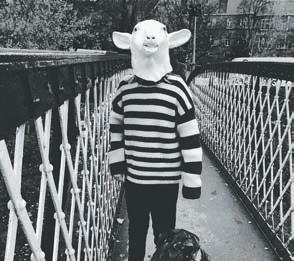
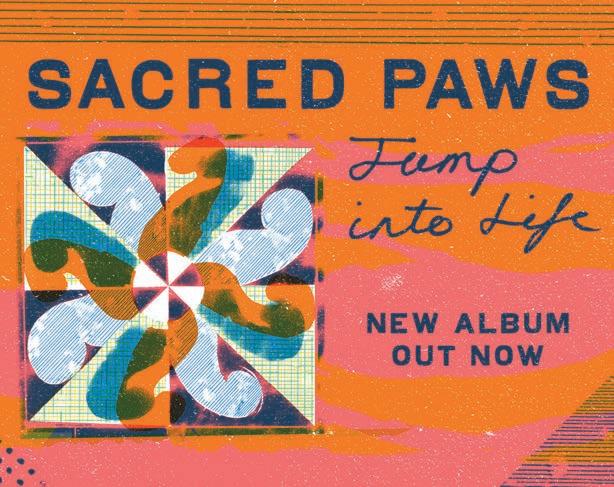

How does music cross a border? Laila Ghaffar reflects on curating connection via co-hosting a radio show amid ongoing border tensions between India and Pakistan
On Tuesday 22 April, 26 Indian civilians were killed in the town of Pahlagam in Indianadministered Kashmir. Nobody has taken responsibility for the attack, and there remains no conclusive evidence from which to draw blame. On Wednesday 7 May, India launched three missile attacks on Pakistan, marking the worst confrontation between the two nuclear-armed countries in over two decades. On Friday 9 May, I plu ed my USB into the decks at AAJA radio station in South London to play a monthly radio show, Humraaz, which I co-host with my friend Trisha.
I was born in London, but I am from Pakistan. Trisha was born in Delhi, before her family migrated to Britain when she was five. Humraaz is an exploration of South Asian culture, history and politics, grounded firmly in the music of the region. But the day before our May show, I realised that there would be no poetic way to convey my rage, despair, fear and disgust. No clever turn of phrase or pithy analysis. I texted Trisha: “Let’s only play Kashmiri music.” “Great idea,” she replied. It was not my choice to be a child of Pakistani immigrants, but it is my choice how I choose to relate to Pakistan and this facet of my identity. Through sheer luck, my family had the financial resources to fund annual trips to Lahore, where my mother’s family still lives. I spent every winter for the first twenty-three years of my life in Pakistan. I did not grow up with any romantic or mythical illusions of the country or its landscape or culture nor do I refer to Pakistan as the motherland. To me, Pakistan has always been messy,
complicated and difficult. But it is also, in many ways, my home. I suspect many Pakistanis would balk at me describing Pakistan as my home because the longest I have lived there at any one time is six months. But I have no interest in justifying the way I feel. As I said, it’s my choice how I choose to relate to Pakistan.
Trisha and I conceived of Humraaz as a way to explore, challenge and play with our respective identities via music. Each month, we carefully curate a joint tracklist for the show. Through this act of musical co-curation, I share my Pakistan with Trisha; Trisha shares her India with me, too. She gi les whenever she presses play on a dizzyingly energetic Punjabi track. “God, I love how much fun we are,” she laughs. More often than not, she will add a melodramatic romantic Bollywood ballad onto the track list, betraying a childhood spent rehearsing Bollywood dance routines and iconic lines in front of the mirror. I love these insights into both her past and present relationship with India.
I like to think that my additions to the playlist have taught Trisha, and our audience, about the ways in which I think and feel about Pakistan. I play Qawwali, a form of Sufi devotional singing which reminds me of cold December nights in Lahore and my aunt swaying her body with true abandon. I add songs by legendary singer Farida Khanum, her dulcet tones soothe me like a cool balm to a burn. I play Ali Seth’s music, his genrebending melodies and playful lyrics reminding me that Pakistanis are indisputably the funniest
Words: Laila Ghaffar
‘The trade of material goods and objects between India and Pakistan has practically halted: as such, music is one of the only cultural exports that can be exchanged freely’
people in the world. Listening to Pakistani music draws me closer to myself: it is an invitation home. I have my own deluded and romantic notions that Humraaz represents South Asia without borders. That our radio show is an attempt to re-map India, Pakistan and Bangladesh, realising a free and borderless cartography. It is, frankly, embarrassing to say that art has no borders. Obviously, this is not the case. The trade of material goods and objects between India and Pakistan has practically halted: as such, music is one of the only cultural exports that can be exchanged freely. Sometimes I add Indian music to the show’s tracklist, and Trisha adds Pakistani music. After all, we speak the same language. Humraaz is a joyous offering to the world, but we cannot ignore the violent realities of the Indian Subcontinent. This recent military altercation has been frightening for both Indians and Pakistanis, but Kashmir remains the primary victim of the ensuing chaos and cruelty. As we played each Kashmiri track on the show, I felt powerless. I still do. But if Humraaz is our way to stay in dialogue with India and Pakistan, then I hope music can help us convey something softer, peaceful and more hopeful than what has passed.

on the second Friday of the month, 7-9pm, via aajamusic.com
A queer Agony Aunt, an excess of crosswords and yearning poetry abound – Dyke News Scotland is the DIY lesbian newsletter we’ve all been waiting for. We chat with the collective about the power of print and connecting queer communities across the country
Should you find yourself in one of many queer or queer-adjacent spaces in Scotland
– Category Is Books in Glasgow, the Lavender Menace Queer Books Archive in Edinburgh, Orkney Library or even Faslane Peace Camp – you may stumble across a stack of unassuming A4 booklets. Pick one up, and you’ll get a glimpse of thriving Scottish lesbian culture between its folded pages.
Dyke News Scotland was launched in late 2024, after the founder saw the Modern Queers newsletter and decided to create a local, lesbiancentric version. Now in its third issue, the newsletter is produced by an anonymous volunteer collective, printed in an Edinburgh apartment and distributed to over 30 venues across Scotland.
There’s an immediately obvious aesthetic callback to DIY queer publications of the past, from the lino-cut title banner to the affordably reproducible black-and-white format. The logo is a thistle wrapped around the labrys axe, an iconic symbol of radical lesbian movements of the 1970s. “I draw upon political artworks and propaganda,” says the designer, who particularly favours artists of the Mexican revolution. As for the title, emblazoned across the front page: “I want folk to see the word DYKE from a mile away.”
“It was important for me to have something with ‘dyke’ in it,” the founder tells me. The word carries a strong history in political lesbian subcultures and reflects the project’s inclusivity. “The idea was to have something that’s lesbian-centered but not lesbian-only,” she continues. “We don’t define it, because it’s for whoever identifies with it
and with lesbian culture.”
Amidst the ongoing attack on trans rights, and particularly on trans women, the editors noticed more submissions relating to transness and trans-inclusivity in lesbian spaces. They feel they’ve never needed to explicitly state their political commitment to the trans community, as it emerges through the content they print: “It’s front and centre.” And despite narratives pushed by certain trans-exclusionary media figures, they’ve never experienced any pushback from readers –nor do they expect to.
With each callout, they sift through submissions of illustrations, comics, short essays, event advertisements, jokes, a surprising number of crosswords and – perhaps less surprisingly – tons of poetry. Compiling the newsletter, editorial decisions are guided by space and printing constraints above all else. “We think it’s important that it’s not super-polished, or super-perfect – that it feels approachable,” an editor explains. “There’s been good and bad poetry in it, and that’s fine – you’re allowed to have bad dyke poetry!”
The personals section is particularly sweet, with submissions from musicians seeking bandmates, people looking to set up a soup exchange, and single dykes looking for love. As of yet, no known romances have blossomed from the newsletter’s pages, although I’m told of friendships and a jam session. But, with more submissions, the team is optimistic: “I hope on some fateful Dyke News fetch quest that some lucky lassies will brush hands over a paper and their lives will never be the same!”
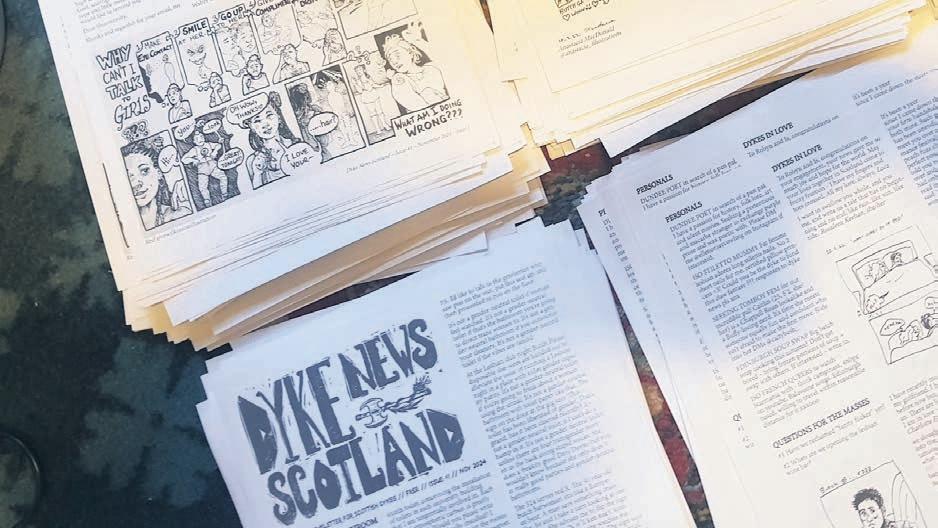
Words: Paula Lacey
The print form offers an alternative to the over-saturated and often alienating world of social media. “I think it’s quite lonely to be a lesbian when you’re newly out,” one member reflects. “It’s nice to have something you can actually touch.”
“We don’t define [dyke], because it’s for whoever identifies with it and with lesbian culture”
Dyke News Scotland
The newsletter ties its distribution list into a tangible, wide-reaching network of real-life queer meeting places. “I think a lot of what we’re trying to show is proof of being physically close to your community,” an editor reflects. “And convince people that you can go out and be in queer spaces, because people are out there.”
The stores, bars, cafes and bookshops on the distribution list were chosen for the communities they serve. “Queers hang out in bubbles, and it’s actually quite hard to reach those bubbles online,” says another editor. “People who might not see it online can still pick it up,” another adds. “It’s about catering to different kinds of queers.”
By nature it’s hard to know whose hands the newsletter ends up in, but the submissions give a sense of diversity in the readership, particularly the letters to the resident Agony Aunt. “I’ve had questions from young gays just coming out, but also from older dykes asking how to break into younger scenes,” she explains. Because of print’s accessibility, her column can bring together sometimes disparate sections of the community through shared stru les and experiences.
The next issue marks a year of Dyke News, but the team has no plans for expansion. Instead, regular small donations would enable the project to be stable, continuous, and sustainable in the long-run. “I like the idea that things don’t need to grow for growing’s sake,” one member says. “We’re part of a broader ecosystem of grassroots queer projects – not trying to be the dominant thing is cool, because then more people can do similar things of their own.”
Find out more about Dyke News Scotland on Instagram @dykenewsscotland; submissions for Issue 4 are open and donations are welcome

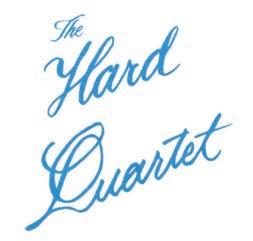







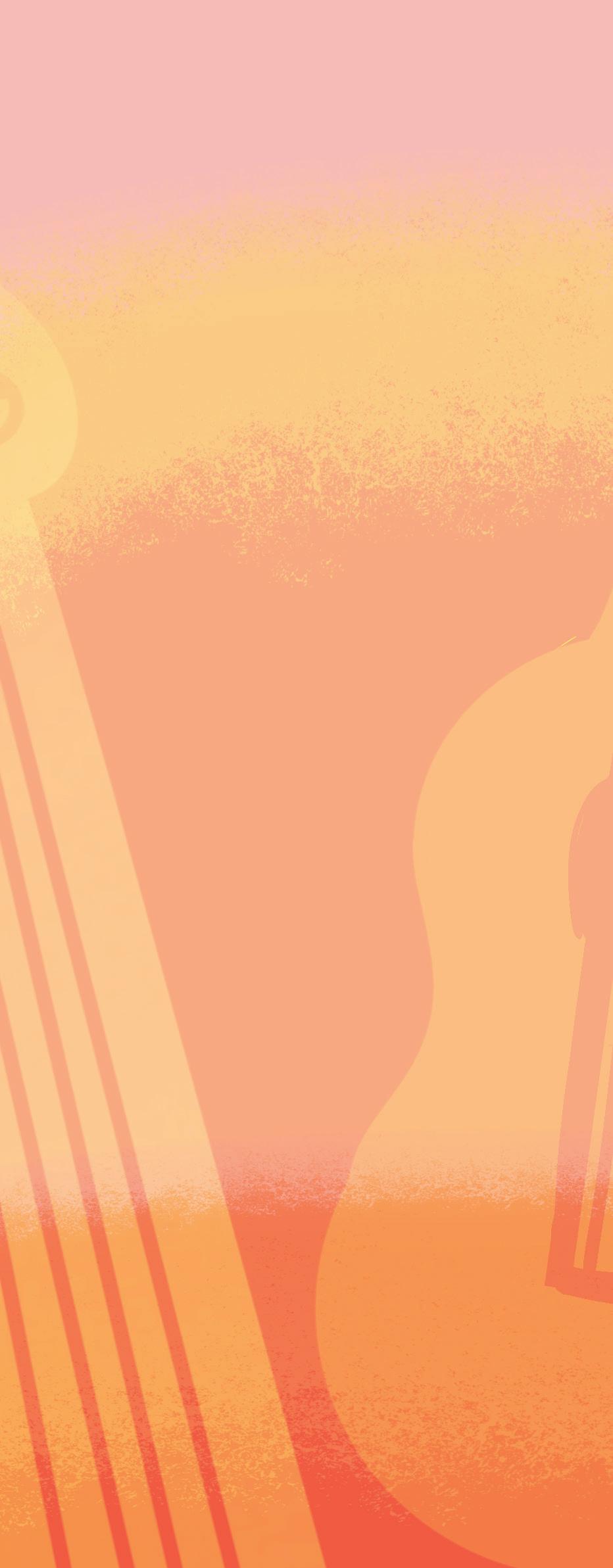
Following Kneecap’s Mo Chara being charged with a terror offence, we we take a closer look at the Northern Irish band’s fervent support of Palestine
Several days before our June issue went to print, Kneecap’s Liam Óg Ó hAnnaidh, better known as Mo Chara, was charged with a terrorism offence for… holding a flag. For legal reasons, we of course don’t condone the waving of a terrorist organisation’s flag, nor are we calling for murder of politicians, but as the band themselves are keen to implore during this debacle: “We are not the story. Genocide is.” Why can some musicians (cough: slowthai) do things like hoist the (pretend) severed head of Boris Johnson (sitting Prime Minister at the time!) live on national television and not get investigated by the police? Why can some people come out against the government and not face backlash? Why Kneecap? Why now?
There’s two important things to consider here. Not only what they’re protesting, but who it is doing the protesting. To understand Kneecap’s fervent support of Palestine, one only has to do a cursory glance through the history books. You don’t even have to read them, you can just look at the pictures.
Britain’s colonial past is no secret, but perhaps the specific links between Ireland and Palestine are less known. There is a reason why the oppression, murder and eradication of the nation of Palestine is felt acutely by Irish nationalists. From the very inception of the state of Israel in 1948, it has had deep ties with the United Kingdom (its creation was, after all, an idea of the British state) and the tactics it has used against the Palestinian people are lifted right from their actions in Ireland. In fact, some British soldiers who served in the Black and Tans literally went to Palestine themselves some years later, to enact the exact same terror there. The playbook is simple: you begin culturally – you take their language, you stop them being educated, you mock and diminish their music, their clothing, their very being, before you kill them.
One million Irish people died during the Great Famine of the 1840s. There was enough food on the island to feed those who were starving, those who were sent to work on menial tasks like building walls and roads to ‘earn’ the food that was withheld from them. A series of devastating, preventable decisions by the ruling British meant that entire generations of families were killed in the slowest, most painful way imaginable. The British held up their hands and sighed, there was nothing they could do. They tried their best to help. The population of Ireland still has not recovered from this. It echoes eerily the situation in Gaza. Enough food, just over the wall. Enough food but we just can’t get it through. Enough food, we sent it, it’s not our fault you haven’t got it. What can we do, we’re trying our best to help
This is not even to mention the Troubles in the north, where Kneecap hail from, that – it is helpful to remember – only ended 27 years ago. Mo
Words: Emilie Roberts
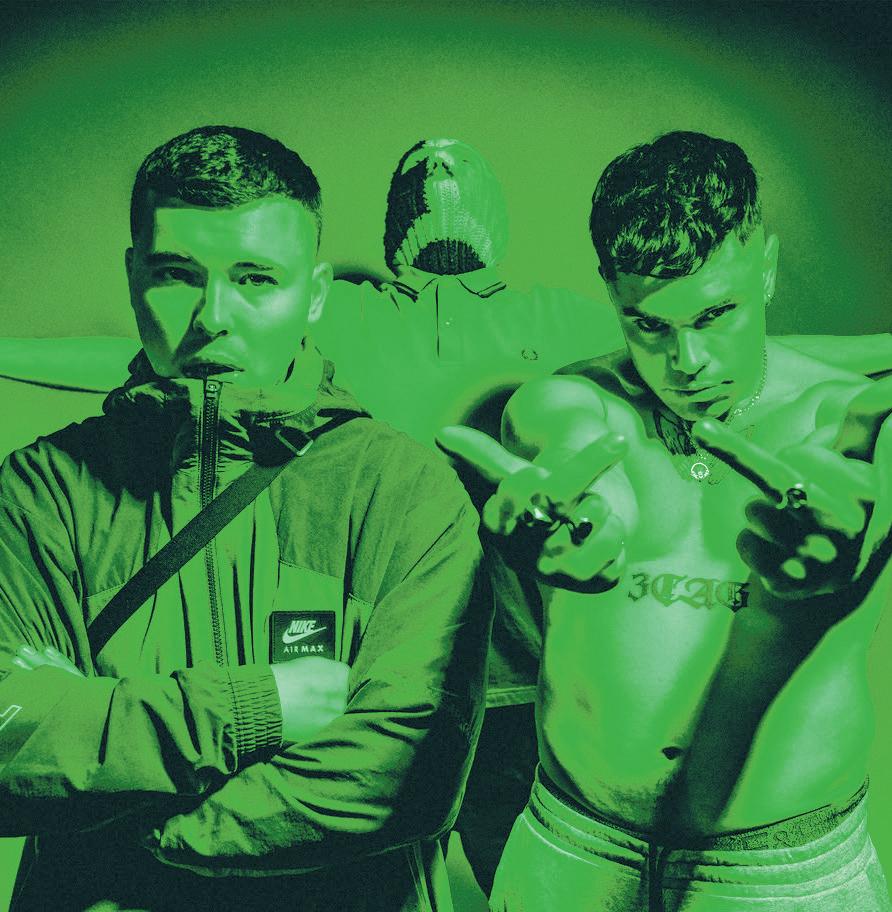
‘It is no surprise the British government see the likes of Mo Chara and Kneecap as a threat’
Chara himself is the same age as the Good Friday Agreement. This is not some far-away conflict of the past, this is the world he grew up in. The events of the Troubles, a conflict of nearly 30 years, directly affected the generation of his parents, his grandparents, and have reverberated their way through his entire community. The actions of the British state in Belfast have shaped his entire worldview. And we are to be surprised
that he sees himself in the Palestinian people? That the burned out buildings of Gaza remind him of the Belfast his parents walked through? That the threat of bombing, kidnap, murder, is not something that has been passed down to him?
It is no surprise the British government see the likes of Mo Chara and Kneecap as a threat. They refuse to let the British forget, refuse to let it all be washed away, swept under the rug, unspoken. They urge us to remember that the oppression of one is the oppression of all. They are holding out their hands to their sisters and brothers in Palestine and saying, we remember, we see you, we won’t let the world forget. And what is more dangerous to tyranny than hope?
Ní saoirse go saoirse na Phalaistíne.
At the time of writing, Kneecap play TRNSMT, Glasgow, 11-13 Jul
Ahead of the second installment of their new gig series at The Queen’s Hall, we catch up with award-winning composer and small pipes player Malin Lewis
When we catch Malin Lewis, they’re in town for a preview of not for glory, a dance-theatre gig that examines the tradition of youth competitions in Celtic music and dance. It’s a collaboration with dancers Charlotte Mclean and Jack Anderson and blends Contemporary with Irish and Highland dance, tender storytelling with observational comedy – but more on that next year.
The next time Lewis is in Edinburgh it will be on 31 May for the second night of their Queen’s Hall gig series, Malin Lewis Presents. They’re programming four concerts across the year, each showcasing artists who have inspired them in some way, from childhood piping tutors to genreblending peers. The lineup also demonstrates the trad scene’s frequent opportunities for shifting between these categories – for their tenth birthday Lewis was gifted a book of piper tunes by Allan MacDonald, who opened the launch night in March. Now they play duets with him onstage at
The Queen’s Hall and help him work his computer as he lays out the music for his next book. “It’s been a dream job,” Lewis says.
The May lineup features Fri , a group whose combination of sparse, expansive melodies and detailed texturing has earned them the label ‘nordgrass’ – some of the group taught Lewis during their time studying at the Sibelius Academy in Helsinki. Also making the journey are Belgianled Marvara (in Lewis’s words, “wild and off the rails […] like dance music but in all its forms”) and Me Lost Me, who plays with electronic folk songs and soaring vocals from behind a desk of electronics, loops and pedals.
“I wanted something wild and vocal to contrast the two instrumental bands and I’m hoping it’s going to be a really nice unusual gelling of that,” Lewis says. “I think it’s really sounds that people might not have heard before – and I say that tentatively because it’s a bold statement.”
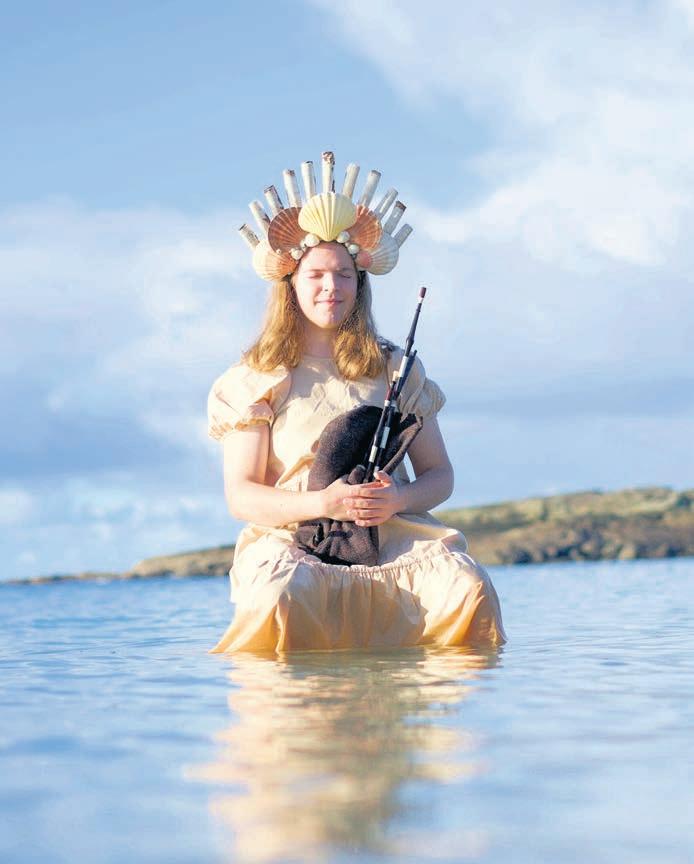
Lewis puts a lot of care into the live music experience – they place a lot of importance on eye contact between performers, and they talk a lot about the role of the intangible vibe in taking an audience to where you want them to go to emotionally. They also appreciate the craft and subtlety that goes into laying down a recorded track, and understand that these are two separate but equally important disciplines.
For them, writing always begins with melody. “I will write around ten to 20 melodies a week, but that’s like tiny little things and most of those will never come to fruition.” Doing it often enough, patterns begin to emerge from these sketches – Lewis looks for things that break the pattern, that feel fresh.
“I try and find the beauty and the discomfort, like finding a little interval on the pipes or
Words: Laurie Presswood
“Sometimes I will get an instrument that I can’t play and force myself to write a tune on it”
Malin Lewis
the fiddle that feels obscure, like it doesn’t necessarily feel easy to play… Sometimes I will get an instrument that I can’t play and force myself to write a tune on it because it makes me actually listen to the melody and not fall into the patterns and shapes my fingers make.”
Lewis plays an unusual form of small pipe called the Lindsay System – piper Donald Lindsay designed them over a decade ago using a 3D printer, and at 18 Lewis asked if they could have a crack at making a version by hand. The chanter has twice the range of a standard bagpipe and a full range of chromatic possibilities, its tone and emotional scope far removed from traditional Highland bagpipes.
Because the instrument is barely a decade old, it has no set repertoire. “The process of making that instrument was also composing new music for it… And so writing tunes for it, it tells me what it wants to write.
“I haven’t had 15 years of habitual learning on this thing of like, these are the ‘correct’ sounds to make,” they continue. “It has different intervals and different sounds and shapes that fit naturally under the fingers and that’s been probably the bi est musical inspiration for me.”
This notion of what you’re ‘supposed’ to do with an instrument, of the ‘right’ way of doing things comes up time and again, even though Lewis has already spent so much of their artistic life reshaping traditional practice. “As a musician, I do have, sadly, an idea of what is right and wrong. And so much of improvising and exploring new work is about, not necessarily undoing, but at least examining and questioning: why do I want this to be right? Who am I trying to prove this to? What am I trying to prove?”
Malin Lewis Presents... Fri , Marvara and Me Lost Me, The Queen’s Hall, Edinburgh, 31 May

To hear the full chat, scan the QR code to listen to the first episode of Music Now: The Podcast malinlewis.co.uk




As Kelburn Garden Party gears up for its 15th iteration, we take a closer look at our Pyramid Stage lineup topped by TAAHLIAH, Man of Moon and Dancer
For those of you keeping an eye on Kelburn Garden Party’s socials, you’ll have seen that a) the majority of tickets have now been sold and b) the full lineup and stage breakdown was announced at the start of May! Since 2018, part of their enormous lineup has been curated by us, with this year no different as we return to our favourite corner of the festival to once again bring sound, light, music, stories, dancing and drama to the Pyramid Stage, this time with a little bit of help from our pals at Crazy Color CASA.
As the festival gears up to celebrate its 15th edition, packed with a wealth of technicolour global talent like Sofia Kourtesis, Raz & Afla, The Allergies, Jamz Supernova, Romare (live) and more, it’s time for us to take a deep dive into the wonders of the Scottish music scene to be found on our beloved Pyramid Stage.
For those savvy enough to have nabbed a four-day ticket, for the second time ever the stage will be open from Thursday, with our friends at
Hobbes Music this year taking over curatorial duties for the night. The lineup will be made up of artists from the label with Sarah/Shaun, Accident Machine, Exterior, Gaming and Jacksonville all playing live, with a DJ set from label boss Hobbes. Then on Friday, we’re all set to roll in like Chandler on that big white ornamental dog, arms wide, proud as punch of our first night of curation as we go pretty darned hard from the off!
Opening our stage will be music producer, activist and promoter Sanjeev Mann, aka Superman on da Beat. Having learned to produce in the pandemic, he’s become one of the busiest producers in Scottish hip-hop; he released his poignant debut album BREATHE last year, and always has a constant stream of fresh

collabs coming out. One such collab, DOT (Don’t Over Think), was a four-track EP with Glasgowbased rapper PAQUE. One of the richest voices in Scottish hip-hop, PAQUE also joins us on Friday night’s bill, so we’re crossing everything for an irl joint performance. Next comes the wildly talented EYVE. Her proudly crossgenre storytelling style combines R’n’B,

hip-hop, pop and techno with her Zimbabwean roots to bring her experiences to life, making for something altogether unique. Closing the stage on Friday night will be the mighty TAAHLIAH – SAY Award-nominated for Angelica in 2021, she’s coming to us fresh from releasing her groundbreaking debut album Gramarye last year, and we cannot wait to welcome her to Kelburn.
On Saturday, Glasgowbased Yemeni singer, songwriter, producer and visual artist Intibint opens proceedings. Her latest single, Ymn Alsa3eed, combines electronics with hypnotic trip-hop beats, while her Yemeni Arabic lyrics touch “upon the various oppression we have faced and our deep desire for justice.” Using her art as activism, Intibint’s opening set is bound to be a powerful one. Next up, Glasgowbased, Donegal-born artist mokusla will whisk everyone away on a cloud with her effervescent brand of dreampop, before Possibly Jamie snaps you out of your dreamstate with his risqué, in-your-face take on pop, as the Pyramid Stage’s Saturday moves firmly into dance mode with back-to-back duos.


Keeping you moving will be Both Hands, the Edinburgh pairing of Brian Pokora and Hailey Beavis. Don’t worry that they’ve not released any music yet, as we’ve got it on good authority that there’s an album’s worth of material ready – expect dramatic storytelling, big danceworthy moments and tiny shorts. If you like the ba ier end of Confidence Man’s party music and the grooves of Jungle, Glasgow/Edinburgh guitar-fronted dance duo KuleeAngee could be right up your street, while fans of Caribou might be into Susan Bear, who’s sure to keep the party going with their catchy electronics, manipulated vocals, and exceptional live drumming. For more live drums and electronics, stick around for Roller Disco Death Party, a dirty martini cocktail of Justice, The Chemical Brothers, LMFAO and Soulwax. While our headliners Man of Moon will make your heart race with the pummelling krautrock, psych and electronica of their back catalogue, including last year’s brilliant Machinism

On Sunday, things once again kick off at a more chilled pace with Glasgow-based SwedishIndonesian singer-songwriter Marcus Engwall. His gentle and considered approach to his hazy songwriting will be more than worth getting out of your tent for. Then Zoe Graham joins us
for a special solo performance, playing songs from her recently released debut album, the aptly titled TENT, calling to mind artists like Fleetwood Mac, St. Vincent and Sharon Van Etten. Sacred Paws’ Ray A s returns to the Glen for round two, this time under their solo guise as R.AGGS – expect live electronics, live violin and live vocals, all performed by the most joyous musician in the Scottish scene, no doubt in an exceptionally snazzy shirt. Then, after standing in for a last minute cancellation in 2023, impeccable party pair Town Centre officially bring their high-energy pop to our stage for a fun, very danceable 45 minutes. Then into the night we go, and hunting cowboys will be the main MO of punk provocateurs Cowboy Hunters, whose guttural basslines and acerbic lyricism will be the caffeine boost needed if you feel yourself starting to flag after
four days of fun. Inspired by artists like Patti Smith, Sonic Youth and PJ Harvey, post-punk four-piece Isabella Strange will then bring their punchy music to the Pyramid Stage, before a big old smack of wonky art-punk from recent FatCat signees Water Machine. “A very cool band,” according to both Henry Rollins and us, their debut album God Park arrives on 20 June.
Closing our stage on Sunday will be another group of exceptional Glasgow talent in the form of Dancer. Featuring members of Current Affairs, Nightshift and Robert Sotelo, the band are inspired by artists like Life Without Buildings, Elastica, The Cardigans and Altered Images; impressively, their debut album 10 Songs I Hate About You landed in the sixth spot of Pitchfork’s Best Rock Albums of the Year list. We cannot wait to shake our tired bodies and whip our heads to their discordant jangling guitars, shuffling drums and Gemma Fleet’s unique speak-singing vocals. What a way to wrap it all up – see you down the front!
Kelburn Garden Party takes place at Kelburn Castle, Fairlie, nr Largs, 3-7 Jul
Remaining tickets available at kelburngardenparty.com
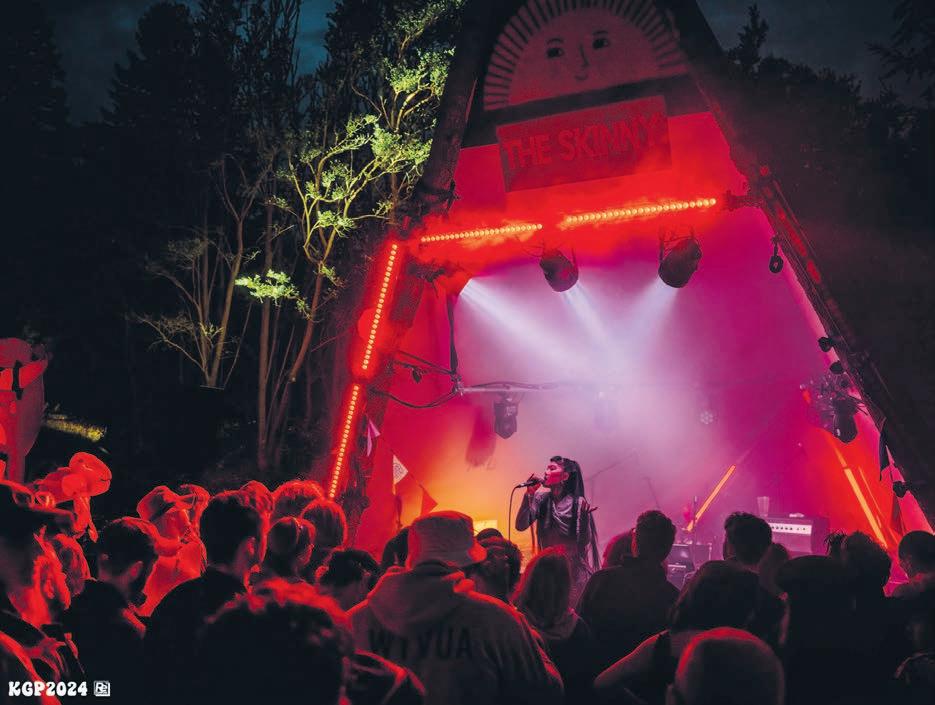

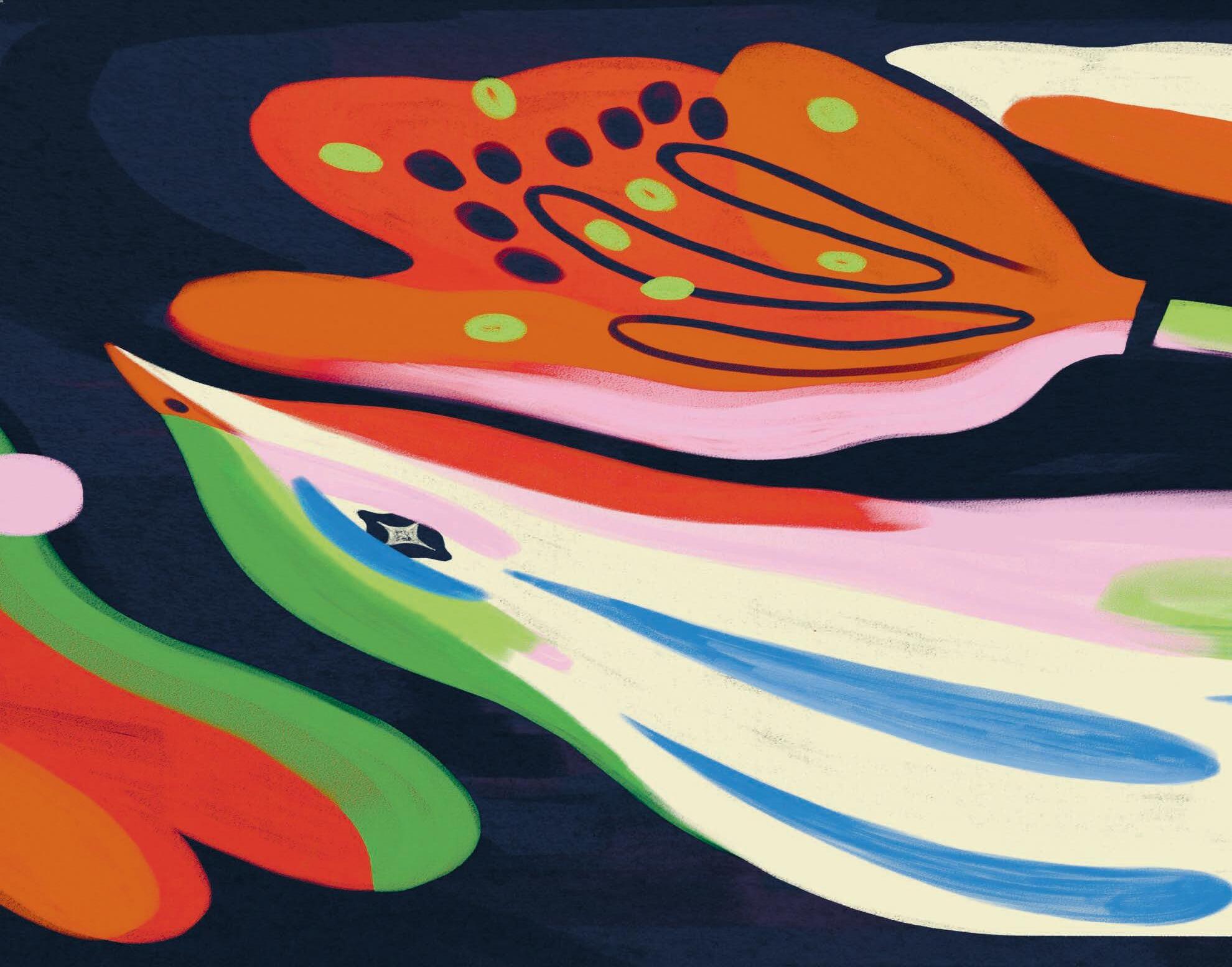


Film critic Ryan Gilbey talks to us about It Used to Be Witches, his playful new study of queer cinema history blending personal memoir, critical analysis and insightful new interviews with an eclectic ensemble of queer filmmakers
Journalist Ryan Gilbey is feeling like a poacher turned gamekeeper. He’s fresh from filing an interview this morning for The Guardian. This afternoon, however, he’s on the other side of the Zoom link to discuss It Used to Be Witches, his dazzling new book on queer cinema, and he seems a bit at sea.
“I always have my pre-interview rituals,” Gilbey tells me from his flat in North London. “It’s like, cram, cram, cram, and then for the last hour before the interview, I’ll write down all my questions. And today I was like, What do I do? I don’t know what to cram on?”
He shouldn’t have worried, I tell him. After all, a significant chunk of It Used to Be Witches is memoir; he’s been cramming all his life.
The idea for the book initially came from Faber, with whom Gilbey had published It Don’t Worry Me, his crackerjack critical appraisal of ten key filmmakers from the New Hollywood era. Gilbey initially jumped at the proposal, but when he sat down to write it, he was hit by a wave of impostor syndrome. His chief concern were his queer credentials. As detailed in the book, Gilbey knew he was gay from a young age. He even came out in his teens, but then fell into two successive romantic relationships with female friends, before finally coming out for a second time, aged 41. “I thought, I’m not gay enough,” says Gilbey, “I was in straight relationships for two decades. I’ve got three kids. How can I write a book like this?”
He also stru led with the shape the book would take. “I remember saying to my editor, ‘Well, obviously the form has to be queer. It can’t just be about queer cinema.” Much time was spent mulling over this form (“I had some real Alan Partridge brainstorming sessions”) until he struck on the notion that this crisis he was feeling, all these worries about his own queer identity, should be part of the book. “Instead of the roadblock, my insecurity became the vehicle to drive the book,” he says. It Used to Be Witches opens in Venice, with Gilbey arriving in that floating city to deliver some lectures on cinema to students as part of an art history course, and him being mortified when he realises the film clips he’s about to screen over the next few days are really fucking gay. “I really was having that crisis,” he explains, “and it was fascinating to realise that all those feelings of shame were still there. I was like, ‘What will the students be thinking about me when I show this clip from Nighthawks or this clip from The Watermelon Woman? Will they be shocked? Will they think I’m trying to indoctrinate them?’ I was feeling all that internalised homophobia, all the stuff that we were told about ourselves in the 80s, 90s, and, well, still are today.” Throughout the book, Gilbey
returns to similar moments of gay panic – some comic, some traumatic.
Feelings of queer inadequacy come up, too, in several of the probing but playful interviews woven throughout the book. As a journalist, Gilbey usually doesn’t have much truck with writers who insert themselves in their pieces. But because he was telling the story of queer cinema through a personal prism, he wanted the reader to feel they were in the room with his interviewees, and could feel his awkwardness, like when trans filmmaker Campbell X teases him for being too hetronormative. “I was overjoyed when Campbell X called me out,” recalls Gilbey, “him saying, ‘Oh God, you’re married with kids, aren’t you? You should be out cruising’.”
Elsewhere, though, he was surprised to find that many of these wonderful queer filmmakers had similar feelings of self-doubt. “Like Desiree Akhavan, for instance,” su ests Gilbey. “She says she’s concernd about not being the right sort of gay because she doesn’t like camp humour and can’t stand how ugly the rainbow flag is, or then Andrew Haigh being told by younger queer audiences he’s doing gayness wrong. I suddenly found all these echoes of my insecurities in all these great directors.”
Words: Jamie Dunn

One of the chief joys of It Used to Be Witches is how leftfield it is, not just in its inventive hybrid form, but in Gilbey’s choice to shine a torch in the less obvious areas of the queer film canon. “There’s always a pressure to be exhaustive, which I had to dispel,” he explains. “When I was able to shake that off, I could actively exclude certain things. Like The Wizard of Oz and Happy Together, they only get one mention. I love both those films, but I didn’t want to go over well-trodden ground. Whereas Peter Strickland’s film Night Voltage hasn’t even been made, and it gets practically a whole chapter.”
It Used to Be Witches is a splendid book, but being a critic himself, Gilbey has already imagined the bad reviews in his head. “I was stressing for a long time, going, ‘OK, I know what everyone’s going to say about this. They’re going to say this falls between two stools. It’s not filmy enough for a film book, and it’s not memoir enough for a memoir.” It dawns on him, though, that that’s a very normie, binary mindset. “I started thinking, ‘Hmm, between two stools? Maybe that’s not so bad. That would be a very queer place to be, right?’”
It Used to Be Witches is published 5 Jun by Faber
Words: Rebecca Crockett
Everybody needs a neighbour. Someone to share ideas with, collaborate together, and learn from. For many years, local arts venues provided that space for artists, giving them a home to grow their vision. Sadly, foreclosure signs are becoming more common, and we’re losing the spark that makes our communities so unique. But if our civic spaces are dying, where will artists find their voice?
As part of the 10-year development phase programme for Sauchiehall Street, the National Theatre of Scotland has partnered with Glasgow Life to commission The Neighbourhood Variety Show – Sauchiehall Street on 5 June. Created by Eoin McKenzie, the project aims to transform the stage into a truly civic space by reimagining the variety show tradition with local people and performers.
Instead of creating for mass appeal, The Neighbourhood Variety Show meets performers and audiences where they are. It encourages acts by non-professional artists and tries to create work that has a hyper-local interest. It is a tastemaker of creativity, but as McKenzie jokes, there is something for everyone: “Everything is ten minutes long, so if you don’t like it, it’s going to be over really soon.”
This is the second year of the Variety Show, having taken over Springburn Auditorium last July for a celebration of a Glasgow neighbourhood which has often been disregarded in favour of motorways and industrialisation.
McKenzie says that a big part of the show for him was about reclaiming the stage as a place of self-expression and connection for local communities: “It did start as a question for me of, how can you make a stage somewhere that community can be felt? How can you make it somewhere where lots of people who might not meet or might not connect otherwise can come together?”
This time, The Neighbourhood Variety Show comes to The Garage, a Glasgow institution which has been the stomping ground of musical legends, local talent, and bass hunters for over 30 years. It is a fitting venue to celebrate Sauchiehall Street’s once-international recognition as an entertainment hub.
However, McKenzie admitted to not having much experience of the club after being denied entry in his student days. All is forgiven now, though. McKenzie said: “I’ve been really struck by how committed and invested the staff are at that venue in a way that I didn’t expect. It comes from a genuine place for them, I think, where they’re really invested in this idea that the venue is for everyone, which is amazing.”
The Garage is just one venue in a long history of Glasgow’s love of Friday night entertainment

and packed music halls. Unfortunately, for every venue which survives against the odds, there are countless others lost to time. We are losing training grounds for artists to develop their acts, so it’s more important than ever to protect them.
“That is the politics of the work in a way. We live in a time in the UK where we’ve got a collapsing welfare state, and our civic spaces and our community spaces are constantly being eroded, if not destroyed. There is no sentiment of care on a government level for those spaces,” McKenzie says.
However, Glasgow has not forgotten this legacy. The line-up boasts an array of performers and flavours to satisfy any craving, from Overdrive Dance Company to drag artistry by southern belle Mona Mae to Karyn Turner’s excuse for singing. The sonorous offerings of the Mission Voices Choir will be there as well as a special contribution from Phil and Fiona of Glasgow Music Tours – The Music Mile.
Monday Night Drama @ Platform has even put together a performance which McKenzie describes as a “surrealist, meta-theatrical, bizarre interpretation of an urban myth” after which he chuckles, muttering “the kids are alright.”
Also taking part is Jess Fitzgerald, a former dancer in popular variety shows in Glasgow. McKenzie says: “When I speak to her, she talks about it as being part of the social fabric of people’s lives, that they would go to the theatre on a Friday night with their friends and family, and they would engage in this form of entertainment.”
It takes an extraordinary amount of effort to build a neighbourhood. But if people like Eoin McKenzie and everyone involved with The Neighbourhood Variety Show continue to create space for artists to create and discuss, there will always be a place for true artists to call home in Glasgow.
“I really believe that there are loads of amazing things that happen in the city that are incredibly important, beautiful, profound connections that we just don’t celebrate… We want to remind people that culture is this really important thing that brings people together, and Glasgow is really good at it. We know how to throw a very good party.”
The Neighbourhood Variety Show,The Garage (G2), Glasgow, 5 Jun, 6pm & 8.30pm, £2.50-5
nationaltheatrescotland.com

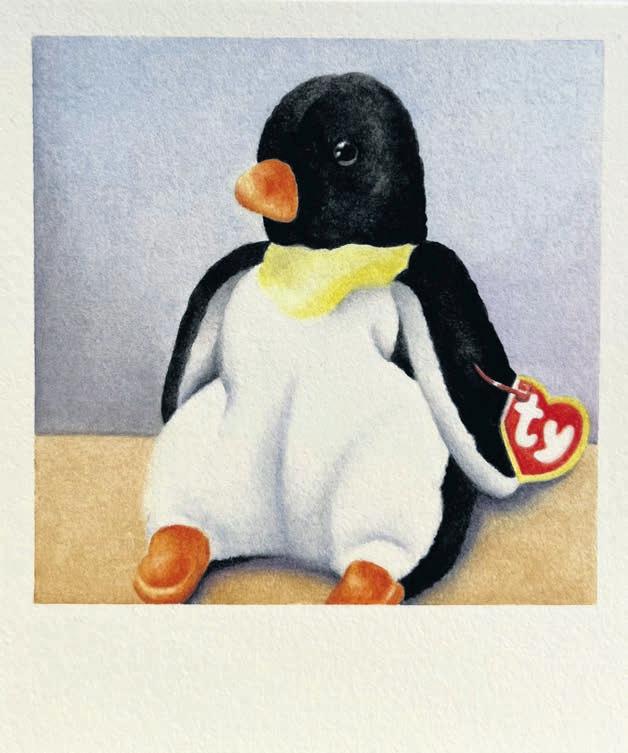
Matthew Kriske, MFA
Welcome to The Skinny’s preview of The Glasgow School of Art Degree Show 2025. This annual exhibition of graduating student work is a highlight in the Scottish arts calendar. You can always expect innovative approaches, bold ideas, and a distinct sense of collaboration and community from the work on show.
This student-led supplement acts as a survey and preview of the Degree Show, exploring our four specialist schools: the Mackintosh School of Architecture, the School of Fine Art, the School of Design and the School of Innovation and Technology. Our student writing team is comprised of third year undergraduates, who have now become expert voices on the approaches, techniques and concepts explored by the community of artists and practitioners at The Glasgow School of Art.
The work discussed is varied and multifaceted, but there are unifying themes – how personal and cultural identity intersect; the comforting ephemera of memory; how the deeply personal can be prescient and political. There is also a throughline of civic responsibility across architecture, art and design. Sustainability, marginalised perspectives and climate action are put front and centre.
Each feature within this magazine explores the depth and detail of these themes, shaped by interviews and thoughtful conversations with exhibiting Degree Show students. There is
exploration of method and technique alongside investigative questioning. This makes the supplement a useful map of the Degree Show 2025 whether you’re visiting in person or online.
The on-campus Degree Show coincides with the launch of its digital showcase. This platform is a place for students to present their work online, complete with personal context, and notes on their study and practice. It also gives audiences outside of Glasgow the chance to engage with the work of this year’s graduating cohort. Each page of the digital showcase has been curated by our graduands to display their processes, ideas and pictures of their work. As well as browsing by school and by student, entries have been categorised by theme. This emphasises the connections between works and provides a new angle on a traditional degree show exhibition.
The Degree Show isn’t the only thing happening at The Glasgow School of Art this summer. Check out the Heads Up section at the back of this supplement to find highlights for your diary in the months ahead.
We hope you enjoy this exclusive look at this year’s Degree Show 2025, and we look forward to welcoming you in person if you can make it. Finally, we’d like to give a huge thank you to our student writers, who have worked hard to bring the supplement together. Congratulations to The Glasgow School of Art Class of 2025.
This supplement was produced in association with The Glasgow School of Art




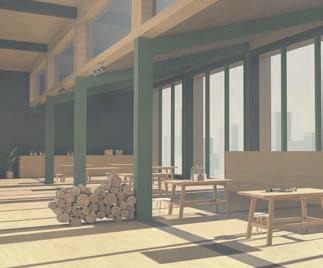


52 The presentation from the School of Fine Art features work which reaches out for connection through bold approaches to Fine Art Photography, Sculpture and Environmental Art, and Painting and Printmaking.
54 Across varied disciplines, the School of Design unveil stories told through form, function and fearless imagination.
56 Work from the MDes Communication Design cohort question the best ways to communicate personal, public and political ideas.
57 The School of Innovation and Technology explores the future of its specialisms with work across the scope of digital design and technology.
58 The Mackintosh School of Architecture presents work that engages with civic responsibility, sustainability and urgent climate action.
61 With a presentation that takes over the Glue Factory, work from the Master of Fine Art programme plays with uncertainty, memory, ephemera and decay.
62 From summer courses to exhibitions, here’s a Heads Up of what’s happening at the GSA in the next few months.
Listen to exhibiting students talk about the process of putting their shows together in the GSA Degree Show podcast, which will be available shortly after Degree Show opens to the public on 30 May. They will be joined by members of the student writing team for this supplement.
The student writing team is comprised of Miranda Owen Wintersgill, Angus Hamilton James, Naomi Bull, Kavya Kadakia Amish, Maud Wheldon-Posner, Malak Naseem, Yuchen Liu, Helin Yao and Arabella Goff

In this year’s Degree Show, students in the School of Fine Art are reaching out for connection, building worlds, and constructing narratives that question memory, place, and concepts of the self, both culturally and individually
Words: Miranda Owen Wintersgill and Angus Hamilton James
This year’s graduating Sculpture and Environmental Art students have shown a distinct move away from minimalism. Instead, this exhibition features a wealth of personal, theatrical, and autobiographical artwork exploring myth, culture, movement, and memories.
Emilia Evans-Munton’s project Remember I’m Still Here is a 20-metre long sock monkey, designed to set the tone for the sculpture year group, and is the first thing viewers see as they approach the Stow Building. This work, like many others from the year group, is intended to create a welcoming space in which to gather and interact. In many areas, in fact, students have broken away from the conceptual elements that can distance many viewers, and moved towards creating work to be enjoyed by a wider audience through shared experience and interaction.
Inside the building, Harry Boulton’s immersive installation explores the process of moving home and digs into the idea that ‘shelters are not just structures but containers of identity, (and) memory’. Boulton plays with the idea of
claustrophobia, utilising a vast array of moving parts and materials. Like many of the sculpture students, he seizes the final opportunity to go big.
Mimicking movement as it occurred in ancient tales, Agnes Sharp’s performance work draws on themes from The Odyssey. Sharp’s exhibition consists of a series of photographs documenting her journey dra ing a two-metre-long steel and wood trailer from the Stow Building to Queen's Park, carrying PA systems, light and band equipment. This performance happened alongside a choir, her friends, and many members of the public, who spent the time telling stories, singing, and moving the cart in the rain in a display of community and human connection through storytelling.
Maha Al Yousefi similarly explores these themes, asking viewers to reflect on the ‘fluidity of home and the traces we carry with us’. Their work examines the concept of belonging through the lens of Eastern iconography, asking how culture forms both personal and collective narratives. Sustainability is a vital influence across the programme, and Al Yousefi poses it as a metaphor with

the cyclical character of memory being mirrored in the recycled paper they sculpt from.
In a separate exploration of home, Morfo Nikita’s work takes from her experiences in her home of Nicosia, Cyprus. For her section of the Degree Show, Nikita will be showing a home-made buffer zone, which, using peepholes, reveals traces of an unenterable other side. This process imagines links between Glasgow and Nicosia, as well as artist and viewer.
Sol Pawlyn’s work utilises almost every department and workshop available to students at the GSA. His honest and visually striking work, comprised of colourful masks with sinister expressions, uses a mythical lens to navigate how his early experiences of relationships and adulthood were shaped by Grindr as he critiques the grooming culture perpetuated by the app.
Finally for Scuplture and Environmental Art, Alexandra Smart will be exhibiting a multimedia installation centred around a collection of teapots and embroidered tea towels. Working in response to the death of her father last year, Smart explores her feelings of being neither Scottish nor Welsh, and her distant memories and links to her family. This is presented through playful and camp forms, which tangle together self portraiture, tourist souvenirs, Toby Jugs, and Pagan mythological symbolism.
This Fine Art Photography year group has shown a clear shift away from the traditional toward an exploration of the auditory, sculptural, and digital. Many students in photography have worked collaboratively with the School of Design and other departments to explore how shared practices and exhibitions enrich their work.
Examining culture through music and sound, Mimi Belilty delves into her Moroccan heritage in relation to the death of her father. Like Smart, this exhibition centres around culture and community, featuring intermittent performances, visiting student groups, the ingredients to make traditional Moroccan tea, and a rug to lie on, all of which take place ‘within an instrument’ created by the artist. Agnes Little’s work delves into cybernetics and relationships through a series of runs. Documentation in their space will show Little’s run around Stow Building, in which their direction for the next section was given to them by sensors attached to Arduino computers at checkpoints. Likewise, a typeface made in collaboration with Lydia Harris (School of Design) will be on show, built from the shapes of a similar series of runs made during this project.
In the adjacent space, Tom Gibson, a longtime collaborator of Little’s, explores paths in a


different way. By attaching trackers to disposed objects, Gibson follows their journeys. The space features 180 starting point photos, a film compiling 330,000 Google Maps screenshots, and a series of physical maps, which explore and expose the malpractice of waste disposal. Gibson also presents a typeface made in collaboration with design students, which this time acts as a code that viewers are challenged to decipher as they engage with the space.
Jonathan Pratt (Fine Art Photography) and Freya McKinty (Painting and Printmaking) present a collaborative project from across programmes. This space brings together two bodies of work created in dialogue, and both artists explore what is lost and gained as imagery moves between the digital and the physical. The space itself is intended to mirror places designed to be passed through, taking from lobbies, hallways, stage sets, and First-Person Shooter levels such as Medal of Honour’s ‘Metro-Plex’, which is seen stripped of textures in the exhibition. The construction of the space is left visible and bare, bringing the unseen processes and elements of the building into the spotlight in an attempt to question institutional exhibitions and ignored imagery.
In Painting and Printmaking, students have been working back and forth from the playful to the formal, building poignant fictitious narratives for viewers to get lost in.
Iris May inquires into loneliness and digital noise, specifically concerning young people
post-COVID. May constructs curious and familiar flatpack creations that are perhaps more like friends than sculptures. The resulting forms are dreamlike, exploring a search for connection through an exa erated creation of queer bodies. May also shows a large collage constructed from her previous work. This piece portrays digital noise and critiques social media and overconsumption without any individual blame or superiority. The overlapping layers of painting, drawing and collage perhaps su est creation and community as the answer to these concerns.
In her solo work for Painting and Printmaking, intuition and play are essential to Freya Davies Her project delves into the domesticity of the home by capturing energy and character using bright colours and bold patterns to form nostalgic still lifes. Davies creates theatrical work, slightly detached from reality, that toils with perspective. She encourages the viewer to find colour and joy within their everyday lives.
Ruby Atkins displays large theatrical oil paintings that follows chains of faked, copied, and appropriated works to subvert the subject matters and styles of traditional oil painting. Atkins reimagines them by using visibly modern colouring and a contemporary twist while still working from history to investigate the cyclical nature of art movements and stories.
At the School of Design, a unifying theme weaves through diverse disciplines, as the Class of 2025 unveil designs that intertwine the personal and the cultural – stories told through form, function, and fearless imagination
The Product Design Engineering programme bridges engineering and design disciplines to develop, build, and test innovative product solutions to real-world challenges. Jake Lee’s project tackles the petrochemical waste produced within the surfing industry by replacing traditional foams and resins with sustainably sourced, natural alternatives. Lee’s beginner surfboard features an engineered industrial moulding process for a mycelium composite core and the rest of the natural board. The result is an entirely natural board that can completely biodegrade.
Sophie Willis looks at protecting the marine habitats in Scotland, which, despite their importance, often fall to community organisations and citizen scientists for research and preservation. To support these efforts, Willis is developing a data collection device that bridges the gap between prohibitively expensive research equipment and the more affordable but time-intensive methods currently available. Killian Maguire proposes an alternative approach to communal music listening by disconnecting from personal smartphones,
which are poorly adapted to shared social environments. His streaming controller facilitates a more collaborative and haptic mode of engagement, fostering social connection through the shared use of a physical device.
Driven by vision and purpose, this year’s Interior Design students transform Glasgow’s derelict buildings into vibrant catalysts for urban renewal. Barsha Poudel’s project, Grow and Gather Hub, embodies this spirit of transformation. Rooted in the desire to bring farming closer to urban life, it reimagines Glasgow’s historic rotundas as vibrant centres for growing, learning, and community engagement. The project bridges the gap between city living and sustainable food production, creating a dynamic environment where people of all ages can reconnect with nature through hands-on farming, educational workshops, and shared experiences.
Sophia Cavalluzzi’s work envisions an evolving digital detox facility that offers users immersive, anatomy-inspired experiences designed to promote a full-body reset from the

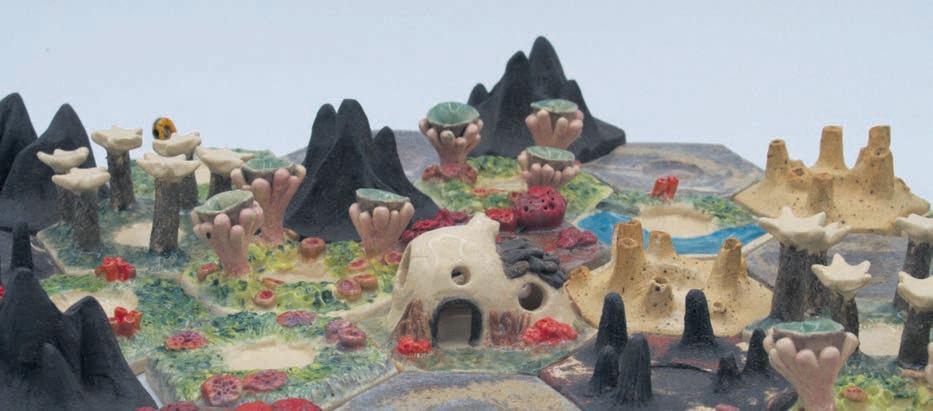
relentless pace of the digital world. The project is founded by Sono the Collective, a global design studio committed to creating experiences that address the darker impacts of the digital age for the benefit of human well-being. The detox facility is located within the Botanic Gardens Railway, extending nearly one kilometre through this unique urban landscape.
Jessie Orville’s Shades is an inclusive beauty retail concept that celebrates multiculturalism, focusing on people of colour and mixed-heritage identities. The five-storey space blends cultural storytelling, handcrafted materials, and interactive tools to reimagine the beauty shopping experience. From swatch cards that match diverse skin tones to haircare education and a multicultural tea bar, each floor explores a different stage of personal identity. Inspired by traditions worldwide, Shades centres individuality, connection, and confidence. It’s more than a store – it is a space honouring heritage, building community, and making everyone feel seen and celebrated.
The graduating Fashion Design students’ collections celebrate creative freedom and diversity, reflecting a wide range of audiences, concepts, processes, and making practices, each shaped by individual passions and perspectives. Kyra Ho’s project engages with Edward Saïd’s concept of Orientalism by uncovering the overlooked histories of the women in her family, particularly their roles as Chinese hospitality workers. Rather than reinforcing the Western gaze that romanticises or exoticises the East, her work actively dismantles these narratives by grounding itself in the textures of lived experience. Through design, she weaves together stories of resilience, care, and quiet strength – narratives often marginalised yet essential to the spaces they nurture and sustain.
Duncan Brown explores the intersection of identity, image, and the pursuit of personal growth through clothing. Drawing from the narrative within his wardrobe, he examines how his clothes reflect his story, rooted in a working-class upbringing, grounded in tradition, and shaped by practicality and simplicity. With aspirations to progress beyond the confines of his roots while still honouring them, Brown embraces minimalist design principles to curate a wardrobe for the everyday, one that merges tradition with modernity. Through clean lines, neutral tones, and thoughtful tailoring, he expresses personal growth, pride in his origins, and the ambition to evolve beyond them. Tarika Kinney’s graduate collection, Progeny, is a tribute to her matriarchal heritage, blending Irish and Indian influences through craftsmanship and sustainable design. Rooted in memory and identity, each piece transforms deadstock materials into tactile, intimate garments using heat pressing, casting, and knit

layering techniques. Prioritising circularity, tradition, and innovation, Progeny challenges fast fashion with a slow, intentional approach. It is a deeply personal exploration of legacy, material rebirth, and the lasting bond between garment and wearer.
This year’s cohort from Communication Design engage with a multitude of themes. In particular, a common thread is connections. They pose the questions of how we connect with each other, the world and beyond. In her beautiful body of work, Amber Charlton reflects on her mother’s practice as a furniture maker – creating a stunning film that engages with personal relationships but also urges an audience to think about our families’ lives before our existence and the choices mothers are criticised for when raising children, whilst also cultivating their own lives. Her work takes a collaborative step with her mother as they create a frame together, incorporating their practices and their connection. This frame hosts part of her work.
Marko Hallauer reworks traditional scopes of illustration through vivacious worldbuilding in their practice, connecting the audience to new existences. Drawing upon daydreams, the whimsical, Hayao Miyazaki’s animations, and narrative, Hallauer formulates a complex and beautiful board game, interactive and eye-catching, that explores imaginative flora and mycelium. In terms of material, the work is fired clay; it feels delicate, yet holds a strong place with colour, whimsy and creativity. The ambitious work is entirely playable and engages players on an imaginative, sociable level.
In Silversmithing and Jewellery the students this year explore personal, narrative jewellery looking at the tangible interactions between traditional structures and new material. Sorcha Carlin's collection ‘Through her hands, then mine’ explores historical forms and heirlooms through the inspiration of her grandmother’s jewellery box. The box is a self-portrait, a collection of gestures and connections, and a quiet mourning of past selves. Her collection looks at imprints of the past. It utilises materials familiar to her daily life; hair extensions, nail polish, teeth and her own hair. The collection is deeply personal and gifts wearers and viewers an insight to her life and history. Another student, Holly Brigitte MacDonald, creates an ongoing narrative with the city of Glasgow through
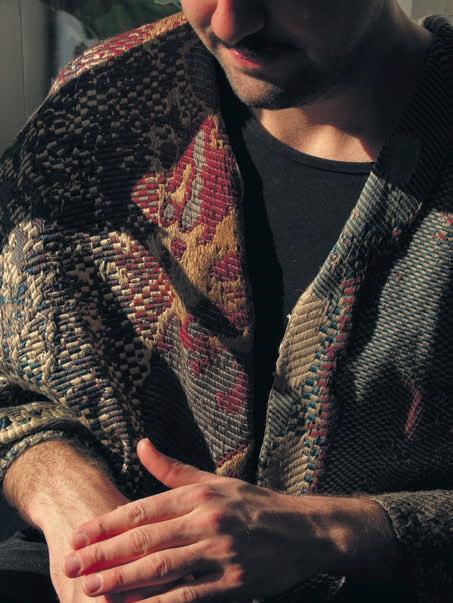

her collection, Vestige. Her work speaks to the tension of being stuck and nearing freedom – it is about transformation and becoming new. The traditional materials reflect delicacy, a contrast for the structures of the city – enamel, silver and glass.
This year’s Interaction Design students are an innovative and intimate group with students engaging in a wide range of tools, prominently new media. With themes of connectivity through technology, sound and person, student Ally Radomski engages with a myriad of sonic textures from our world, and the processing sound goes through. An elaborate and innovative work, they create an ecosystem of sounds in an installation An array of floating ears, which leaves the innards of cables exposed demonstrating an organism of sound. In their words, “You are not hearing a place. You are hearing an interpretation.” This work – like many of the interaction pieces – is made to be experienced and immersed within.
The work from Textile Design this year plays upon the beauty of traditional technique and how this evolves to live and weave its way into our lives

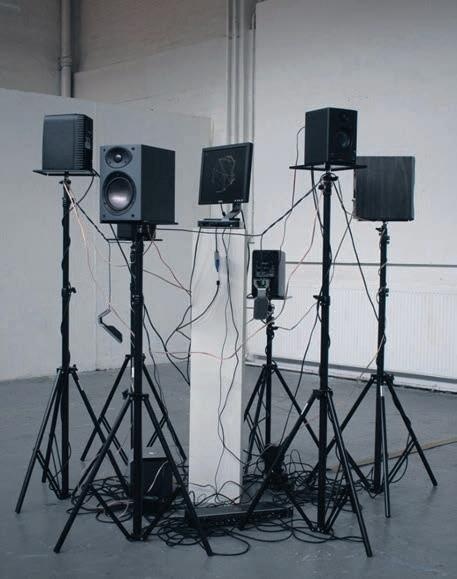
now. Esme Lawton is an embroiderer creating a series of textile pieces inspired by traditional Catholic garments – that of nun habits and the like. She draws her inspiration from items collected on travels, and refers these back to her own family’s archive of iconography, as well as being influenced by a Catholic upbringing and how this plays into her making. All of the collection is made by hand and with the use of scavenged materials, creating a visually didactic look. Another student, Zofia Szewcyzk, explores the organic and synthetic, asking the question the question: what’s the most reliable way to heal? She wants to create a bridge between natural, alternative medicine and scientific, cosmetic solutions to create the ultimate wellbeing experience. Her work is immersive as she explores scent, imbuing her fabrics with aromatherapy. Her inspirations come from microscopic exploration at the University of Glasgow and she blends this into the colour and patterns of her collection.
School of Design Degree Show, Reid Building, 30 May-8 Jun
The students featured in this year’s MDes Communication Design cohort use mixed media tools to explore personal and political narratives
Words: Helin Yao
Yueke Yin’s Have a Seat at the Table explores gender through the body, seen from the angles of relationship, connection, and gaze.
Drawing from personal and observed experiences growing up in China, Yin reflects on how patriarchy shapes women’s lives – from childhood expectations to workplace discrimination and domestic imbalance.
Her project is a response to the everyday stories often dismissed as ‘normal’, reclaiming them as sites of resistance. The title borrows a phrase now echoed among young Chinese women seeking presence and dignity. Through this work, Yin invites viewers to witness not only the stru le for a seat at the table – but the demand to eat well, and to be full.
Yixuan Du’s Ideal Museum is a speculative curatorial project that reimagines how cultural artefacts are displayed and interpreted. The work began with a mislabelled bronze tapir in Glasgow’s Burrell Collection – a moment that led Du to question how misinterpretation occurs when objects are displaced from their original cultural contexts.
In response, she critiques the linear, objectled logic of traditional museums and proposes a more participatory, imaginative approach. The fictional museum unfolds across six themed rooms: reconstructing historical setting, comparing visual forms, tracing patterns and motifs, grouping by era and material, linking to texts, and restoring everyday or ritual use. Each room offers a different way to re-engage with the object and its cultural echoes.
The project culminates in six thematic posters and two printed publications, weaving together research, visual design, and narrative. Rather than centring collection or ownership, Du’s museum becomes a space for resonance – where artefacts are not just preserved, but reanimated through context and imagination.
Natasha Boys’ I Beg Their Pardon! reframes the Scottish witch trials through a contemporary feminist lens, drawing parallels between historic persecution and modern systems of control. The project centres on the lack of legal pardons for those accused of witchcraft, using their stories to explore ongoing pressures for women to conform.
At its core is The Drowning Pond Projections – a photographic series created at Mugdock’s historical drowning pond where legend has it that suspected witches were put on trial. In Boys’ work, quotes and reflections are projected onto the landscape. These images explore how
framing, space, and site shape meaning, and how violence echoes through cultural memory.
Referencing the UK Supreme Court’s recent ruling on the legal definitions of ‘woman’ and ‘sex’ within the Equality Act, the project critiques today’s regulation of gender expression. Boys reveals how mechanisms of fear, once embodied by water, persist in new forms – reshaped, but not erased.
Upasana Chadha’s project brings attention to an often overlooked environmental catastrophe – the widespread harm caused by industrial fishing and abandoned equipment known as ghost nets. These lost or discarded fishing nets silently drift through the oceans, ensnaring marine life and leading to slow, painful deaths.
An estimated 300,000 whales and dolphins die each year due to entanglement according to the World Wildlife Fund.
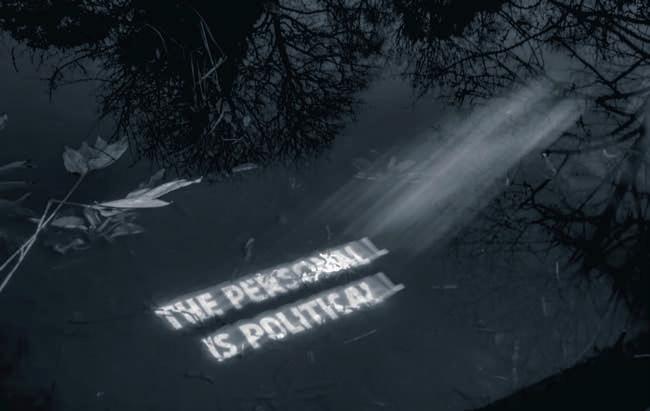
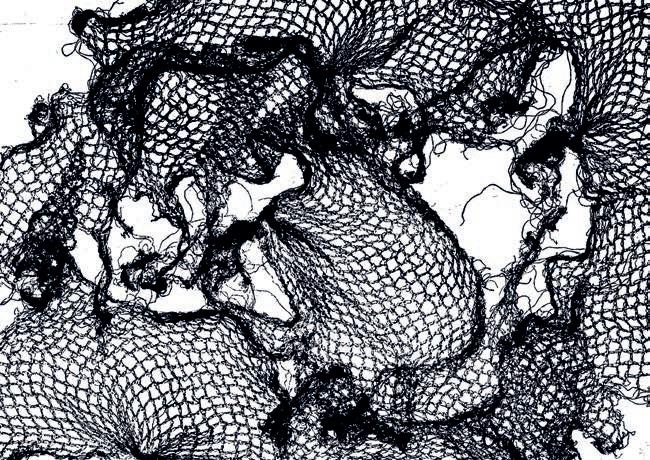
In response, Chadha created a 100-page publication that translates a stark research finding into visual form: for every whale or dolphin lost, four fragments of fishing gear remain. Central to the design is a mono-printed texture of a fruit net – an everyday object reimagined as the ghost nets that haunt our seas. This texture threads through the publication and a series of experiments in dry-point etching and mono-printing.
While the project mourns the impact of human activity, it also celebrates the whale as a majestic being. Through this dual lens, Chadha invites an empathetic witnessing of ecological loss and a deeper reflection on how we might live in harmony with the oceans that sustain us.
Across these projects, personal experience becomes a lens for wider critique – whether exploring gender, cultural memory, or ecological harm. Through the lens of communication design, the students reframe what has been overlooked, misread, or silenced. Their works share a common urgency: a desire to reimagine, to resist, and to reshape. Through image, text and form, they ask not only what stories we tell, but how we tell them – and who gets to speak. In doing so, they offer not just reflections, but futures.
MDes Communication Design Degree Show, Reid Building, 30 May - 8 June
The School of Innovation and Technology are working to reshape the future of their specialisms. Producing ideas behind the scenes, SIT students work ambitiously to enhance today’s scope of digital design and technology
Words: Arabella Goff
Students in the School of Innovation and Technology develop self-directed, exploratory approaches to 21st-century innovation. Investigating the intersection of human experience and emerging technologies, students embody the roles of visionaries, designers and innovators.
Lewis Davidson, a student of the Sound for the Moving Image programme, is an audiovisual artist practising an experimental ‘flow-state’ approach. In his film Pairilis Anama (‘Soul Paralysis’ in Gaelic), Lewis begins with visual rendering, followed by the creation of his soundscapes. Basing audio on what can be seen, Davidson captures feelings of destruction and corruption through natural imagery. This allows Davidson to guide us through a digitalised journey, where audio choices enhance our emotional responses. Feelings of fear, shock, destruction and persistence transport the viewer into an ever-changing environment, where each visual transition leads us to a scene of rendered debris. The continual regeneration of natural scenery is su ested by Davidson to represent the human mind’s ability to grow out of control.
As a part of the Immersive Systems Design programme, students can specialise in one of two distinct pathways – 3D Modelling or Games and Virtual Reality (VR). As a cartoon fanatic, Freya Stanley joined directly into 3D Modelling in year two. Exploring facial animation through their creation of a female character; ‘Magik’ can present 66 micro-expressions. Transforming the possibility of characterisation, Stanley has enabled Magik to smile, frown, express disgust, lip-sync and overall evoke human-like feelings.
Speaking with Magik takes influence from the character Magik from X-Men and Anya Taylor-Joy’s facial structure. After watching cartoons over summer, Stanley wanted to give animated characters a more enhanced, memorable quality, in which they go beyond the conventional cartoon expression. Focusing on increased nuance, Stanley aims to move away from the over-simplified world of animated expression.
Using a combination of ZBrush and 3DSMax (3D-modelling software), Stanley sculpted the head shape and manipulated expression through digital ‘carving’. A combination of skills, creativity and resilience led Stanley to a developed, final female figure that challenges emotional capacities within digital design.
Games and VR student Rebecca Ward provides an insight into the extensive creativity involved within the programme. Ward’s final project, The Tale of Flicker Wickworth, is an immersive
puzzle that invites players into a cosy environment. Guided by Flicker, a little candle, players endure his grand ascent to the top of an abandoned wizard’s cabin. The goal is to reach ‘The Big Light’.
Designed at a time of personal loss and grieving, Ward’s intention is to represent the journey of life. Each phase of the game is associated with the trials and tribulations we go through. Using digital drawing tools, and motivation from personal life events, Ward has created an engaging and mystical work of art for others to experience.
Awarded the Material Innovation Award by Weavers of Glasgow, Product Design student Aisling Walsh explores regenerative textile practices. Unspun, a sustainable bio-based yarn, raises questions around the industrialisation of material and how local, adaptive and circular processes could be our future.

Composed of food waste and flax, Unspun demonstrates an exciting diversion from the globalisation of material production and its invisible and extractive nature. What makes Unspun unique is Walsh's ‘mill meets lab’ approach; ‘mill’ becomes both a site of production and education for users to gain insight into textile practice and its life cycle.
Developing a ‘closed loop’ system, Unspun yarn can be traced across all stages (from soil to final textile), demonstrating a project sensitive to its current climate. Walsh poses a relevant creation in a world challenged by environmental, cultural and technological change.
Alcohol has the pub and caffeine has cafes. If all drugs were legalised, what spaces would need to exist to destigmatise and educate, rather than romanticise and encourage? Product Design student Luke Aitken turns to the public to find out. When asked ‘What if, in 2050, all drugs were legalised?’ Aitken proposed the Ethical Consumption Garden – a project that raises questions around substance relationships.
Designing Glasgow’s first opium garden, Aitken creates dialogue and encourages decision-making
regarding long-term drug policies. Gathering data from the original exhibit at Strange Field, Aitken generates proposals for policies concerning the future of drug use. Undeniably, the Ethical Consumption Garden uncovers uncomfortable truths and encourages provocative responses, ultimately working towards a change.
FLOK: The Wool 3D Printer transforms low-value sheep’s wool, often discarded or burned, into functional printed forms. Designed by Product Design student Iestyn Howorth, this speculative fabrication system offers a solution for farmers to make further use of ‘redundant’ wool. In Scotland today, it costs more to shear a sheep than to sell its fleece, reducing wool to a by-product of meat production.
Supporting the machine is a service platform designed to distribute making across rural communities, featuring open-source printer plans, hands-on onboarding for farmers, and access to a shared digital marketplace where wool-printed objects can be sold. FLOK proposes a circular, community-led alternative: a printer that doesn’t just fabricate products but reconfigures relationships between land, labour, and technology.
School of Innovation and Technology Degree Show, Haldane Building, 30 May-8 Jun
This year’s Mackintosh School of Architecture showcase presents a glimpse into the responsibilities future architects must inhabit, through teachings of ecology and sustainability
Words: Maud Wheldon-Posner and Malak Naseem
In a time of heightened awareness of the climate crisis, social injustice and political instability, there has never been a more critical time to examine the civic role of architecture. The students’ work in this year’s Mackintosh School of Architecture showcase displays an innate understanding of architectural accountability, one that confronts the past to create for the future.
In understanding the complicated histories and surroundings of their assigned sites, this year’s students have translated the social and environmental concerns and placed community at the heart of design in shaping their proposals. Through drawings, renders and models, the Bourdon Building is transformed not just into an organised display, but most importantly, into a space to envision a more hopeful future.
The Stage 3 showcase offers an introspective outlook on the Scottish Highlands by raising awareness about its political and social landscape through careful and innovative design. Hidden histories are exposed upon closer inspection, and in combination with a calculated choice of materials, the students of Stage 3 put forward their critical perspectives.
Noah Alexander-Cairns’ project, A Memorial to a Sunken Village, brings to light the history of the Highland Clearances and the submerged ruins of a once-thriving community in his proposal for an observatory near the Lochaber hydroelectric scheme. Every aspect of the design process is steeped in politics, as even the path that leads to the observatory follows the history of the forgotten community and old roads that once existed. The observatory is a memorial to the forgotten Highland community on whose land the dam is situated now, but also to the Irish workers who lost their lives in constructing the hydroelectric scheme. With the use of recycled burnt timber to mimic the arrangement of the forest, the observatory creates a confinement of space for the viewer as they look outward to the open loch, which in turn inhabits the conversations of the present about the exploitation of the Scottish waters. With sustainability at the heart of creation, protection of histories as inspiration and careful attentiveness to the surrounding landscape, AlexanderCairns envisions a seafront structure that is as in touch with the people as it is with the landscape, thereby bridging its hidden history to the present.
Jennifer Lyall’s Lifelong Learning Retreat seeks to reintroduce the history of the Scottish Highlands’ paper industry that revived the landscape in and around Fort William. There is a delicate balance between educational and aesthetic purposes, playing with the site’s public and private surroundings, situated between a quiet burial ground and a public promenade. Juxtaposition underpins Lyall’s intricate design,
aiming to bond together both old and young, locals and tourists. With a focus on handmade paper, Lyall attended various workshops learning about this unique process. The space reflects this intimate and personal way of learning and presents itself as a heritage site, where these resources are to be preserved. Perforated aluminium coats the building in a double-skinned façade, echoing the appearance of a paper lantern – it becomes a beacon of light. Embracing the natural climate, a curved roof acts as an inverted umbrella. In turn, the rainwater flows into a central feature that runs through the building, adding to the tranquil experience and opening conversations about recyclability.
In line with the principles of connecting people to the impressive landscape of the Highlands, Alanya Price’s project Hydro-Pipes brings light to the Lochaber tunnels hidden beneath the mountains. Sitting right above the pressure tunnel hidden away by the natural landscape, Price’s design replicates the scale and feeling of being inside the pipe, emulating the claustrophobic experience of the workers involved in the construction of the hydropower scheme. The small sections of pipes not only follow the 15-milelong journey of the pressure tunnel beneath Ben Nevis, but also serve as a purposeful sensory experience for tourists and locals who stumble upon it. With each concrete pipe standing at a different angle and different patterns of holes cut into them, viewers can feel natural light and wind in a concentrated and unfamiliar way.
Moving from the challenges of the natural landscape to the urban, this year’s Stage 4 students showcase a collection of architectural projects that push the boundaries of conventional design, weaving together social, political and artistic movements, and considering how these themes sit within the city’s structure. This year, the students consider how they can revive the cultural landscape in Glasgow, developing archival institutions in today’s contemporary world.
Anthony Di Gaetano’s The Glasgow Film Institute is an extension of Film City Govan, a film production company based in Glasgow. Di Gaetano invites us into a lively social hub, where film as a storytelling medium is at the forefront of his design. In view from Central Station, the building is Glasgow’s cultural values immortalised. Confronted with an impressive, animated exterior, prolific film stills etched onto glass panels envelope the entire façade, drawing us into a spatial experience. Exposed cross-laminated timber, cork insulation and recycled steel run throughout the building, bridging together the industrial feel of Glasgow as a city and the intimate engagement with film. Adaptability at the core, there is the potential for a rolling programme via extendable
and foldable walls, platforming stories that aren’t always told and creating a unified arts space.
In working with the confines of the city centre, Ayça Zembat’s project combines the needs of her client, in creating a commercial building, with what is needed by the community of Glasgow. Using recycled timber, which mirrors the ethics of her client, Glasgow Wood, the five-storey design houses community-driven initiatives such as a gallery space, library and workshops. Zembat's design is inherently founded on sustainability, but also openness, bringing the public in and recognising initiatives that make the city lively and active. In direct contrast to the shielded tenement buildings found in the city centre, Zembat's design of the façade exudes warmth, with big, wide windows evoking intrigue in those who pass the building. These designs make any viewer wonder what other changes could be made or added to Glasgow’s landscape to improve the livelihoods of those who inhabit it.
Such ethics behind building within an established city is a growing concern amongst architects, and one that is presented by the Stage 5 showcase as they tackle these understandings in their project, The Ethical City, set in Porto, Portugal.
Margaret Harvie’s Civic Sanctuary reframes the city structure of Porto with the Jesuit Church as its backdrop. Marrying together religion, community and education, it offers a safe space for poverty-stricken communities. The carefully considered design integrates well into the crowded multi-level infrastructure of the city, actively engaging with ideas of intra-activity where the structure feels as though it emerges through the interconnectedness of the surrounding environment. Glue-laminated timber and polycarbonate materials encompass the façade, with different opacities and tectonic light features dotted across the myriad of spaces, creating a warm and inviting atmosphere. Porosity and openness emanate through the combinations of outdoor/indoor architecture, showcasing a chapel space, emergency accommodation, a dining hall and an educational centre forming the shape of an outstretched arm. Reconstructing our preconceptions of the church through a 21st-century lens, Harvie’s design reimagines the contemporary cultural landscape of Porto.
A distinct architectural shift is exhibited, displaying a new hopeful recognition of the architects’ impact on the climate and giving us a sneak preview into powerful and innovative visions of the future as they move beyond the Degree Show.
Mackintosh School of Architecture Degree Show, Bourdon Building, 30 May-8 Jun
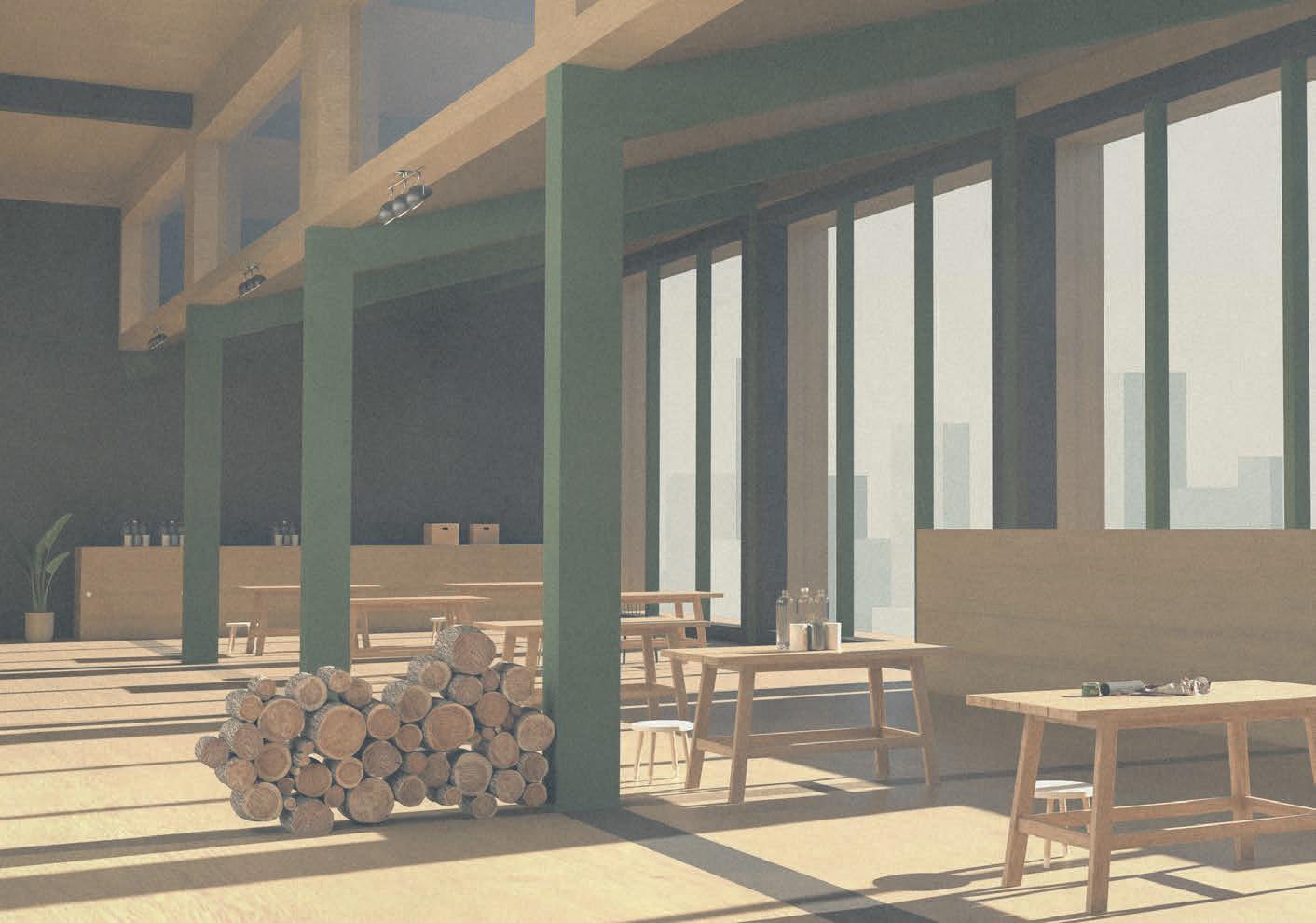


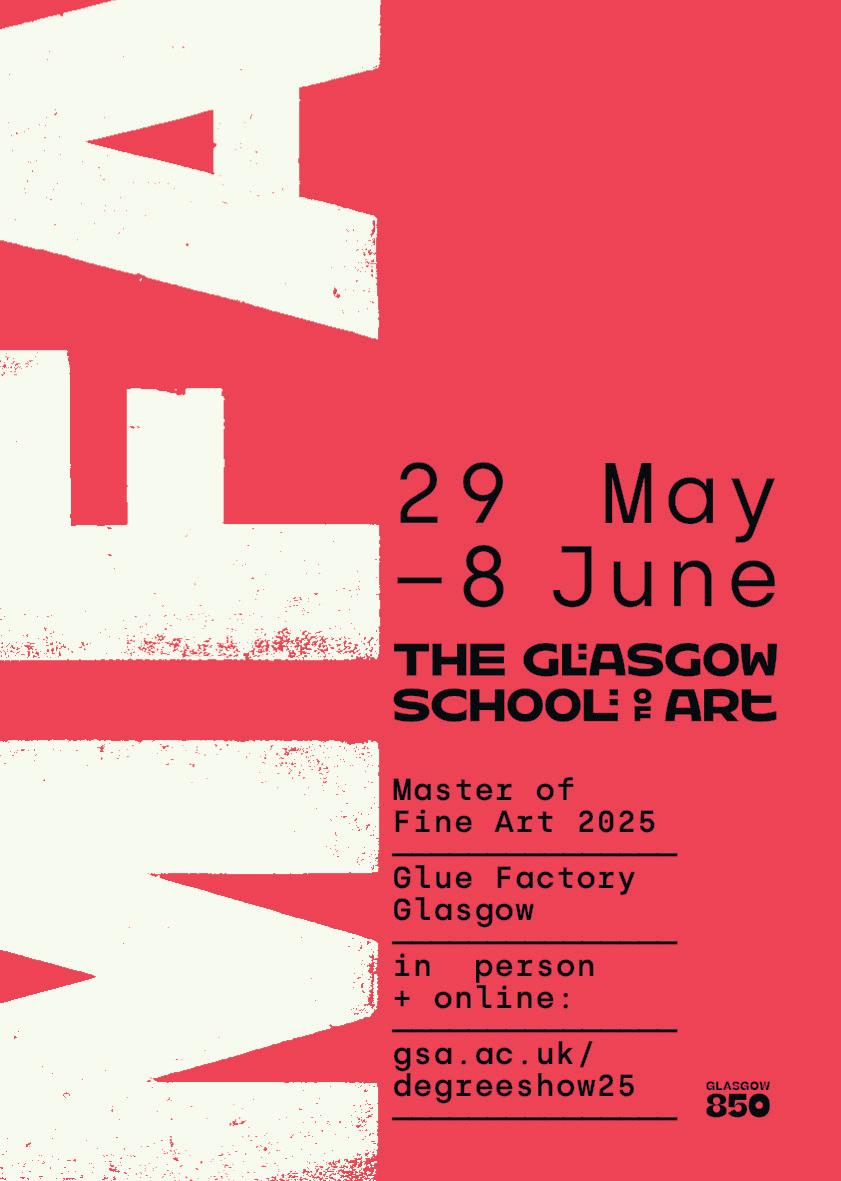
Moving through the fragile spaces between decay and desire, this year's MFA cohort bring a sharpened sensitivity to the overlooked architectures of daily life
Words: Yuchen Liu
The Master of Fine Art Class of 2025 have produced works that sift through the residue of the ordinary, searching for new forms of belonging, memory, and meaning amidst a landscape of erosion and uncertainty.
Rather than chasing the spectacular or the monumental, many of this year’s artists put their attention to smaller fractures – the unnoticed edges where time, labour, and memory quietly leave their marks. Across the Degree Show preparations, what emerges is not a singular vision but a shared impulse: to linger in spaces of fragility, and to rework the remnants of daily experience into something stubbornly resonant.

Drawing from the quick, informal marks scattered across the city, Jennifer Aldred’s work captures the ways people leave traces of themselves in public spaces. In drawings like Ian, she gathers gestures from scratched bathroom doors, layered billboards, and the faded remnants of renovation sites, reassembling them into dense, layered compositions. Alongside these urban fragments, she introduces small objects, like toy cars and plastic nameplate pendants, flattening and enlarging them through drawing until they slip between the personal and the symbolic. Her practice reflects on the human urge to assert presence in fleeting ways, and on how these signs, like a scrawled name or a fake diamond’s shimmer, once vivid, inevitably blur, overlap, and transform over time.
This attention to the overlooked extends into William Armstrong’s paintings, which explore the forgotten peripheries of the city. Through long walks across industrial estates, petrol stations, and retail parks, he documents landscapes shaped for vehicles more than people – spaces where human movement feels tentative, even misplaced. His canvases reconstruct these peripheral sites with a quiet tension, balancing the starkness of infrastructural decay with moments of unexpected lyricism. Armstrong’s practice su ests that even the most transient and utilitarian spaces bear the imprint of uncertain human presence. Labour, emotional fatigue, and the contemporary condition lie at the heart of Sophie Stewart’s practice. Her sculptural interventions – rusting restaurant bill trays, faux-concrete lottery stands, and found objects –confront the dehumanising realities of precarious employment, where enforced
optimism – like 'Yes I can' – rings hollow amid burnout and economic uncertainty. These quiet disruptions reveal both the illusion of hope and the weight of entrapment, offering a sharp yet humorous critique of consumer culture and societal expectation.
A different kind of intimacy unfolds in Matthew Kriske’s living-room-like installation, where watercolour paintings shaped like Polaroids cluster across softly painted walls and spill into the space. Each painting, delicate and translucent, evokes a fragment of memory – a scene glimpsed, a feeling half-held. Paired with a murmuring sound piece of confessional poetry, Kriske’s work constructs a domestic atmosphere that feels both familiar and slightly unmoored, as if the notion of ‘home’ were constantly rearranging itself. His practice su ests that family, home, and identity are less fixed entities than mutable fields, stitched together through dreams, losses, and the blurry sediment of everyday life.
Similarly attentive to the poetics of memory, Sophia Archontis layers handwritten poems, photographs, and sound recordings to evoke the shifting terrains of nostalgia and self-discovery. Her sound pieces, built from overlapping voices reading the same text, produce a disorienting yet tender chorus, where rhythms slip, words dissolve, and the act of remembering becomes a shared and unstable experience. In one handwritten line, she asks: “What does thinking sound like?” – a question that resonates across the exhibition, where thought itself becomes something audible, fractured, and unresolved.
Throughout the Degree Show, there is a palpable sense of artists resisting closure. Meaning remains provisional; images blur, fade, and erode rather than crystallising into fixed forms. Whether moving through the detritus of urban space, tracing the emotional sediments of labour, or navigating the porous landscapes of memory, these practices refuse the polished spectacle often demanded of contemporary art.
Instead, what they offer is slower, riskier: a sustained attention to what might otherwise disappear, a commitment to working with and through fragility. In an era dominated by speed, surface, and certainty, MFA artists this year remind us that there is still quiet defiance – and a different kind of endurance – to be found in assembling something lasting from the scattered, worn materials of experience.
MFA Degree Show, The Glue Factory, Glasgow, 29 May-8 Jun
The Degree Show isn’t the only event to look forward to at the GSA this summer. Here are some events, exhibitions and talks open to the public
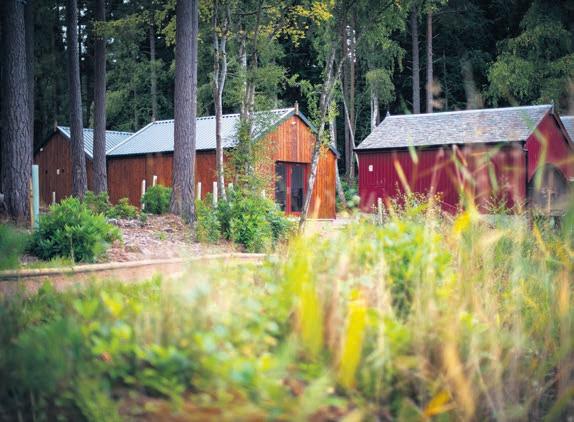
GSA Highlands & Islands Summer Show
6 Jun, 11am-8pm, Altyre Campus, Blairs Farm Steading, Altyre Estate, Moray, IV36 2SH
An exhibition showcasing work from the GSA Highlands and Islands campus, generating future opportunities for collaboration across the region in learning, research and knowledge exchange.
GSASA Degree Show Afterparty 2025: The Last Dance!
29 May, The Vic and Assembly, 10pm until late
The Vic and Assembly is the place to be for students and friends celebrating the success of their exhibition previews. DJs Town Centre, Honey and Naman are in The Vic from 10pm, while GSA student radio station Hill52, Eclair Fifi, and Spencer take over the Assembly Hall from 11pm. This rite of passage is one for the books and should not be missed. We’ve leaned into a Y2K, American prom aesthetic with an


Open Studio Summer Exhibition
30 May-8 Jun, Fleming House, 134 Renfrew Street
Running in person and online, the Open Studio Summer Exhibition will feature work from the GSA Widening Participation programme, the Castlehead School of Creativity and the Glasgow Clyde College Associate Student Scheme.
Wastelands and the City
11 June, Reid Auditorium, The Glasgow School of Art, 164 Renfrew Street, 3-5.30 pm
In our fourth seminar in the Wastelands and the City series, entitled Re-making from Waste: Re-imagining Glasgow with time, space and nature, with Frances Robertson, Callum Sutherland, and Seamus Connelly, will focus on different areas of the City of Glasgow. In this session, we bring together an artist-theorist, a human geographer, and a public servant to think dynamically and openly about the possibilities afforded by such sites as well as to reveal the engagements already taking place in the city.

Preparation – Creative Practices Course
Courses running from June
The Portfolio Preparation course is a great way to learn about crafting a portfolio in a collaborative and welcoming studio environment. Ideal for those intending on applying to art schools, the course is structured to help you choose an area of art and design to study, and has a track record of getting students places at top art schools across the UK. Visit the Study pages on the GSA website for more information on the course and how to apply.
Postgraduate Degree Show 2025 29 Aug-7 Sep
Just a few weeks after Degree Show, you can explore a showcase of work from students on Postgraduate programmes across the GSA. You’ll find innovations in design and technology alongside explorations in sculpture, painting, printmaking and fashion. And just like the undergraduate Degree Show, there is an online showcase which gives you the chance to experience the show beyond exhibition spaces. Visit gsapostgradshowcase.net for more information.
Switch Track, Victoria Morton 28 Jun-9 Aug, Reid Gallery, Reid Building, 164 Renfrew Street, Mon-Sat 10-4.30pm
Switch Track is a survey show of selected works from 1995–2025. This period represents 30 years of painting since Victoria Morton graduated from the Master of Fine Art programme at The Glasgow School of Art in 1995. Morton lives and works between Glasgow, Scotland, and Fossombrone, Italy. She studied painting and mixed media at the GSA from 1989 to 1995. Morton’s practice has encompassed painting, sculptural assemblages, photography, and sound. Her paintings vary in scale, opacity, colour and spatiality, each distinctly painted composition has been developed with a degree of intricacy and intuition. Influenced by musical composition, colour perception, everyday life alongside personal narratives, historical and cultural references, Morton’s works explore a continuously unfolding visual, spatial and psychological experience.

CATALOGUE: 25 years of Centre for Advanced Textiles at GSA
13 Sep-18 Oct, Garnethill Gallery, Reid Building, 164 Renfrew Street
This retrospective exhibition explores the groundbreaking innovation and lasting contribution to the textile industry embedded in the 25-year history of the Centre for Advanced Textiles (CAT) at The Glasgow School of Art. The exhibition will present a diverse and captivating overview of work from key moments of CAT’s 25-year history. The Centre provides a pioneering educational and commercial digital fabric printing and textile design service, consulting with students and staff at the GSA as well as high profile commercial clients and members of the public. The chosen works exemplify how CAT’s expert team has collaborated with clients to push the boundaries of digital textile manufacturing.
Damian Barr: The Two Roberts Author Talk 9 Sep, 7pm, Reid Building, 164 Renfrew Street
The Two Roberts is a love letter to Bobby MacBryde and Robert Colquhoun, two near-forgotten stars of the 1930s art scene who met at The Glasgow School of Art. Barr will deliver a talk about the creation of the book, and his process of drawing on real lives to recreate the past. Stunningly reimagined, The Two Roberts is a profoundly moving story of devotion and obsession, art and class. It is a love letter to MacBryde and Colquhoun, the almost-forgotten artists who tried to change the way the world sees – and paid a devastating price. Event in association with Waterstones.

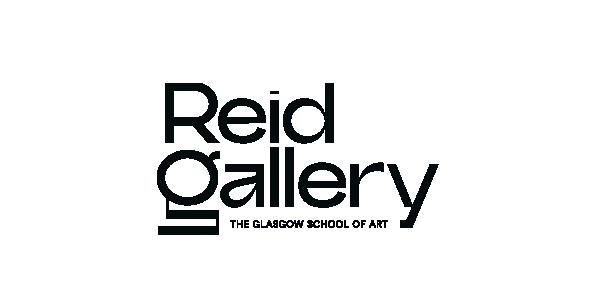
SurvØY: an artist survey of an island, Saoirse Hi ins and Jonathan Ford 20 Sep-1 Nov, Reid Gallery, Reid Building, 164 Renfrew Street, (MonSat 10-4.30pm)
SurvØY is a four-year Creative Scotland-funded project developed as a contemporary artist ‘island almanac’, surveying and monitoring varying scales of change in the context of the island environment of Papa Westray, one of the Orkney islands. In particular, the exhibition focuses on multiple viewpoints for resilient, caring, adaptive systems, providing a model benchmark to measure against for future generation islanders, islands and communities in times of rapid environmental change.

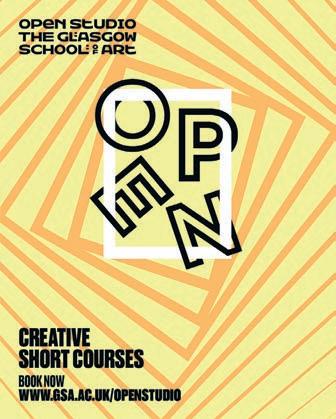
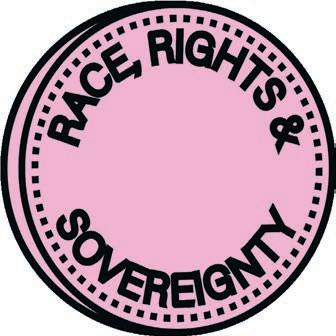
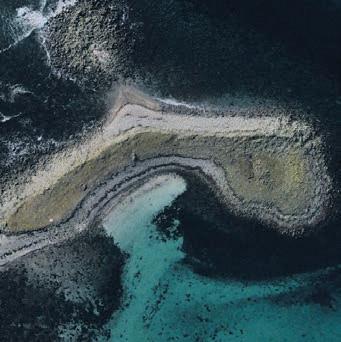

War and Pieces of a Garden, Ian Hamilton Finlay 1-22 Nov, Garnethill Gallery, Reid Building, 164 Renfrew Street
This exhibition in the Garnethill Gallery marks the centenary of celebrated Scottish artist Ian Hamilton Finlay (1925–2006). Finlay is internationally recognised as a poet, writer, visual artist and gardener, and is best known for the garden Little Sparta, set in the windswept Pentland Hills of southern Scotland. The exhibition draws upon works from GSA Library Special Collections, alongside a number of prints and photographs from Finlay’s friends and collaborators.
Open Studio Summer Courses
Courses running throughout summer
The Glasgow School of Art’s Open Studio offers a range of creative short courses for both adults and young people. Courses for Young Creatives (7-15 years old) will run in week-long blocks between 28 July and 4 August, with classes bookable in morning or afternoon groups each day of the week. Young people can get to learn about what they like within art while picking up some skills in a range of areas like photography, creative sculpture and ceramics, graphic design and 2D and 3D making. This year’s summer courses for adults are ideal if you’re looking to hone a new skill or develop your practice within a specialist area. Courses include painting, wood carving, sculpture, graphic design, and jewellery.
Established as a partnership between GSA’s Students’ Association (GSASA) and GSA Exhibitions, this public event series explores the relationship between race, place and creative practice. Events in the last year have included public lectures and artist-led talks, events and performances with Marline Smith, Camara Taylor, Alycia Pirmohamed, and Lisa Williams. Race, Rights and Sovereignty is currently programmed by artist, curator and researcher Beulah Ezeugo.

For the last iteration of the festival in 2024, the GSA hosted a talks with renowned artists Robert Henke and Martin Messier. Henke’s work draws together the worlds of art and engineering to create audio visual installations; whilst Messier creates works in which sound meets images and objects in the form of performances and installations."
Whether you’re just starting to consider coming to art school, or you’re almost ready to hit ‘send’ on your application, GSA OPEN offers events to support you at whatever stage you are on your application journey. Our year-long programme encompasses campus open house events, student-led campus tours, portfolio advice sessions and one-to-one sessions with staff. Find out more on the GSA website.

Released 6 June by AWAL Recordings
rrrr r

Little Simz is a trailblazer. Many will have first recognised the London rapper and actor via her Mercury Prize-winning album, 2021’s Sometimes I Might Be Introvert. But her journey up to now goes much deeper.
Shortly before releasing her debut album A Curious Tale of Trials + Persons, Kendrick Lamar was already citing Simz as “the illest [rapper] around right now”. Tracks such as the iridescently fierce Venom and the old-school R’n’B-infused Selfish further illustrated Simz’s artistic versatility – both of which propelled her third studio album Grey Area to lofty heights. The grandeur of SIMBI followed (a shortening of Simz's first name Simbiatu) along with 2022’s surprise-release No Thank You. Now, she’s at the height of her powers. So, what does Lotus, her sixth studio album have in store?
In short, there’s nods to her already expansive palette in what’s come before, with added glimpses to completely new sides of her artistry. Thief opens proceedings with the moody aura of Grey Area, pulsing with punchy drums and atmospheric reverbs. Flood (ft. Obongjayar and Moonchild Sanelly) hisses with the ominousness of Drop 7’s Mood Swings, while Only (ft. Lydia Kitto) and Lion (ft. Obongjayar) shine with the soulful grace and textural African rhythms of SIMBI respectively.
Find reviews for the below albums online at theskinny.co.uk/music
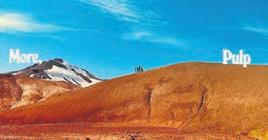

Young is where things completely change. A rare, light-hearted moment from an artist renowned for her unrelenting craftswomanship, the track’s music video encapsulates the fun that Simz may be open to exploring more going forward creatively. Blood is similarly experimental in style, harnessing palpably emotional exchanges between Simz and Wretch 32 on the pressures of family life, suppressing trauma, and utilising music as a source of solace.
The latter is portrayed further in the album’s closing moments. Despite hitting a peak in her career, an accompanying press release mentions that Simz hit a low point approaching Lotus; self-questioning her confidence and whether her journey had now run its course. Lonely highlights this starkly, but the album’s title track unravels her introspective side best. Her loaded lyrics on being a human within the public eye intersperse beautifully with longtime collaborator Michael Kiwanuka’s comforting vocal lines: ‘My pain is a glory / You kept trying to control me / But your God isn’t for me / So I’ll be moving on’.
A confessional album that owes more to belief and soul-searching rather than a sense of direction, Lotus sees Little Simz blossoming from a dark spell into new light. [Jamie Wilde]




Until Raspberry Moon, Hotline TNT was essentially the solo project of Will Anderson, with a revolving door of backing musicians and internecine disputes. But with the (reluctant) surrender of full control comes an album that is bi er in both sound and heart: a true embrace of community and emotional transparency. The towering wall of guitars are immediate on Was I Wrong?, a mini-epic that shows that insecurities can be kept at bay as long as your band has your back (a running theme).

Listen to: The Scene, If Time Flies
Hotline TNT have always been shoegaze-adjacent, but Raspberry Moon is a full-throated embrace, and towards the end there’s a genuine sense that the graft is finally paying off. Candle is vomit-inducingly saccharine on the lyric sheet, but Anderson’s treacle-slow delivery makes you sit with these remarkably open sentiments. Anderson has never met a syllable he couldn’t draw out to three and if you’re in the right frame of mind there’s something downright heart-warming about an elongated line like: ‘I’m not scared / To / Find new things / To / Share’. Raspberry Moon brings out the best of what Hotline TNT have to offer; it’s an emo-shoegaze-indie-noise-pop melting pot that hits just right.
[Lewis Wade]

her picture Feed Me Hope EP self-released, 20 Jun rrrrr
Listen to: Can’t Think, Muscle Memory, Big Girl
It’s been over two years since her picture first turned heads with their impressive debut EP, Don’t Try To Comfort Me Now the Glasgow trio are back with their sophomore effort, Feed Me Hope, we’ve half a dozen more reasons to be hyped. Whilst fifty percent of Feed Me Hope was previously released as singles, this is a concept record so best enjoyed whole.
The introductory Styx’s Curse sets a tranquil yet macabre scene, its chanted vocals and sombre, creaking instrumentals creating a sense of impending doom, whilst Can’t Think builds weirdly danceable and apocalyptic crescendos of distorted guitar riffs, thumping drums, and haunting vocals.
The EP’s centrepiece, Muscle Memory, gets its own intro track (Fear Like a Father) – and deservedly so. With its stomping riffs, misty Celtic melodies, warbling synths and towering vocals, it’s arguably the strongest song here. The penultimate track, Reasons I Tried, is a beautifully performed, heartwrenching piano ballad. Such a sonically and lyrically devastating experience needs a palate cleanser; fortunately, it’s followed by Big Girl, a slow burner that builds to an unforgettable life-affirming climax with a brief yet irresistible closing fanfare. An incredible EP from a promising young band. [Christopher Sneddon]
The extended Rock Family Tree for Glasgow grows another branch with the release of Water Machine’s debut LP, a propulsive, addictive set of tunes which showcases a diverse range of styles and influences. There’s the DIY noise of Hu y Bear, the energy of X-Ray Spex, and the lyrical fun of The Vaselines. This is not a relentless ride though – there are tender moments of reflection (notably Jimmy’s Waltz) which show a softer, more vulnerable side to the band.
It’s a record which you feel could only have been made in Glasgow. Tiffany is pure Orange Juice, while Hot Real Estate muses on the merits of different sides of the city; Water Machine feel like one of those great Glasgow bands like V-Twin, 1990s, or Lung Leg, who are much more interested in people having fun than taking themselves too seriously.
If you were looking for fault, the only angle would be that perhaps some of the passion, chaos and humour of a Water Machine live show hasn’t quite translated to the record. It’s a minor grumble in a set of songs which move Water Machine firmly into the “ones to watch” category. [Andrew Williams]

Listen to: Flower Moon, Really Wanna Be With You, If Not For Love
The most exhausting jobs we’ve yet to devise within capitalism are: oil rig journeyman, movie theatre janitor, and contemporary soul songwriter. There’s an almost patriotic sense of bravery it takes to approach with open hearts and ears a sound which has been divined by music gods, conquered, gentrified, historicised, and plundered like soul. Durand Jones and co. take on the herculean task of writing unique soul and R’n’B tracks every morning at breakfast, and by lunch, the Marvin Gaye worshipping part of their brains has already taken over. Not only is originality not the point here, it’s so disdained in these parts that an executive order for its removal is three days out.
Flowers is another lunch-line scoop of hearty 70s soul revivalism from music’s most dependable dispensary. It’s just on the underside of too pretty for its own good, ‘love’ is said the prerequisite three times per line, and Durand Jones doesn’t just have pipes, he has the whole damn organ in his chest. We have SAULT for restless innovation; Flowers is our nostaglia taking shape. Why not see if all that Motown was as good as you remember? We’ve advanced so far, the past is still right here. [Noah Barker]

Barnes
Watch That Ends The Night Records, 6 Jun rrrrr
Listen to: Black Orpheus
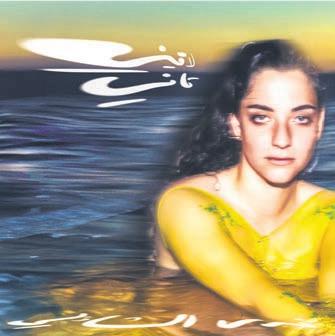
El Shazly Laini Tani
One Little Independent Records, 6 Jun rrrrr
Listen to: Ghorzentein, Laini Tani, Dafaa Robaai
‘Just like I imagined / Just like I pictured it’. So opens Quinton Barnes’ genre-fusing opus, BLACK NOISE, created in just over a week with an assortment of free-jazz improvisationists and multi-instrumentalists. Such a proclamation, might seem contradictory, but the spontaneity is by design.
For Barnes, his ruminations on religion, racism, artistry, sexuality and the nature of existence demand the grandest spectacle imaginable. On the title track, Barnes’ androgynous vocals fight for primacy over funk bass, dissonant trumpets, tremolo strings and syncopated guitar lines – imagine Frank Ocean jamming with The Mars Volta. On What Would Eastman Do?, he moves between breathless multisyllabic rhyme bursts and impassioned melodies in the blink of an eye.
The highlight – also, the clearest insight into Barnes’ psyche – is the unsettling nine-minute Black Orpheus. To expound on the limits that are imposed on Black cultural expression, he draws from the Greek mythogical figure who symbolised art’s very power to transcend death. It is powerful, but in truth, it’s the one track that doesn’t feel unfinished, as Barnes’ voice finally rises above the overwhelming mix that he’s buried under throughout the album.
[Jonathan Rimmer]
It’s eight years since Nadah El Shazly’s debut, but her works since point to an artist still open to bringing in new sounds, one with a freeform approach to influence, intent on channelling as much as possible through her blend of experimental electronics and traditional Arabic influences. This instinct remains on Laini Tani, songs clearly bearing the influence of myriad sonic worlds, but it’s strange that they manage to coalesce into music quite so characterless. Her voice remains gorgeous, but tracks like Banit and Elnadaha never lift beyond a plod; never seizing in the way you know her work can.
Then, from the throbbing opening of Enti Fi Neama it’s as if a switch has flipped, and the record suddenly finds its feet. The drums kick harder, and the synth tones are crunchier, but it’s the way they clash together that really makes them grab, as on Dafaa Robaai where the sickly bass sloshes into something wonky and undefinable. Closer Ghorzetein is the undoubted highlight though, a nocturnal hurtle through a collapsing cityscape, a crystallisation of the arresting Magpie-ism of her best work; it’s a shame it’s a feeling only patchily displayed on this album. [Joe Creely]

King Gizzard & The Lizard Wizard Phantom Island p(doom) records, 13 Jun rrrrr
Listen to: Phantom Island, Deadstick, Sea of Doubt

Frankie Cosmos
Different Talking Sub Pop, 27 Jun rrrrr
Listen to: One! Grey! Hair!, Bitch Heart, Your Take On
Prolific Australian jam band, King Gizzard & The Lizard Wizard return for their 27th album Phantom Island, with a focus on journeys both metaphorical and literal, as each track plays on themes of being lost and found, wrapped up in an orchestral rock soundscape. The upbeat Deadstick features a crashing pilot contemplating their final moments over campy rock instrumentation, the track’s catchy refrain referencing the pilot’s lack of control over his aeroplane. Others are even less fortunate, like Aerodynamic’s character who, after being struck by lightning, accepts their watery fate, reasoning that the sharks have to eat too. But not everyone passing by Phantom Island is doomed. Sea of Doubt has our protagonist lost at sea without direction or assistance and yet he prevails against his metaphorical marooning through the power of friendship. While some tracks like Panpsych and Eternal Return remain lost at sea – the latter’s lurching tempo is a bit of an auditory mess – KGLW’s experimentation with brass, strings, and woodwind definitely hits more than it misses. Drawing together calamity and fortune in a novel way, 15 years in, Phantom Island shows a band still having fun making music together.
[Oscar Lund]
Scattered across 17 tracks which never stray over three minutes in length, the latest album from Frankie Cosmos, Different Talking, jumps between fragmented memories. Album opener, Pressed Flower is an ode to loyal listeners reminiscent of 2022’s wistful Abigail. Bitch Heart yearns for connection to nature through hazy harmonies and gentle synths. Frenzied drums echo the humdrum of modern life.
Frontrunner Greta Kline’s storytelling is at its most honest through snapshots of stories blurring like ripped journal entries. If Joyride romanticises the musician life, Not Long agonises over professional abilities. Vulnerable songwriting nevertheless represents universal themes of growing pains, regret and past selves. Crescendos of mystical synths and jovial melodies in One! Grey! Hair! almost mask the lyrical lament of lost time. The unpredictable tempo denies preservations of youthful wonderment; ‘The idea of growing up doesn’t even cross my mind’.
Moments of rock brilliance are scarce. Your Take On, with dissonant 60s-esque guitars and talk-singing, is a jolt from whisper-soft vocals surrounding 2022’s Inner World Peace. Later tracks see development sacrificed for quantity. Despite treading familiar territory, Different Talking’s soothing melodies are tailor-made to accompany life’s quiet corners. [Juliette Pepin]
In what’s sure to be a bright summer, Pippa Blundell, Brìghde Chaimbeul and M. John Henry bring folk sounds fizzing to the top, but our June recommendations span hip-hop, spiritual jazz, and Elisabeth Elektra’s synth-pop book of spells
Words: Ellie Robertson
There were marvellous records that we missed in the May column, like the intricate, prog-pop album Clients of Suddenness by Louise Connell, or pop-rock band Copper Lungs’ debut Broken Beautiful, the intimate acoustic EP Rent Is Due by Francis Bondd, the introspective pop of Erotic and Mostly Empty by Possibly Jamie and the gorgeous widescreen folk-rock of Glasgow outfit Lacuna’s new EP What If I Told You I’d Been Lying the Whole Time. Give them a listen, and then catch up on some singles from KuleeAngee (Push It), LAMAYA (Walk Away), Maaike Siegerist (Cosmonaut), Erin Meg (Drenched), TEOSE (Part II) and Ellyn Oliver (Dressed in Daylight).
As for June, arriving at the height of the month is the second album from synth sorceress Elisabeth Elektra. Named after Scottish comic book writer Grant Morrison’s concept of an artwork that also functions as a spell, Hypersigil (13 Jun) is a reliquary for all the Glasgow artist’s willpower and charm. The fascination with magic that has influenced Elektra’s discography since her 2020 debut Mercurial is perhaps what has also led to such a rigorous and ritualistic composition style, and the resulting, bewitching record.
The main elements of Hypersigil are buzzy, banging synth stings, and Elektra’s rich, ethereal vocals. Yearning opens a heavy storm of scuzzy drumbeats, over which the synth-pop priestess’s voice dominates; but only the faintest veil of instrumentation introduces Surround Me, where Elektra shows the place of quiet and solitude from which she can build a performance. The relationship between Elektra and electronics shifts from track-to-track, but the fusion always shines brightly. In flashy, 80s-adjacent dance hit Desire, Elektra takes the form of Madonna, and Unbreakable is an amped-up ballad about resilience, with bright chimes appearing like guiding stars. With the assistance of CHVRCHES’ Jonny Scott, Elektra has concocted a bespoke album, each track a talisman, refined to reflect a new dimension of her artistry.
Until then, get excited for 6 June, when Bridge the Gap release Pippa Blundell’s common thread. Blundell’s first album is a journal of tender lyricism, with the words having come to her in travels between Marseille and Glasgow; the high altitude of her flights across the Channel undoubtedly inspired the dreamy imagery, full of longing for the more grounded points of her past. The third track, lay of my land, scribes ‘Well it’s so good to stay with you / Now you’re miles away / I remember the shape of you / Left indents where we lay’. Blundell confronts unwanted temptations in a dusty country ballad called crave, while will to take is a fireside acoustic requiem for a dark night


of lonely memories. The guitar is Blundell’s constant companion on her travels, but the busier jazz accompaniments on opener say, and the title track, are ornate enough to still complement Blundell’s breathy, heartfelt delivery.
Smallpipes virtuoso Brìghde Chaimbeul is back with Sunwise (27 Jun) via tak:til / Glitterbeat. Since 2023’s Carry Them With Us, the two-time SAY Award nominee has only deepened her understanding of this oft-overlooked instrument, resulting in a folk record like no other. The organic drone effect of the pipes is fully embraced across Sunwise, creating metronomic, almost mechanical, rhythms, particularly in songs like A’ Chailleach and She Went Astray.
Following on from his return to the scene as a member of Jewel Scheme, former De Rosa frontman M. John Henry releases Strange Is the Way via Gargleblast Records (20 Jun), a collection of ten heavenly, folk-rock ballads, that centres intricate guitar technique and an illuminating use of effects. Folk fans are well-fed this month, as the surrealist cabaret performer Paul Vickers collaborates with folk-punks The Leg for Winter at Butterfly Lake (9 Jun), a twisted storybook of icy vignettes that dance between theatrical and discordant.
Another collaboration that raises the temp this summer is that of Conscious Route and Supermann on da Beat – the Edinburgh-based rapper and MC has teamed up with the prolific Ayrshire beatmaker for LP Shadows (17 Jun). When it’s too hot to headbang, perspiring punks should have a drink of God Park (20 Jun), a refreshing art-rock record from Glasgow’s Water Machine. Turn to p66 for a full review, and if you’re hungry for more, Feed Me Hope, the new EP from her picture, also appears in the review pages.
Speaking of EPs, we’ve longed for Azamiah’s follow-up since their debut In Phases was our album of the month two Junes ago. Where In Phases was grounded and meditative, the spiritual jazz collective’s new EP Two Lands (3 Jun) has an almost extraterrestrial groove. There are also debut EPs worth checking out, like Everything Worth Having by Folke (13 Jun) and Broken Pieces by So So Sad (15 Jun), plus, some sunnyweather rock singles and uptempo anthems like Sleeping by Maxwell Weaver & The Fig Leaves or Wallace by Bad Knees (both 6 Jun). Maya’s Radio Orchestra drop Garden Variety on the 11th, and on the 27th Carl Marah gives us Roll the Dice.

Scan the QR code to follow and like our Music Now: New Scottish Music playlist on Spotify, updated on Fridays
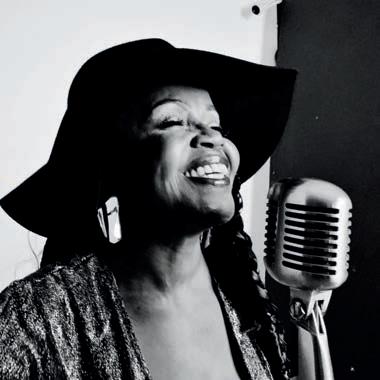


4th Ma tha Wainw ight 5th Rastak; Tales of Ea th and Sun
8th
16th
AMPLIFI: Pillz the Ene gise - AKA P inceAiysha
12th Bôa
13th Emma Kenny’s – Kille Couples
21st Reem Kelani and he T io
23rd St Ma y’s Music School Summe Conce t 2025
26th Jac ui Dankwo th with Cha lie Wood
27th The Phoenix Choi
28th Kid C eole & The Coconuts




Edinbu gh Jazz & Blues Festival: Julian Lage T io featu ing Jo ge Roede and Joey Ba on + suppo t
17th Edinbu gh Jazz & Blues Festival: Cu tis Stige s
18th Edinbu gh Jazz & Blues Festival: Colin Steel: STRAMASH
19th Edinbu gh Jazz & Blues Festival: co to.alto + suppo t
20th
24th Dexys’ Kevin Rowland - A Life Sto y In Conve sation July
Edinbu gh Jazz & Blues Festival: A Ve y Special Evening with Kenny Wayne Shephe d and the Legenda y Bobby Rush
9th13th Ka ine Polwa t: Windblown 16th Lindisfa ne
17th18th
Fleetwood Mac’s ‘Rumou s’ with the T ansatlantic Ensemble
21st Withe ed Hand and F iends
22nd PP A nold - ‘Soul Su vivo ’
31st Edinbu gh Psych Fest 2025

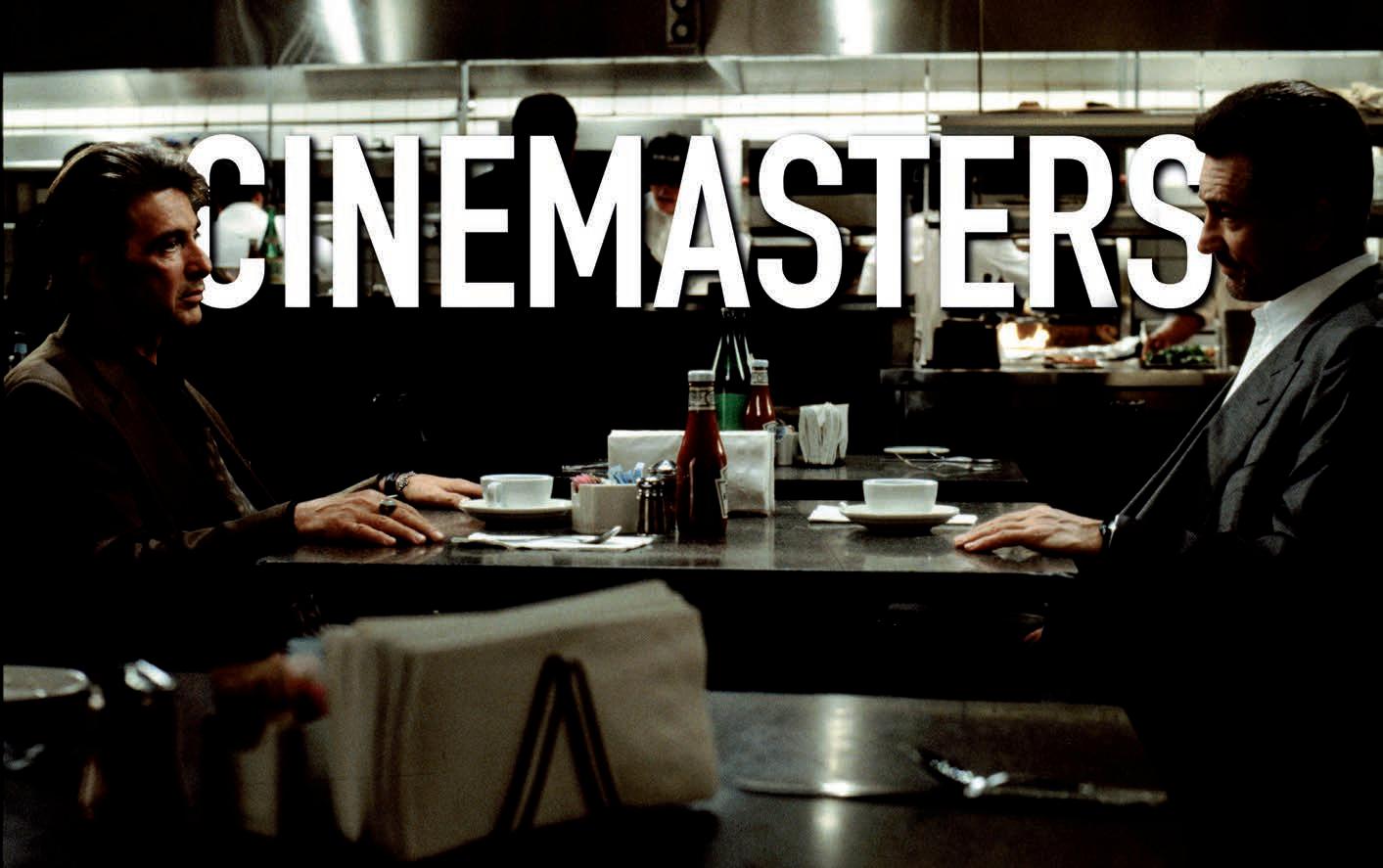
MICHAEL MANN MICHAEL HANEKE
Manhunter
Heat - 30th anniversary
The Insider
Collateral
Miami Vice
The Piano Teacher
Funny Games
Code Unknown Hidden The White Ribbon
Words and music take fight with singer Héloïse Werner.
Mon 9 June
Rossie Byre, Perthshire
Tue 10 June
Strathpeffer Pavilion
Wed 11 June
Aberdeen Art Gallery
Fri 13 June
Kelvingrove Art Gallery & Museum, Glasgow
Sat 14 June
National Museum of Scotland, Edinburgh
Mon 16 June
V&A Dundee
scottishensemble.co.uk
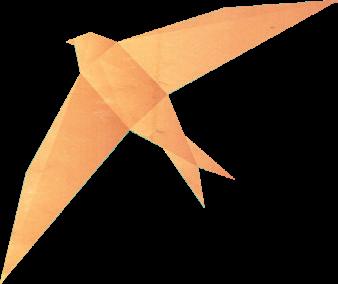
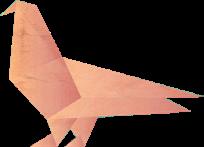






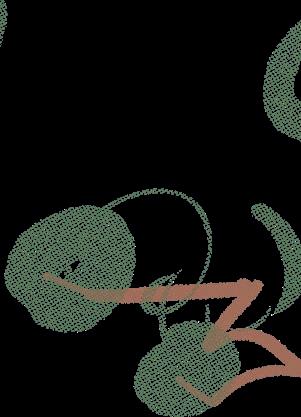
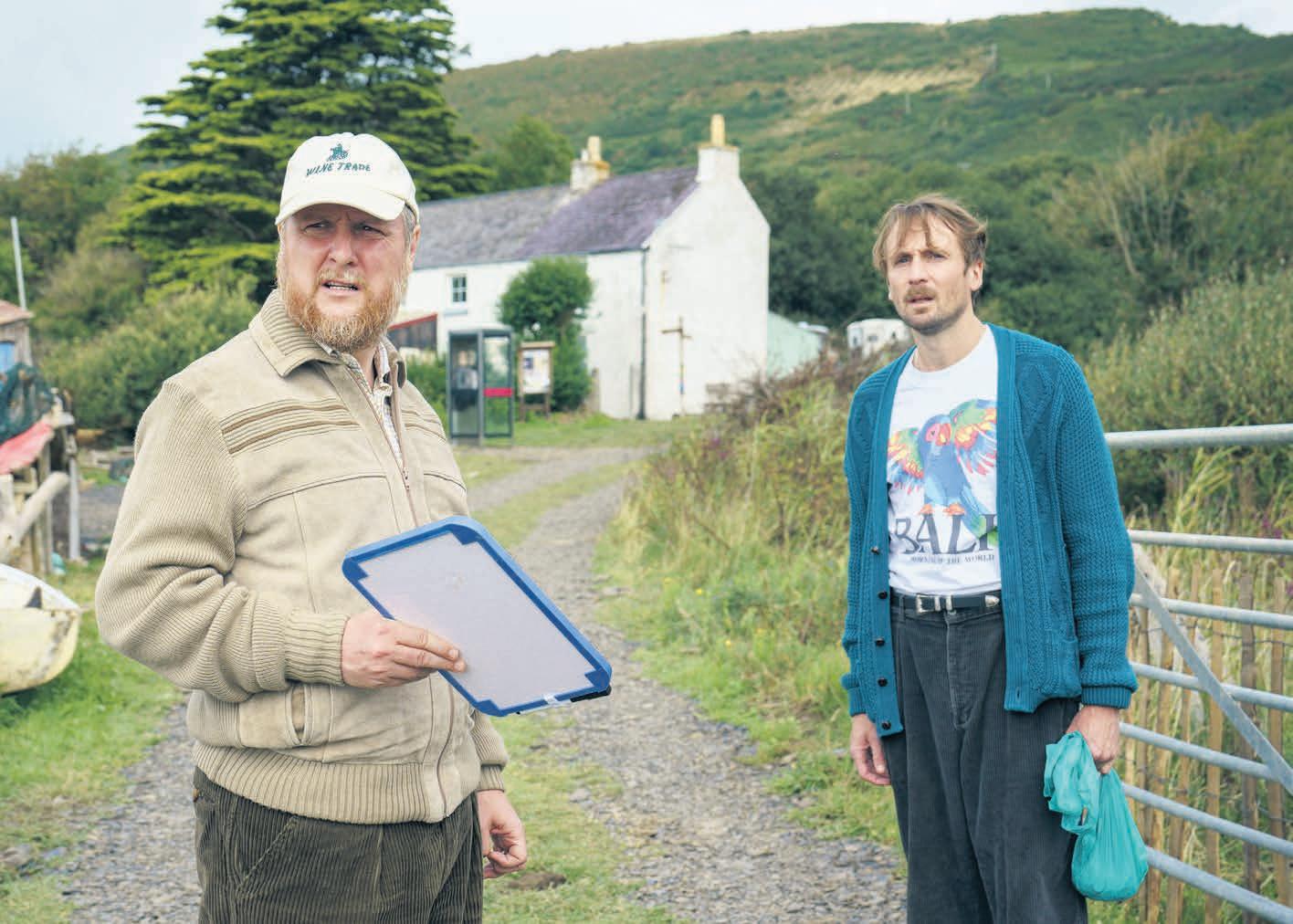
Director: James Griffiths
Starring: Tim Key, Tom Basden, Carey Mulligan
RRRR R
Released 30 May by Universal
12A
The Ballad of Wallis Island gives an answer to the question: What would happen if you invited your favourite musician to ditch a big venue and play a show for just one person – yourself? While this remains a dream scenario for most, eccentric two-time lottery winner Charles (Tim Key) makes it a reality when he summons his idol, tormented folk songster Herb McGwyer (Tom Basden), to the titular island.
Wallis Island is a remote isle off the coast of Wales where the nature is as stunning as it is temperamental. Here, there’s no harbour or phone service, and you’ll have a hard time finding what you need in the only, poorly-stocked shop in sight. Key and Basden reprise their roles from the short they penned in 2007, The One and Only Herb McGwyer Plays Wallis Island. Back on writing duties for the movie, the duo team up once again with the short’s director, James Griffiths.
Nearly two decades on, the humour is unaltered, with some of the short’s best jokes migrating verbatim. Yet, the feature’s scope allows for the nostalgic pull of the past and the meaning of art to be explored through a new character: Nell Mortimer, Herb’s former bandmate and lover, portrayed with warmth and self-assurance by Carey Mulligan, whose singing voice stand its ground alongside Basden’s in some of the (very good) songs he wrote for the soundtrack.
When Nell, who has left music behind to make chutney, arrives on the island with husband Michael (Akemnji Ndifornyen) in tow, it’d be too easy to mistake this dynamic as
the film’s love triangle. But Wallis Island is no romcom, or at least not the one you’d expect to see. The movie too often risks playing like an antihero’s journey for Herb, but Nell’s stubborn refusal to be confined to the ‘love interest’ box anchors the narrative in more neutral, compelling waters.
The real romance lies with Herb and Charles’ archetypical odd couple (one is a grump, the other a ray of sunshine). Their enjoyable banter carries the film through the sojourn’s highs and lows. The witty dialogue is a testament to Key and Basden’s longtime professional and personal bond, one that started when they were part of Cambridge Footlights and continued as they would perform in one another’s projects throughout the years.
Together they’ve created a beautiful friendship for their characters, who find a surprising, if fleeting, harmony in their respective loneliness. Never overexploited, Charles and Herb’s trauma is subtly woven in, which makes the film’s glimpses of laid-bare honesty feel like a hard-earned gift. No one is an island, and no role is too small in this delightful tableau – honourable mentions to Ndifornyen along with Sian Clifford as shopkeeper Amanda, whose freak perfectly matches Charles’.
The Ballad of Wallis Island celebrates transient connections with an emotional maturity it couldn’t have mastered 18 years ago. Some journeys take time, some you have to go through alone, but the film is a reminder that there is room for decent music, and people, along the way. [Stefania Sarrubba]
We’re so back! After a heroic rescue effort, Filmhouse is very close to opening its doors again. Ahead of its ‘soft launch’ at the end of June, we chat to Andrew Simpson and Rod White, the directors heading up the new iteration of this wonderful cinema
There’s been a hole at the heart of Edinburgh’s film community since 6 October 2022. That was the day Filmhouse, the city’s beloved arthouse theatre, closed its doors owing to the financial collapse of its parent company, The Centre for the Moving Image. The end of Filmhouse’s film programme, which made space for the type of films that don’t get much traction at the more commercially-driven cinemas in the city, was devastating, but just as crushing was the loss of Filmhouse as a community space where film-lovers could gather and share ideas.
Movies love a comeback story, though. After a lot of money-raising, negotiating a lease with the building’s new owners, and much hard work behind the scenes, including a heroic effort by volunteers who helped gut the building, Filmhouse reopens at the end of June.
As we go to print, renovations are still very much underway, and this isn’t just a spit and polish job; it’s a full overhaul, from new wiring to an upgrade of the previously tightly-packed cinema seating – great news for anyone taller than Tom Cruise. There’s even going to be a new cinema: a tiny 24-seater that’s being installed in an unused space in the Tardis-like building.
It’s proven to be a massive undertaking. Andrew Simpson, who’s joined Filmhouse as its new executive director, having previously been head of film at Tyneside Cinema in Newcastle, lists off the tasks still to be done once the building work is complete, which include installing the new cinema seats, removing the outside scaffolding and prepping the bar and kitchen.
“We’re rounding off and coordinating those many jobs. It’s sort of like Tetris, everything has to fit together very precisely.”
Rod White, who was the Filmhouse’s previous head of programming and a member of the ‘Open the Door’ team who led the cinema’s rebirth, will be returning as programming director. He tells us to expect a cinema transformed. “Filmhouse was, shall we say, a crumbling beauty that had seen better days,” he says. “What audiences will see now is a modern, attractive foyer and bar. The layout is pretty much the same, but it’ll be a total modernisation of all those public areas.”


It will be interesting to observe if the upgrade will lead to a change in attendees at Filmhouse. Despite being a ten-minute walk from the Edinburgh Uni campus, the cinema never appeared to fully capture that demographic. Anecdotally, the Filmhouse audience certainly seemed to lean older. When I put this to White, he notes that it did sometimes look that way, but internal research showed demographics weren’t as skewed as it appeared, although he admits they did consciously cater to an older crowd. “The organisation tended to ask its dedicated members, who
normally skew older, what they wanted to see, and then double down on that,” he says. Simpson seems keen to make sure Filmhouse will be “geared towards a wider audience, and that includes younger people,” and he’ll be introducing several incentives to make that happen. “There’s going to be a whole new membership scheme,” he says. “There’ll be a free membership for audiences under 25 that will make tickets incredibly affordable for younger audiences to encourage their attendance.” He’s also observed for himself a general shift in audience behaviour at his previous role at Tynecastle. “It does seem as though that Letterboxd, young cinephile generation that a lot of us have been talking about for years is starting to turn out for the sort of programming that Filmhouse presents.”
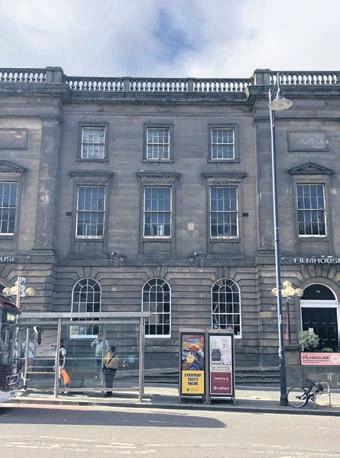
Filmhouse isn’t the only institution to have a phoenix-like return after going down in flames with the CMI. Edinburgh International Film Festival was also nearly lost before being rescued by Screen Scotland. But one thing EIFF has failed to do over its two editions since its resurrection is to create a central hub, like Filmhouse had been for EIFF in previous decades. With both organisations now back on their feet, can we expect to see them collaborating again this August? The answer seems to be… maybe.
“I’m going to give a very political answer for that,” says Simpson. “The festival obviously has an incredibly long and storied history with Filmhouse; that’s something very important to us. And while we can’t say anything with finality at this point, we very much hope to be involved in August.”
Filmhouse’s opening programme, and the exact opening date, is still to be announced, but White teases that there’ll be “a week of films that either didn’t show in Edinburgh because Filmhouse wasn’t there, or just didn’t get their due by virtue of there not being a Filmhouse to look after them.” Simpson also hints at some special guests who’ve supported the Filmhouse over the last two years, but he’s most keen for the whole of the city, and the wider Scottish film community, to be able to share this wonderful cultural asset again.
“What’s been incredible throughout the last couple of years is the enormous amount of love and support that everyone has given to the venue and the possibility of it reopening,” says Simpson. “All of that has played an enormous part in being where we are now. We wouldn’t be here without any of the people who very publicly supported us over that time. We’re excited to bring the venue back to the people of Edinburgh very, very soon.”
Castration Movie Anthology I: Traps
Director: Louise Weard
Starring: Louise Weard, Noah Baker, Aoife Josie Clements, Vera Drew rrrrr
Louise Weard’s hugely ambitious crowdfunded camcorder masterpiece is as visceral as you might hope for a film with a title like Castration Movie
The first 50 minutes of the four-a-halfhours-long part one, subtitled Traps, charts the pipeline speedrun of Turner (Noah Baker), from slacker/shitty-boyfriend to full-blown incel; but the anthology’s prime parable follows Michaela ‘Traps’ Sinclair (Weard), a sex worker whose irreverent, pugnacious personality obscures heartfelt contemplations of motherhood.
Traps takes the viewers from crusty queer flatsits to underground music venues, from heartfelt hangout scenes to unadulterated deviancy. The hand-held cinematographer captures unsimulated watersports, a real-life recovery from top surgery, and aching, improvised dialogues, all
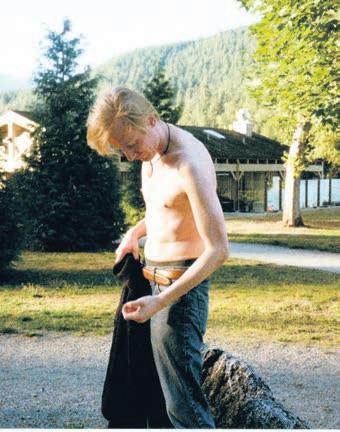
Lollipop
Director: Daisy-May Hudson
Starring: Posy Sterling, Idil Ahmed, TerriAnn Cousins rrrrr
Daisy-May Hudson’s often wrenching but ultimately uplifting drama Lollipop revolves around two women, Mollie (Posy Sterling) and Amina (Idil Ahmed). Friends all through childhood, they haven’t seen each other in years when a chance meeting brings them together at the start of the film. Amina is all warmth and wide smiles while Mollie seems stand-offish. In truth, she’s embarrassed – their meeting found Mollie on her way to see a social worker about regaining custody of her children, having recently been released from prison. What follows is a story reminiscent of I, Daniel Blake as Mollie tries desperately to navigate a system that seems to have been engineered to crush the life out of all those who enter it. Each new step in the process brings her to another dead end,
with the camera resolution you might expect from a snuff film.
Don’t be intimidated by the radical length: Traps’ punk attitude and obscenities make it endlessly watchable. And that generous runtime allows arcs to patiently develop, like the subplot following Traps’ childhood best friend, Adeline (Aoife Josie Clements), as she seeks to follow Traps’ footsteps into the liberating life of sex work. Characters try to respond to each other’s cries for help, unaware of how adrift they are themselves, and the theme of toxicity always slithers under the pixelated tableaux. But the filmmaker stays conscious of the pain that begets such belligerence, and in her incomplete, but monumental, debut, Weard has kept recording long enough to afford each and every asshole a humanising moment.
[Ellie Robertson]
Out now on louiseweard.gumroad.com Screenings in Dublin, Leeds, London and Manchester this June can be found on matchboxcine.com/castrationmovie

another interview with an uninterested bureaucrat, another hopeless paradox – she can’t get her kids back until she has a home, but won’t be provided with social housing while she’s still listed as a single woman.
“Keep pushing,” one social worker advises her. “Push where?!” an exasperated, exhausted Mollie replies. It’s an excellent lead performance from Sterling, the camera rarely straying from her as the story puts her character through the wringer.
Lollipop is not a subtle film, and at times it can even be downright ham-fisted. It’s not as richly layered as A.V. Rockwell’s recent take on a similar tale, A Thousand and One But the moments that do land, land hard. [Ross McIndoe]
Bogancloch
Director: Ben Rivers
Starring: Jake Williams, Alasdair Roberts rrrrr
British filmmaker and artist Ben Rivers has been making unclassifiable, abstract and experimental films for over two decades now, starting with his otherworldly shorts (Worlds on Second Run DVD is essential) through to his experimental documentary features such as A Spell to Ward Off the Darkness (2013) and Two Years at Sea (2011). The latter starred Aberdeenshire hermit Jake Williams, whom Rivers revisits in Bogancloch, a loose sequel. Somewhat comfortingly, it seems not much has changed in Williams’ isolated world since we last saw him floating on a home-made raft and falling asleep by a fire in 2011 – save for, perhaps, his new car and caravan.
Rivers crafts the kind of cinema that is the absolute antithesis of today’s hyperactive online culture. He trades in static shots rendered in

Tornado
Director: John Maclean
Starring: Kōki, Tim Roth, Jack Lowden Takehiro Hira, Joanne Whalley rrrrr
John Maclean, whose first film was the off-beat western Slow West, conjures up another tale of a youngster travelling through a mythologised historical wilderness with vivid brutality and not a wasted moment. His new film Tornado treads far less familiar cinematic ground, however: it’s a samurai movie dropped into 18th-century Scotland.
The film opens in the middle, with a young Japanese girl called Tornado (Kōki) tearing across a harsh landscape, seeking refuge in an isolated manor house from a band of ruthless marauders. In time, we’re introduced to Tornado’s pursuers (led by Tim Roth and Jack Lowden) and filled in on her crucial backstory, the reason for the chase – and her quest to right the wrongs against her – and what unfolds across the film’s 90
high-grain/high-contrast black and white 16mm stock, which slowly unfurl over minutes where nothing of great importance occurs, drawing comparisons to contemporaneous practitioners of so-called ‘Slow Cinema’ such as Lav Diaz (but probably more appropriately James Benning). And like the late, great Jonas Mekas and fellow UK filmmaker Mark Jenkin, Rivers painstakingly hand develops the celluloid in his studio, giving the filmstock a unique and ghostly appearance, with the image often seeming to pulsate in a tactile, unearthly radiance.
In this regard, Rivers creates some of the most impressionistic and downright transcendent images in cinema today. Here, a bird bathing in silhouette takes on a primitive, oneiric divinity; a communal ballad around a campfire, led by Scottish folk singer Alasdair Roberts, steps into the realm of sepulchral last rites. [Adam Stafford]

minutes is a sparse, taught comingof-age revenge tale. With arrestingly austere cinematography by Robbie Ryan and strong performances across the cast, Tornado brings out the wildest, most lawless side of samurai stories, which Tornado and her father, Fujin (Takehiro Hira), perform as travelling puppeteers.
Maclean’s film, however, never quite delivers on its promising opening. Tornado is lighter on laughs than Slow West, though it’s not without wry statements and the occasional moment of physical comedy. This tendency towards tonal sameness makes it feel slighter than its predecessor, which operated more comfortably in a realm of Old West archetypes, whereas this story of Japanese travelling players in 1790 Scotland feels like it needs to spend more time world-building. While it does not wholly satisfy, Tornado is a unique historical genre entry. [Carmen Paddock] Released 13 Jun by
15
AN
E
MASSACRE Saturday 28 June Saturday 16 August Saturday 23 August Saturday 07 June / Friday 13 June (90s) Saturday 21 June / Saturday 05 July Friday 18 July / Friday 25 July Thursday 14 August Friday 27 June
Spain-inspired wine bar Corner Shop brings some excellent flavours and delightful decor to Glasgow
45 Old Dumbarton Rd, Glasgow, G3 8RF
Wed-Sun, noon-10pm
cornershopglasgow.co.uk
Opening the box on a new pair of shoes, peeling back that weird plastic film from your mobile phone, confidently slapping your hand against a piece of freshlyfinished wooden furniture; there’s something very satisfying about the brand new. As we step into Corner Shop, a new wine bar/restaurant on Old Dumbarton Road, that feeling is there in spades. It’s a very shiny space, between the large (and impeccably polished) mirrors, slatted blinds and pendant lights, with an aesthetic we’ll describe as ‘crisp’. We’re talking the big hitters: nice geometric shapes, a few pops of colour – in this case a very tasteful red and green pairing – and plenty of pale wood and white tile.
We’re pairing the room with an equally crisp glass of Cava (£7) because Corner Shop positions itself as a Basque and Catalan-inspired

spot. The menu is a mix of spicy, smoky treats that pair well with a glass of fizz – first out, an extremely chunky meatball or albondiga (£6). The ball in question is a cylindrical unit with a fair bit of heft to it, slathered in a tomato and chilli sauce and topped with aioli. It’s charred on the edges, it’s fatty and unctuous in the middle, it’s salty and fiery, and while six quid for one (1) spheroid of meat on a stick does give a bit of sticker shock, we’ll say it’s worth it. It is delicious and, to be fair, so large it needs two sticks to hold it in place.
A plate of grilled leeks with romesco (£10) is tasty, with a nice sweetness to the sauce and some incredible crunch from the nuts, but maybe needs a touch more char to really help them fall apart on the fork. The croquetas de jamon (£8) are your classic ooey gooey croquettes with an excellent crust, but they do fall harder into the ‘expensive’ column than the one big meatball from the previous paragraph.
The standout dish is the monkfish (£12) – it’s a combo of tail and cheek, with one served as a perfectly cooked fillet and the other chopped and mixed with herbs and chilli and placed on top. It’s an excellent bit of two-way cooking, it’s a bright, brilliant orangey-red so it looks amazing with all this glass and gold around it, and it’s surprisingly easy to share. Top marks, compliments to the chef, and so on and so forth.
But with the brand new comes teething problems, which this time manifest themselves in a very particular and odd way. We mostly write these reviews chronologically – what’s a better structure for an article than linear time itself? – so we got all the dishes above in the order we described. Then came the house salad (£6), an absolutely enormous pile of dressed lettuce with a snowstorm of cheese on top. It’s nice, don’t get us wrong, but the thing about the tapas-esque nature of those dishes up top is they arrive, they’re a few bites, and then they’re gone. If only there were a salad… on

the side? After the salad, it’s the ratte potatoes with aioli (£6) – they’re crunchy and cra ly, they’re garlicky and buttery, and they are piled almost comically high. Again, they’re tasty, who doesn’t love a potato, yum yum yum, but if there’s one piece of unsolicited advice for us to pass on, it’s this: please bring all of these dishes, but in the opposite order.
But these are comparatively small issues to overcome, and when the light’s streaming in on a Sunday afternoon and we’re eating some raspberry sorbet (£7) topped with Cava like an extremely fruity affogato, we can forgive those early wobbles. When you pull your new shoes out of the box and pop them on, they often take a bit of wearing-in – once Corner Shop gets a few miles under its belt, we’re sure it’ll build on its strong start.
We meet Architecture Fringe co-founder Andy Summers to learn more about this year’s programme and their core aims of working in support of progressive social change
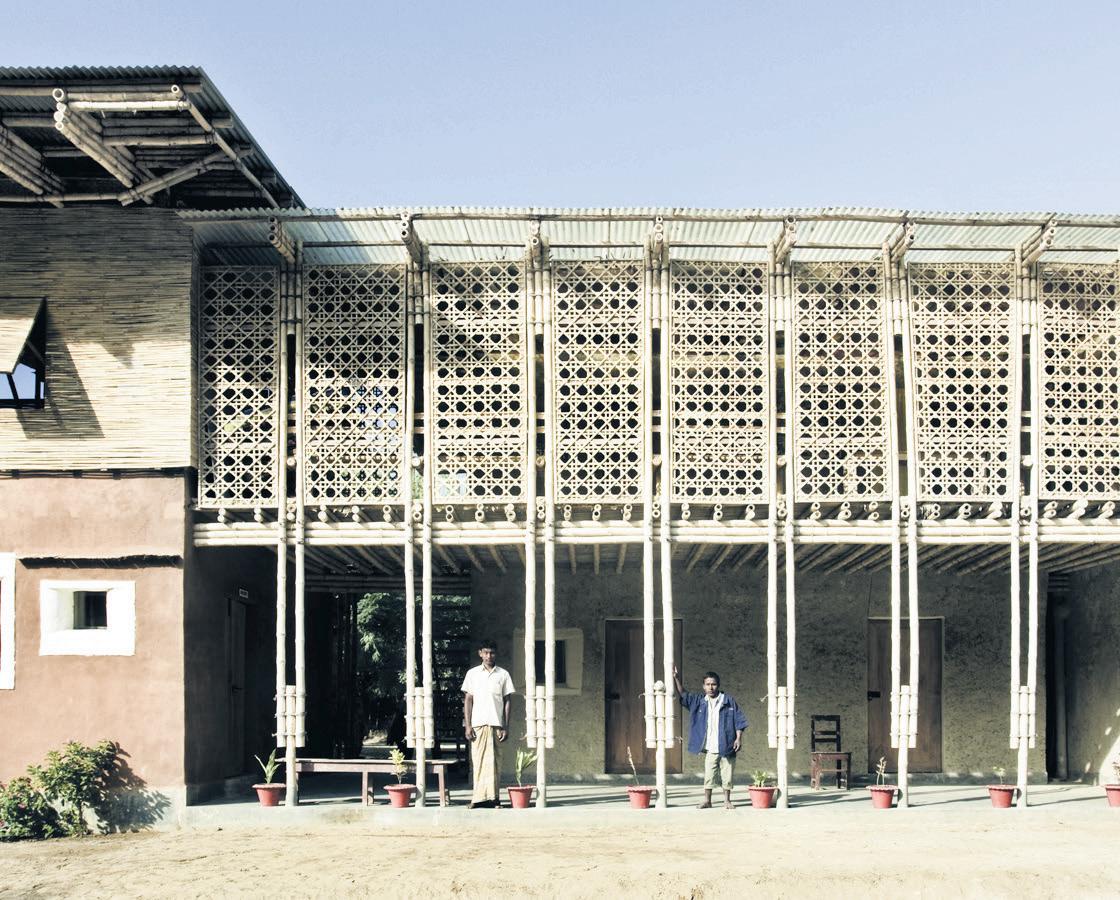
Launched in 2016, Architecture Fringe is a now-biennial grassroots festival which explores architecture in a political, cultural and social context. They’re returning this month with their seventh edition, a programme of events and workshops running across Scotland themed around Reciprocity – Architectures of Exchange. The programme is in two strands – the Core Programme, which is conceptualised, curated, commissioned, produced and delivered by the Architecture Fringe team, and the Open Programme, which is open-access, free to participate, and self-directed by the participants. Cofounder and co-director Andy Summers offers us an insight into this year’s theme, and the organisation as a whole.
“Our vision is to transform architecture for the common good, embedding it as a progressive force in national public life to create a plural, diverse and high-quality public-facing culture of architecture in Scotland and beyond,” he explains. An architect, educator, curator and public programmer, Summers is passionate about fostering a discourse around architecture and its role in the community. “Our audience is diverse, ranging from architects and activists to artists and community groups, students, and people interested in our cities, towns and landscapes.
“There’s a lot going on in the world, and
architecture, design and construction has a huge impact on the earth and our lives, both positive and not so positive,” he says. “We want architecture to play a more affirmative role in helping us all reach a more just, joyous and sustainable present and future. We’re committed to helping nourish and grow a critical, plural and buoyant culture of architecture in Scotland and our open-access platform has to-date inspired and amplified over 400 projects across the country.”
On this year’s theme, it’s a timely reminder of our interconnectedness, co-dependence, the existence of humanity and the built environment within an ecosystem. “Reciprocity seeks to remind us that the functioning of our world relies on the presence, assistance, and positive actions of other people,” Summers explains. “It’s an important social norm that informs human behaviour and aids our wellbeing, promotes sociability and encourages people to work together – foundational requirements for the viability of our towns, cities and landscapes.”
Reciprocity – Architectures of Exchange is the theme of the seventh edition of the Architecture Fringe. Featuring almost 90 projects, events and exhibitions, the festival runs at various locations across Scotland, 6-22 Jun architecturefringe.com
Words: Rosamund West
PROGRAMME HIGHLIGHTS
Architecture Fringe 2025
Opening Party!
The Briggait, Glasgow, 6 Jun, 6-9pm
Featuring exhibitions from across the core and open programmes as well as performances from Glasgow’s Brass, Aye? and dance-maker Janice Parker with tunes from resident DJ at Scandal Glasgow, BELLAROSA. Tickets available via architecturefringe.com
The Reason of Towns
The Briggait, Glasgow, 6-22 Jun, 11am-5pm
A touring exhibition celebrating the work of one of Ireland’s most renowned architects, Valerie Mulvin. Featuring models, plans and specially commissioned film work, the exhibition explores the telling and retelling of true stories, lost traditions and possible futures for Irish towns and the people who live in them.
Big Lecture: Anna Heringer
Edinburgh Futures Institute, Edinburgh, 12 Jun, 6.30-8pm
An evening with Anna Heringer, an architect based in Laufen, Germany, responding to this year’s theme and its interaction with her practice. Heringer is honorary professor of the UNESCO Chair of Earthen Architecture, Building Cultures and Sustainable Development where her work focuses on the use of natural building materials.
The Museum of Dad
Scottish Dance Theatre Studio Space, Dundee Rep Theatre, Dundee, 13 Jun, 6.30-8pm
A guided tour through the imaginary museum holding the archive of Andrew Nicoll, Dundee Rep architect, it’s contents telling the stories that Alzheimer’s made him forget.
Unstable Structures
The Courtroom Space, Oxford House, Glasgow, 6-15 Jun, 11am-4pm
A site-responsive exhibition of new sculptural and photographic work by artist and architect Veronika Desova. The exhibition explores a tectonic narrative related to the theme of instability – physical, social, and emotional – as a material condition and a metaphor for our times.
Mapping Metamorphosis
George Brown & Sons, Leith, Edinburgh, 6-22 Jun, 11am-6pm
Through carefully constructed drawings, designer Michael James Lewis holds architectural grids, lines, and markers against the shifting, cyclical movements of geological processes.
Brazilian artist Solange Pessoa exhibition at Glasgow’s Tramway probes humanity’s symbiotic relationship with the Earth through large-scale sculptural works created between Glasgow and Brazil
Stepping into the gallery, an almost solid, brilliant smell of nothing in particular marks the beginning of Solange Pessoa’s fantastical lifeworld, Pilgrim Fields. A rather literal recreation of its title, the installation forms pathways for walking around colourful beds of seeds, flowers, leaves, fruits, wool, and sculptures; moss sprouts from the crevices of the floor. Made of ceramic or bronze, sculptures that resemble seeds, legumes and standing stones (from Bronze Age Scotland) are laid amidst, or nest on top of, beds of marigold petals, chamomile flowers, and wool. Capturing the sunlight from the ceiling, the bronze, gold-like sculptures resemble exvotos, religious offerings in Indigenous traditions and religions. The dense arrangement of the earthborn and sculpted materials dictates a careful wandering. The height of the room and descending light contribute to a quasi-religious or enchanted experience, activating a sensuous relationship between humans and the natural world. Pessoa’s practice is informed by an animist worldview, in which the material and spiritual, human and ‘other’ (animal, plant, or inorganic matter) are understood as parts of an interconnected whole.
On the other hand, the compartmentalised arrangement of the earthborn material in distinct piles elicits a sort of distance, a mediation. In a map of this imagined ecosystem, each pile is titled quite literally; an
inventory: Scottish cultivated sphagnum moss; Niger seeds; Bellani pumpkin, natural and dried; Raw Hebridean wool; Safflower seeds; Butternut squash. Through this tension between natural order and logistical listing, we can begin unpacking the artist’s thinking process. The ‘inventory’ charts a globalised world. Together with material native to Scotland, such as Hebridean wool and Scottish kelp, the installation includes niger and safflower seeds that, together with plenty of other inconspicuous material of daily use, reached the UK through the routes of colonial trade. Beyond the initial sensory response, Pilgrim Fields calls for a consideration of the histories embodied in its material. The curatorial text provides useful pointers for beginning to think about the political economy that guides the artist’s practice. The text discusses how earthborn material have been implicated in violent processes of primitive accumulation, noting, for instance, that the highly profitable wool trade contributed to the land clearances in the early 19th century that displaced local populations and deracinated forests to establish the grazing of livestock as a major economic sector in Scotland.
Pessoa’s practice responds to the landscapes of Minas Gerais (General Mines), Brazil, where she lives and works – once a colonial state and still a centre of iron, gold, and gem mining. In Brazil, animism persists as a counter-tendency to the forced modernisation of peoples: their separation from the land and their means of sustenance. Pilgrim Fields emerges as an echo of a lost past, when an immediate relationship between humans and the rest of the natural world was still possible. The exhibition concludes outdoors
'The exhibition exists somewhere between past and perpetuity: it concretises the desire for a better tomorrow and the difficulty of thinking politically about how to get there'


with a single installation titled Lesmititas (2025), deriving from the Portuguese word for slug. Hanging from the branches of a tree, part of Tramway’s permanent landscape, biomorphic and inexplicable objects resemble ‘something creeping, crawling, soft, and long.’ The interpretative material su ests that Pessoa views these forms as resembling both a ‘snake and umbilical cord’; they are symbolic of ‘a sort of birth and death’. If the constellation of seeds hints to an enchanted world that is merely a simulation, Lesmititas embodies the possibility of a life beyond the violent expropriation and exploitation of humans and
nature. Yet, Lesmititas remains rather ambiguous, a suspension. In that manner, the exhibition exists somewhere between past and perpetuity: it concretises the desire for a better tomorrow and the difficulty of thinking politically about how to get there. Pilgrim Fields is affective and filled with complex histories and questions that gradually emerge to the viewer who pays careful attention. [Natassa Philimonos]
Solange Pessoa - Pilgrim Fields, Tramway, Glasgow, until 5 Oct, free tramway.org

By Catherine Lacey rrrrr
Given its title, you would be forgiven for thinking Catherine Lacey’s The Möbius Book would be an airless work of cyclical allegory and scalable allusions: all topology, no topicality. Thankfully, this is not the case.
Lacey’s latest is actually a work of two halves, both fiercely compelling and fresh: on the one hand, a frank examination of the acts of love and faith – as well as their absences and antitheses – that have marked the author’s life in recent years; and on the other, a crisp short story echoing – or, depending in which order you read it, foreshadowing – the entropic rise and fall of the other half of the book.
In this superb blend of studied memoir and loosely sketched fiction, matters that destabilise, from heartbreak to hunger, are given license to remain largely unreconciled; errors are ‘allow[ed] to live.’ There is precision here, too: friendships – even those that perhaps qualify more as ‘distant company’ than ride-or-die – are the primary axis of The Möbius Book; and Lacey’s steady depiction of these platonic bonds help steer her recount of life as it was, as it is, and as she has imagined it.
As The Möbius Book collapses the boundaries of the genre –animated, as it is, by a sense of an ending and a beginning on a continuum – Lacey grants her reader the assurance that there might still be ‘good ways to be demolished.’
[Tara Okeke]

By Ryan Gilbey rrrrr
How does one tell a story of queer cinema? For Ryan Gilbey, the answer is to take inspiration from the subject itself and write a book that’s as subversive and quicksilver as the queer films he adores. It Used to Be Witches sees him embark on a journey that hopscotches across decades as he teases out themes and connections between an eclectic array of work while exploring the role cinema has played in shaping and enriching his own sexuality.
Gilbey is sharp on familiar debates (queer cinema’s commodification; queerbaiting actors) but he’s at his best when careering down idiosyncratic rabbit holes. In one interview, Jessica Dunn Rovinelli recommends the work of fellow trans filmmaker Elizabeth Purchell, a scholar of 70s and 80s gay porn; Gilbey dutifully follows Rovinelli’s breadcumbs with a chapter on the self-reflexivity of classic gay skin flicks. This boundless curiosity and willingness to be led by his rigorous research exemplifies Gilbey’s approach, but also adds to the book’s own queerness; like queer people’s identities, its form feels in flux.
There are few more adroit interviewers than Gilbey; his chats with the likes of Bruce LaBruce, Desiree Akhavan and Andrew Haigh are candid, wry and often quite poignant. But it’s Gilbey’s evocative biographical writing, where tender memories of teen trauma sit alongside self-deprecating yarns of middle-age anxiety (an aborted pass at a modern master of queer cinema is a hilarious highlight), that makes It Used to Be Witches so essential.
[Jamie Dunn]

By Annie Ernaux rrrrr
Raw and resonant, Annie Ernaux’s newly translated novella The Possession offers up a stream of fixations and divulgences that the narrator treats with utmost openness. Originally published in French in 2008, the story follows a woman dealing with the aftermath of her ex-husband’s affair with another woman who becomes subject to the narrator’s ruminations. Ernaux creates a voyeuristic world that briefly but totally immerses readers and shares a piece of herself through the primary emotion that drives this book: jealousy.
Mainstream media often associates jealousy with ‘toxic’ relationships and women. Women are taught to feel the shame of loss and subsequently, of desire, but through a stream of confessions and recollections, Ernaux weaves experiences of obsession, addiction, and insecurity into the human fabric of being. The narrator’s jealousy tri ers the instant desire to uncover truth through a ‘frantic assembling of signs.’ Once we realise that this kind of insecurity is our default state – that we are not immune to things like jealousy, paranoia, and obsession – we recognise that suffering unites us, and that makes for what Ernaux calls the ‘poetic function at work in literature, religion, and paranoia.’ Emotions, like institutions, may become systems that dictate our perception of life, but Ernaux’s writing understands the privilege of understanding that life, liberation, and relief also comes from within.
[Maria Farsoon]
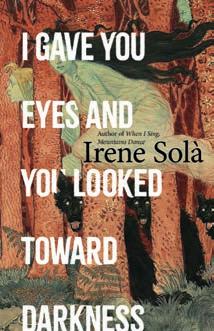
I Gave You Eyes and You Looked Towards Darkness
By Irene Solà rrrrr
Translated from the original Catalan by Mara Faye Lethem, Irene Solà’s I Gave You Eyes and You Looked Towards Darkness is a novel of memory and monsters. And mothers. This is writing which revels in fecundity in all its forms. To say it depicts nature red in tooth and claw is understatement writ large. Set across a single day, but also over 400 years, it reads like a stream of near-unconsciousness from the indefatigable Bernadeta’s final moments, which are shared with the women to whom she is intrinsically linked. As stories are recalled there are references to folk traditions and faerie tales, with battles played out between Christian and pagan, and deals with the devil made and reneged. But while mythology and legend are at its heart, with humans and animals often indistinguishable, it’s also a highly literary novel, with quotes from the likes of Anna T. Szabó, Pau Riba, and Ali Smith.
Solà's book celebrates the tradition of storytelling in a manner which is both ancient and artful. Mara Faye Lethem’s translation never takes you out of what’s happening on the page, but there is a consistent otherness which has to do with what’s being depicted rather than how. Solà’s imagery is beyond arresting – it burns itself into your retina as you read, but what stays with you are the relationships between the impossible Bernadeta and those around her.
[Alistair Braidwood]
Granta, out now
Faber, 5 Jun
Fitzcarraldo Editions, out now
Granta, 5 Jun

We chat to Story Platform’s Head Honcho, Gemma Rodgers, about developing TV and film comedy writing in Scotland through an ace live show
Tell me about Story Platform...
It’s a monthly TV and film comedy writing development initiative which runs at Edinburgh’s Traverse Theatre. Inspired by the legendary SNL model, 10+ writers (a mix of comedians and playwrights) meet on a Monday, decide on a theme, then create a 60 minute show from scratch to perform live on the Friday. The show is a mix of music, sketch, monologues, physical comedy and everything in-between! It aims to be a safe space to experiment and see what works in front of an audience. The live show element, providing the adrenaline and immediate feedback, is missing from most screen comedy development. Our core team includes Amelia Bayler, Amanda Dwyer, Kim Blythe, Isla Fairfield, Mirren Wilson, Eleanor Morton, Chris Thorburn, Chris Weir, Nat McCleary, Mikey Burnett, Joe McCann and Craig-James Moncur.
How did it come about?
Since my time back as Head of Comedy at BBC Scotland, I have been consistently blown away by the incredible comedy talent in Scotland – not just comedians, but across all forms of writing: plays, novels, graphic novels, and the rest. It felt like there should be a way to combine these brilliant voices and styles in a more collaborative space.
I’ve been incredibly lucky to have produced sketch comedy legends including The League of Gentlemen and Victoria Wood, so have a real understanding of how important the rehearsal/ writers room and live audience experience is to the essence of comedy. As sketch has pretty much died on TV, that experience hasn’t been available to a new generation who have found their voices on social media.
I created a previous version of the event called Alchemy when I left the BBC. It worked really well. Richard Gadd and Ashley Storrie were alumni, alongside most of the cast of Scot Squad, but unfortunately it finished after a few shows. Last year, on my return to Edinburgh, I was surprised to find that things hadn’t moved on much and that space was still needed, so with the support and encouragement of Screen Scotland’s Kieran Hannigan and Bella Barber-Fleming, Story Platform was born.
What was the first Story Platform like?
In preparation, I’d seen most of the group (unbeknownst to them) doing their shows live, or watched them online. It was really critical to me that the writers’ room was full of both very funny people and people likely to be generous with one another – a good indicator was how they behaved with audience members at their own gigs.
The first event was at Summerhall in January, the Monday after Storm Eowyn. Although we felt like we’d survived a zombie apocalypse, it proved fantastic inspiration for the group! It really brought everyone together faster than I had hoped. Quite a few of the comedians knew one another but the playwrights were new in the mix and the dynamic they brought was really interesting.
The originality and teamwork has been incredible since show one and everyone is thriving on having this new community to work with and a space to experiment without worrying about it failing. The ability to fail is the vital part of any truly creative process.
What would be your dream Story Platform event and why?
I feel really lucky with the team and the people we can now start feeding into the group. I’d love to run more parallel events across Scotland to give opportunities to writers beyond the central belt.
What’s been your best takeaway from running Story Platform?
My experience working with lots of famous comedy people over the years is that if you need to be funny and seek audience validation either live or via social media, you should be given a space where you can do that safely but with enough risk to get the adrenaline going.
Who’s the funniest comedian you’ve seen and why?
It’s the wonderful and hugely missed Victoria Wood, who I had the great honour of working with. Obviously she was brilliant live and on screen, but every hour of every day behind the scenes, we laughed constantly.
How do we make the Scottish Comedy Scene better?
I’d say: think bi er. Think beyond Scotland to the world. The voices are here but there needs to be more collective confidence in the work.
What’s next for Story Platform?
We have one more event in the run – 27 June at the Traverse, and we’ll be doing two Best Ofs over the Festival (keep your eyes peeled for dates).
Story Platform, Traverse Theatre, Edinburgh, 27 Jun, 7pm, free tickets available via Eventbrite

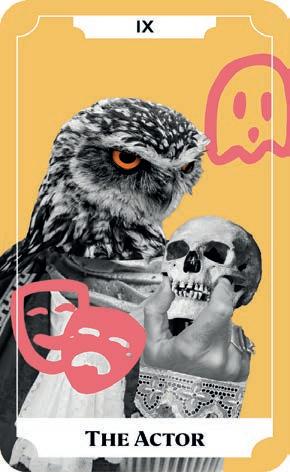


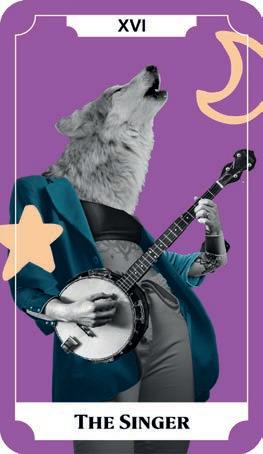


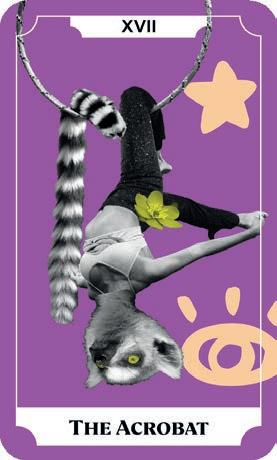

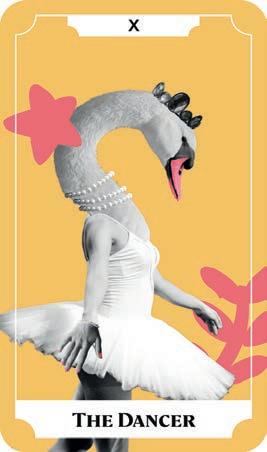



Looking for something to do? Well you’re in the right place! Find listings below for the month ahead across Music, Clubs, Theatre, Comedy and Art in Glasgow, Edinburgh and Dundee. To find out how to submit listings, head to theskinny.co.uk/listings
Mon 26 May
GLASGOW
SONGWRITER ROUND
KING TUT'S Local lineup.
JORJA SMITH
O2 ACADEMY GLASGOW
R'n'B from the UK.
YUUF
THE HUG AND PINT Psych from the UK.
HALF ALIVE
SWG3 Rock from California.
SPILL TAB
SWG3 Synth pop from LA.
Tue 27 May
JOHN LEGEND
THE OVO HYDRO Pop from the US. SUNDAY (1994)
(BEAUX)
KING TUT'S Dreampop from LA.
WUNDERHORSE
O2 ACADEMY GLASGOW Rock from the UK.
BUG TEETH (SLUG +
BREADSTAIN)
THE HUG AND PINT Indie from Norwich.
AZYMUTH
ROOM 2 Jazz funk from Brazil.
ALEXANDRA KAY
SWG3 Country from the US.
ETHAN TASCH
SWG3 Indie folk from the US.
I SEE STARS
SWG3 Electro hardcore.
SEXTILE STEREO Synth punk from LA.
Wed 28 May
FINN FOXELL
GARAGE GLASGOW Alt rap from the UK.
INSIDE VOICES
KING TUT'S Eclectic lineup.
DEMI MARRINER THE HUG AND PINT Indie from the UK.
LEO MIDDEA THE OLD HAIRDRESSERS Singer-songwriter from Rio de Janeiro.
Thu 29 May
QUINIE (HARRY GORSKI BROWN) MONO Folk from Scotland. THE LUMINEERS THE OVO HYDRO Alt folk from Colorado. HIMALAYAS
KING TUT'S Indie rock from Cardiff.
KESHA O2 ACADEMY GLASGOW Pop from LA.
SCOTT C. PARK SWG3 Indie from the Isle of Lewis. BROGEAL SWG3 Folk punk from Scotland.
BRELAND SWG3 Country from the US. ELECTRIC HONEY SHOWCASE STEREO College record label showcase.
PRIMA QUEEN NICE 'N' SLEAZY Indie rock from Bristol.
Fri 30 May
RARE BREED (AFTER YOU + START FROM SCRATCH + FACE THE SILENCE)
GARAGE GLASGOW Blues rock from Manchester.
TYLER, THE CREATOR THE OVO HYDRO Rap from the US.
NOMAD + THE FRETAS + RIGHT BY MEXICO + TANITH AND MATTHEW KING TUT'S Eclectic lineup. NESSA BARRETT O2 ACADEMY GLASGOW Pop rock from New Jersey.
RIGID SOUL (JOHNNY BARR + EL GALVARINO) ROOM 2 Rock from Glasgow. THE SHERLOCKS SWG3 Indie rock from the UK.
GLASS CAVES (BLAIR GILMOUR) SWG3 Rock from Pontefract. CANAAN COX STEREO Country from Nashville.
Sat 31 May
THE OUTCHARMS
GARAGE GLASGOW Rock from Doncaster.
TYLER, THE CREATOR THE OVO HYDRO Rap from the US.
MRCY (KULEEANGEE)
KING TUT'S Alt from the UK.
LAEL NEALE THE HUG AND PINT Indie rock from Virginia.
Sun 1 Jun
ELI WALTZ + KORINA ZAMBRANO ORAN MOR Folk from the US. THE LIVING TOMBSTONE SWG3 Electronica. THE MAES THE GLAD CAFE Folk from Australia.
Mon 2 Jun
DON TOLIVER THE OVO HYDRO Rap from the US.
TIM GALLAGHER KING TUT'S Country from Crewe. DJO (POST ANIMAL)
O2 ACADEMY GLASGOW Indie from the US.
SEMATARY
ST LUKE'S Rock from the US.
MJ LENDERMAN THE OLD FRUITMARKET Country folk from North Carolina.
Tue 3 Jun
JONTAVIOUS WILLIS MONO Blues from Georgia.
BRIGITTE CALLS ME BABY
GARAGE GLASGOW Pop rock from Chicago. ANDY MCKEE ORAN MOR Singer-songwriter from the US.
PEARL CHARLES
KING TUT'S Indie pop from LA. IGGY POP
O2 ACADEMY GLASGOW Rock from the US.
SHANE SMITH & THE SAINTS SWG3 Rock from the US.
PARIS PALOMA SWG3 Pop from Derbyshire.
FACTORY FLOOR (LIVE) + RUSSELL HASWELL (DJ) SUB CLUB Electronic from London. TENGGER (MOKUSLA) THE GLAD CAFE Psych from Japan and Korea.
Wed 4 Jun
LIONEL RICHIE THE OVO HYDRO Pop from the US. MSSV ORAN MOR Rock from the US. MORRISSEY
O2 ACADEMY GLASGOW Indie from the UK. TOM MCGUIRE AND THE BRASSHOLES
THE RUM SHACK Funk soul from Glasgow. TXXTHACHE
SWG3 Indie from Glasgow. THE CORONAS STEREO Rock from Ireland.
PIPPA BLUNDELL
THE GLAD CAFE Folk.
Thu 5 Jun
KIP MOORE THE OVO HYDRO Singer-songwriter from the US.
LISA MCHUGH ORAN MOR Country pop from Ireland. THE HAUNT KING TUT'S Rock from the US. MORRISSEY
O2 ACADEMY GLASGOW Indie from the UK. DARDEN SMITH THE RUM SHACK Americana from Texas.
JADU HEART
SWG3 Indie from London. SOL PARADISE SWG3 Jazz from London.
CLAY RINGS (MAZ AND THE PHANTASMS + APOLOGIES)
NICE 'N' SLEAZY Rock from Glasgow.
BEN VINCE (LAURIE PITT + LAUREN SARAH HAYES) THE GLAD CAFE Electronica from London.
Fri 6 Jun
KEVIN MCGUIRE
GARAGE GLASGOW Country from Scotland. NICK MULVEY ORAN MOR Indie from Cambridge.
MILANGE KING TUT'S Jazz punk.
OMO (MRS. FRIGHTHOUSE + CIVIL ELEGIES) THE HUG AND PINT Noise rock from Glasgow. ERIC CHENAUX (LOUIS
LAURAIN + LENE OTIS FINN) THE OLD HAIRDRESSERS Folk from Canada.
JUNIOR BROTHER (JUDE NORTONSMITH) THE GLAD CAFE Folk from Ireland.
Sat 7 Jun
PULP THE OVO HYDRO Britpop from the UK. DANNY BOWES ORAN MOR Hard rock from the UK.
ROBYN RED KING TUT'S Country from Glasgow. CHRIS HELME THE HUG AND PINT Rock from the UK.
CAROLINE ST LUKE'S Post-rock from London.
JILL LOREAN + S. ANTIGONE THE OLD HAIRDRESSERS Experimental from Glasgow.
SOVIREZ (SONNY LETO + THE FUNKY RED PANDAS) NICE 'N' SLEAZY Funk and soul from Greenock.
COORIE DOON CIVIC HOUSE Disco from Glasgow.
Sun 8 Jun
SHONEN KNIFE ORAN MOR Rock from Osaka. WAXAHATCHEE BARROWLANDS Indie from the US. THE GET UP KIDS (LAKES) ST LUKE'S Emo from Kansas City.
WILLIAM TYLER (DJANA GABRIELLE) THE GLAD CAFE Country from Nashville.
Mon 9 Jun
NELLY THE OVO HYDRO Rap from the US. HOHNEN FORD SWG3 Indie from London. KONTRAVOID (BUZZ KULL) STEREO Electro and goth from Canada.
THE VELDT (TREMOURS) THE GLAD CAFE Shoegaze from North Carolina.
Tue 10 Jun
DORA JAR
ST LUKE'S Bedroom pop from California.
FOXING (FLINCH.) ROOM 2 Indie rock from Missouri.
NEW CANDYS (THE MIRACLE SEEDS + FLOATING HEADS) STEREO Psych rock from Italy.
Wed 11 Jun
KATHRYN JOSEPH ST LUKE'S Folk from Scotland. DIKEMBE (SUDS) NICE 'N' SLEAZY Indie emo from Florida. CURLEW (AURORA ENGINE) THE GLAD CAFE Alt folk from Glasgow.
Thu 12 Jun
THE DEAD CINDERELLAS KING TUT'S Indie from Glasgow. PAUL SMITH [MAXIMO PARK ] THE HUG AND PINT Art rock from Manchester. "SONIC LABS: REFRACTIVE ABERRANT" CCA: CENTRE FOR CONTEMPORARY ART EXPERIMENTAL.
Glasgow STATIC SKY NICE 'N' SLEAZY Alternative rock from Ayrshire.
DAVE ARCARI THE GLAD CAFE Indie from Glasgow. Fri 13 Jun GA-20 ORAN MOR Blues from the US. FAETOOTH THE HUG AND PINT Fairy doom from LA.
NOVA SCOTIA (FAT SALAMI + BETTYS CLUB + THE BACK PAGES + THE HERITAGE) ST LUKE'S Indie from Scotland. READY WEATHER SWG3 Alt rock from Scotland. BRAVEHEARTS STEREO Indie. RIVIERA (GRACIOUS + FEAR THE MONGOOSE + AZALEAS) NICE 'N' SLEAZY Indie rock from Glasgow. Sat 14 Jun
TOOTH GORE (TIME STANDS STILL + TRNDS + LUCKY 38) GARAGE GLASGOW Surf punk from Cornwall. PATRICK HYNES KING TUT'S Country from Glasgow. THE WATERBOYS BARROWLANDS Rock from Scotland. BIS THE HUG AND PINT Disco punk from Scotland. BROMP TREB (MALCY DUFF + LEWYS HOLT + DANIELA GASSI) THE OLD HAIRDRESSERS Indie from LA. THE JOSHUA HOTEL STEREO Electro indie from Inverness. ADVENTURE TEAM + DANCER THE GLAD CAFE Pop from Berlin. Sun 15 Jun THE CHESTERFIELD KINGS ORAN MOR Garage rock from the US. KEVIN BURKE THE HUG AND PINT Trad from Ireland. FINAL DOSE (SCREWDRIVER LOBOTOMY + LÄBRYS + GUILT CHAMBER) THE HUG AND PINT Punk metal from London.
SO SO SAD (JONNI
SLATER)
THE GLAD CAFE
Folk from Glasgow.
Mon 16 Jun
RAQUEL RODRIGUEZ
ORAN MOR
Pop from LA.
STEEL PANTHER
O2 ACADEMY GLASGOW
Hard rock from LA. THE WATERBOYS
BARROWLANDS
Rock from Scotland.
MOOR MOTHER
THE HUG AND PINT Jazz from the US.
JD MCPHERSON
ST LUKE'S Rock from Oklahoma.
Tue 17 Jun
HAVE A NICE LIFE
ST LUKE'S Rock from Connecticut.
POWER TRIP
SWG3 Thrash from the US.
Wed 18 Jun
SANTANA THE OVO HYDRO Pop from the US.
BAIANA + SNOWBOY (THE HAGGIS HORNS)
ORAN MOR Jazz from Liverpool.
HANK (CATCHER)
THE HUG AND PINT Indie from London.
GLASGOW JAZZ
FESTIVAL: NEIL
COWLEY TRIO
ST LUKE'S Jazz from the UK.
OSEES
SWG3 Rock from San Fransisco.
CUPID STUNTS
NICE 'N' SLEAZY Indie punk from Glasgow.
HANNAH WHITE
THE GLAD CAFE Country from London.
Thu 19 Jun
RAZ + AFLA
THE HUG AND PINT
Afro-house.
GLASGOW JAZZ
FESTIVAL: MATT
CARMICHAEL (JULIETTE LEMONIE + CHRIS AMBER)
ST LUKE'S Jazz from Scotland.
ABBIE GORDON
SWG3 Indie from Scotland.
TIMMY ALLAN
NICE 'N' SLEAZY Jazz from Glasgow.
OUTLIERS
THE GLAD CAFE Folk from Scotland.
Fri 20 Jun
CHANTEL MCGREGOR
GARAGE GLASGOW Blues rock from Bradford.
ASTLES
GARAGE GLASGOW Pop from the UK.
MAANU KING TUT'S Pop rap from Pakistan.
DENZEL CURRY
O2 ACADEMY GLASGOW Rap from the US.
SMOOVE & TURRELL
THE HUG AND PINT Soul from Newcastle.
GLASGOW JAZZ
FESTIVAL: BRIAN
JACKSON
ST LUKE'S Jazz from the US.
BOBBY BARE JR.
DRYGATE BREWING CO. Rock from Tennessee.
BOHEMIAN MONK
MACHINE
THE RUM SHACK Funk from Perth.
NATIONAL PLAYBOYS (AWFUL EYES + GUEVARA) ROOM 2 Alt rock from Edinburgh.
JENSEN MCRAE SWG3 Pop from California.
GENE LOVES JEZEBEL
STEREO Goth rock from London.
ARROWS IN ACTION ( YOUNG CULTURE) NICE 'N' SLEAZY Indie pop from Nashville.
CALEB NICHOLS (COUNT FLORIDA + FIRST WIVES) THE GLAD CAFE Indie pop from the US. Sat 21 Jun
FAT DADS
GARAGE GLASGOW Indie from Carlisle.
DAZED & CONFUSED KING TUT'S Psych rock from Scotland.
ADEM (JO MANGO) THE HUG AND PINT Electro pop from London.
FANTASY OF A BROKEN HEART THE HUG AND PINT Art pop from Brooklyn.
GLASGOW JAZZ
FESTIVAL: MAMMAL HANDS
ST LUKE'S Electro-jazz from Norwich. GLASGOW JAZZ
FESTIVAL: GLASGOW IMPROVISERS ORCHESTRA WITH PAT THOMAS ST LUKE'S Jazz from Glasgow. BASIA BULAT NICE 'N' SLEAZY Folk from Montreal. THE SECRET
GOLDFISH (THE CORDS) THE GLAD CAFE Indie pop from Scotland. Sun 22 Jun
HORSEGIRL MONO Rock from Chicago.
AERIAL SALAD GARAGE GLASGOW Punk rock from Manchester.
MALLRAT (PEARL CHARLES) KING TUT'S Indie from Australia. BRIGHT EYES
BARROWLANDS Indie rock from Nebraska. F.O. MACHETE THE HUG AND PINT Alt rock from Glasgow.
GLASGOW JAZZ
FESTIVAL: MODERN VIKINGS ST LUKE'S Jazz from Scotland.
NORDIC RESONANCE: RENZO SPITERI + RICHARD CRAIG THE OLD HAIRDRESSERS Experimental.
MARIAM REZAEI + RAYMOND MACDONALD THE GLAD CAFE Jazz.
Mon 23 Jun
BROTHER ALI STEREO Hip-hop from the US.
Tue 24 Jun WARFIELD THE HUG AND PINT Metal. THE WANDERING HEARTS ST LUKE'S Country. AITCH SWG3 Rap from the UK. RYAN CHRYS & THE ROUGH CUTS STEREO Country rock from Montana. FREE MANTLE HYPOTHESIS NICE 'N' SLEAZY Alt from Edinburgh. JAZZ AT THE GLAD (NICK COSTLEYWHITE) THE GLAD CAFE Jazz from London.
Wed 25 Jun
THE REVEREND PEYTON'S BIG DAMN BAND MONO Country blues from the US.
DIANA ROSS THE OVO HYDRO Motown from the US.
STEPHEN WILSON JR BARROWLANDS Indie country from the US. BETTY BOO THE HUG AND PINT Rap from London. THE HARD QUARTET ST LUKE'S Indie rock from the US.
EXTRA LIFE NICE 'N' SLEAZY Experimental from New York.
Thu 26 Jun
QUAINT SWG3 Indie from Scotland. MICHAEL MCGOVERN (ELLIE GOWERS) THE GLAD CAFE Glasgow-based folk-rock artist
Fri 27 Jun
MACY GRAY (TOMMY WA) THE OLD FRUITMARKET R'n'B. HER PICTURE STEREO Alt-rock from Glasgow. YAS CLARKE: THE THICKET THE GLAD CAFE Indie.
Sat 28 Jun
STAY FOR TOMORROW (SONIC NOISE + KILLER SMILE + CHRDBL)
GARAGE GLASGOW Alt rock from Dunfermline. THE TONIC REVIVAL (TRADE + LILY GRACE AND THE MERCHANTS) NICE 'N' SLEAZY Rock from Glasgow. FLINCH. THE GLAD CAFE Indie from Glasgow.
Sun 29 Jun
FAYE WEBSTER BARROWLANDS Indie from Atlanta. FENTANYL (K U T E) THE HUG AND PINT Hardcore.
C.O.F.F.I.N (CALLOUS FEEDBACK) STEREO Rock from Sydney.
Mon 30 Jun
MAYDAY (CHRISSY GRIMEZ + LYNX + REDKING + BENNI MURKS) NICE 'N' SLEAZY Grime from Birmingham.
Mon 26 May
BERNSTRUM AND THE MEN (MAXWELL WEAVER & THE FIG LEAVES) LEITH DEPOT Psych rock from Dumfries.
Tue 27 May
WET LEG USHER HALL Indie rock from the Isle of Wight.
HUMOUR SNEAKY PETE'S Post-punk from Glasgow.
ELKIE BROOKS THE QUEEN'S HALL Pop rock from the UK.
Wed 28 May
CONTINENTAL LOVERS (TRENCH DOGS + SUICIDE BOMBERS) BANNERMANS Glam punk from Nottingham.
SOFT LOFT + SAM LYNCH
SNEAKY PETE'S Indie pop from Switzerland.
Thu 29 May
ELLEN BETH ABDI THE VOODOO ROOMS Jazz pop from Manchester.
STRANGE GRAVITY
(ALLMYFRIENDSARESYNTHS + ALEX TRONIC) THE VOODOO ROOMS Electronica lineup.
ERIC MARTIN (ASH
TUSTAIN)
BANNERMANS Rock from the US.
GARY BARLOW
USHER HALL Pop from the UK. LEO MIDDEA
LEITH DEPOT
Singer-songwriter from Rio de Janeiro.
SILVI + KATHERINE ALY + FIDA
SNEAKY PETE'S Multi-genre from Scotland.
Fri 30 May
THE JACKALS THE BONGO CLUB Blues from Brighton.
SUBHUMANS (THE SCUNTZ + GUTTERBLOOD)
BANNERMANS Punk rock from the UK.
SLEEKIT
SNEAKY PETE'S Indie rock from Edinburgh.
LUNAR VACATION
SNEAKY PETE'S Indie rock from Atlanta.
WASAGAS (BAD MOODS + MARIACHI DEATH SQUAD + STARLOTTE SATINE) THE WEE RED BAR Garage rock.
A NIGHT FOR MAP THE QUEEN'S HALL Folk and roots from Scotland.
LUNAR VACATION THE MASH HOUSE Indie rock.
IVY BIG BAND: IN FULL BLOOM LA BELLE ANGELE Jazz.
Sat 31 May
CANAAN COX THE VOODOO ROOMS Country pop from North Carolina.
MIKI BERENYI TRIO + F.O. MACHETE
SNEAKY PETE'S Dream pop from London.
MALIN LEWIS
PRESENTS: FRIGG,
MARVARA, ME LOST
ME THE QUEEN'S HALL Folk and trad.
Sun 1 Jun
THE SWEET KILL (OLIVER MARSON)
BANNERMANS Post-punk from LA.
Mon 2 Jun
TELLYCLUB (SOFTDRINK MILLIONAIRE)
SNEAKY PETE'S Indie rock from Dublin.
Wed 4 Jun
ELECTRIC BOYS (THE SPANGLES) BANNERMANS Hard rock from Sweden.
SNAKE EYES (CHOSES
SAUVAGES + SCARRED LIP)
SNEAKY PETE'S Rock/post-punk from Brighton/Montreal.
MARTHA WAINWRIGHT
THE QUEEN'S HALL Rock from Canada.
RADIO RATZ
THE WEE RED BAR Riot grrrl.
Thu 5 Jun
RASTAK: TALES OF EARTH AND SUN
THE QUEEN'S HALL Folk and roots from Iran.
GALGO (LASZLO AND DIE KATZE) THE WEE RED BAR Jazz and shoegaze.
Fri 6 Jun
NATASHA OLDCORN THE VOODOO ROOMS Pop from Edinburgh.
INTERSTELLAR BLUES BANNERMANS Experimental. THE MIRACLE SEEDS
SNEAKY PETE'S Psych rock from Dundee. DECLAN WELSH & THE DECADENT WEST THE MASH HOUSE Indie.
Sat 7 Jun
KING KRAKEN (VICTORY OR DIE) BANNERMANS Rock from Wales.
BILLY OCEAN USHER HALL Reggae from the UK.
CONFLICT
LA BELLE ANGELE Anarchy punk.
Sun 8 Jun
LA DOLCE VITA SWING COLLECTIVE THE VOODOO ROOMS Jazz. FAT DADS
SNEAKY PETE'S Indie rock from Carlisle. FOXING THE MASH HOUSE Indie/emo from St Louis, Missouri.
AMPLIFI THE QUEEN'S HALL Rock and pop from Scotland.
Mon 9 Jun
THE SCRATCH THE MASH HOUSE Experimental.
Tue 10 Jun
BONNIE RAITT USHER HALL Singer-songwriter from the US.
ELIAS RØNNENFELT (MOST THINGS) SNEAKY PETE'S Indie/alt pop from Copenhagen.
Wed 11 Jun
PAUL SMITH [MAXIMO PARK ] (ALEX REX) THE VOODOO ROOMS Art rock from Manchester. JOSHUA LEE TURNER THE VOODOO ROOMS Singer-songwriter from Brooklyn.
RUMKICKS (STOATERS + SCIENCE MADE US ROBOTS) BANNERMANS Punk rock from Seoul.
Thu 12 Jun MEOW BANNERMANS Rock.
BÔA THE QUEEN'S HALL Rock from the UK.
Fri 13 Jun
THE SUNSHINE DELAY (THE GO FIGURES) THE VOODOO ROOMS Pop from Edinburgh.
EXISTENZ (MILLIONS WILL DIE) BANNERMANS Hardcore punk.
THE WATERBOYS USHER HALL Rock from Scotland.
BLACK LESION (REVANICA)
SNEAKY PETE'S Hard rock from Edinburgh. THE C-80S (THE STANDARD TAPES + TRASH TAPES) THE WEE RED BAR Post-punk.
Sat 14 Jun
SUBVERSIVE BANNERMANS Rock from Virginia.
KWIAT JAB ŁONI THE LIQUID ROOM Indie from Poland
WE TRAVEL IN HOPE (N. MUNRO + THE FOOL NOTIONS) THE WEE RED BAR Indie folk.
Sun 15 Jun
Tue 17 Jun
HANNAH WHITE THE VOODOO ROOMS Folk pop from Scotland.
Thu 19 Jun
BAIANA + SNOWBOY (THE HAGGIS HORNS) THE VOODOO ROOMS Jazz from Liverpool. OSEES (CONTAINER) THE LIQUID ROOM Rock from San Fransisco. ARROWS IN ACTION SNEAKY PETE'S Emo from Nashville.
Fri 20 Jun
MOLLY KARLOFF BANNERMANS Rock.
Sat 21 Jun
SHUNA LOVELLE THE VOODOO ROOMS Soul from Edinburgh. EASTSIDE FT MANDINI (CHEF THE RAPPER + PRINCYBOII) SNEAKY PETE'S Hip-hop from Aberdeen.
REEM KELANI AND HER TRIO THE QUEEN'S HALL Folk and roots from Palestine. QUEER AS PUNK THE WEE RED BAR Punk.
Sun 22 Jun
CHANTEL MCGREGOR (STONEY BROKE) BANNERMANS Blues rock from Bradford.
Mon 23 Jun THE DEVIL MAKES THREE THE LIQUID ROOM Americana from California.
Wed 25 Jun
VISION VIDEO THE VOODOO ROOMS Rock from the UK. FAILED TO IGNITE BANNERMANS Alt from Newcastle.
Thu 26 Jun
BETTY BOO THE VOODOO ROOMS Rap from London. JACQUI DANKWORTH WITH CHARLIE WOOD THE QUEEN'S HALL Jazz and blues from the UK.
Fri 27 Jun THE BRIAN JONESTOWN MASSACRE EDINBURGH CORN EXCHANGE Rock from San Fransisco. SCOTT MARSDEN SNEAKY PETE'S Singer-songwriter from Wales. THE PHOENIX CHOIR THE QUEEN'S HALL Rock from Scotland. FRIGHT YEARS THE MASH HOUSE Indie.
Sat 28 Jun
JAMES OLIVER BAND + NORMAN WATT-ROY (LIZ JONES + BROKEN WINDOWS) THE VOODOO ROOMS Blues from the UK. KID CREOLE & THE COCONUTS THE QUEEN'S HALL Rock from the US.
GIRLS ROCK SCHOOL THE WEE RED BAR Punk.
Sun 29 Jun
CARL MARAH THE VOODOO ROOMS Psych pop from Edinburgh.
Sat 7 Jun
DECLAN WELSH & THE DECADENT WEST BEAT GENERATOR LIVE! Indie.
Fri 13 Jun
KEVIN MCGUIRE BEAT GENERATOR LIVE! Country from Glasgow.
Sat 14 Jun
BEN WALKER CHURCH Indie folk from Scotland.
Sat 21 Jun
METAL MILITIA BEAT GENERATOR LIVE! Metal.
Wed 28 May
RENDEZVOUS X BA
DUM TISH PRESENTS: ALEC FALCONER + HARRY WILLS LA CHEETAH CLUB House and garage.
Thu 29 May
FUNK THE SYSTEM: PROTECT THE DOLLS THE BERKELEY SUITE Techno and disco. INR PRESENTS: ET AL + LAZLO + EAZY COMPANY + CLISHAM + PATRICK MCCOTTER LA CHEETAH CLUB Techno and garage.
Fri 30 May
CÉLESTE W/ KYLE STARKEY THE BERKELEY SUITE Techno. OUTER ZONE WITH WARDY + MULLEN
LA CHEETAH CLUB Techno. ABRUPT PRESENTS
TLØ B2B SLTM ROOM 2 Techno and gabber. MORGAN SEATREE SWG3 House.
LB AKA LABAT SWG3 Techno. HASEEB IQBAL X CRUCIAL ROOTS
SOUNDSYSTEM EXIT Dub. SOUND STEREO Bass and dub.
Sat 31 May
AFTERPARTY: PRESSURE YARD
SESSIONS # 1 LA CHEETAH CLUB Techno and electro. RAPTURE PRESENTS HIGH VOLTAGE ROOM 2 Techno and gabber.
KILLER KITSCH: BRAT PARTY SWG3 Hyperpop.
5 YEARS OF CLYDE BUILT RADIO FREE PARTY: RROXYMORE + WHEELMAN + BRANDON LEE VEAR EXIT House and techno. FUSE GLA X STEREO: JUNGLE EDITION STEREO Jungle.
Thu 5 Jun
23 DEGREES: SOUL MASS TRANSIT SYSTEM B2B SILVA BUMPA SUB CLUB Garage.
Fri 6 Jun
MISSING PERSONS CLUB THE BERKELEY SUITE Techno. ENVY EXIT House.
BLOODSPORT: JOEY
A VOID: TRANS HEALTHCARE FUNDRAISER
STEREO Goth and industrial. Wed 11 Jun
DISCLAIMER LA CHEETAH CLUB House and techno.
Fri 13 Jun
FLIPSIDE X AMITY: LAKSA + AKUMU THE BERKELEY SUITE Bass and dub. DESI WAREHOUSE VOL.6 SWG3 House and rave.
SHITEPOP X STEREO: UNIIQU3 STEREO Jersey club.
Sat 14 Jun
DARUDE: STORM 25 TOUR SWG3 Electronica and bass. G-SPOT EXIT House and downtempo. RINSE X STEREO: NEFFA T + TRIM STEREO Grime and dubstep.
Wed 18 Jun
TALKLESS DANCE LA CHEETAH CLUB House and techno. Fri 20 Jun
METALHEADZ: GOLDIE, DOC SCOTT & CHICHA SUB CLUB Drum 'n' bass and jungle. RUSH: BASH MAN + MI$ CO$MIX THE BERKELEY SUITE Techno and acid. EZUP: WALLACE LA CHEETAH CLUB House. ABYSS: NASTIANECHTO RECORDS (UKRAINE) ROOM 2 Techno and acid. NIGHTSHIFT STEREO House and disco.
Sat 21 Jun
SHOOT YOUR SHOT THE BERKELEY SUITE Disco. 22 INTERNS - HOSTED BY EUPHORIC GROOVES ROOM 2 Trance and house. STEREO PRIDE WITH HOE MIES + SCANDAL. GLA + SHITEPOP + STAR EYE STEREO Club and Baile funk. Fri 27 Jun
ANIMAL FARM RECORDS PRESENTS: CASE + PYLOT SUB CLUB Techno. EXIT SUMMER CLOSING FUNDRAISER WEEKEND: PART 1 (PLANTAINCHIPPS + BELLAROSA) EXIT
R'n'B and pop. LIBRA ESTERLINA X STEREO: BADSISTA STEREO Bass and techno.
Sat 28 Jun
THE ZIPHEADS BANNERMANS Rock from St Albans.
MOUSEPADS STEREO Happy hardcore and trance. Sat 7 Jun GAL GO X EXIT EXIT House.
THROUGH THE ROOF BASEMENT SERIES: BULLET TOOTH LA CHEETAH CLUB Tech house and minimal. EXIT SUMMER CLOSING FUNDRAISER WEEKEND: PART 2 (RS TANGENT + FAUX NAIF) EXIT Industrial.
Regular Glasgow club nights
The Rum Shack
SATURDAYS (LAST OF EVERY OTHER MONTH)
VOCAL OR VERSION, 21:00
Vintage Jamaican music on original vinyl by resident DJs and guests.
Sub Club
FRIDAYS (SECOND OF THE MONTH) RETURN TO MONO SLAM’s monthly Subbie residency sees them joined by some of the biggest names in international techno.
FRIDAYS
FLY CLUB, 23:00
Edinburgh and Glasgowstraddling night, with a powerhouse of local residents joined by a selection of guest talent.
SATURDAYS
PLEASURE, 23:00
Regular Saturday night at Cab Vol, with residents and occasional special guests.
TUESDAYS
MIDNIGHT BASS, 23:00
Big basslines and small prices form the ethos behind this weekly Tuesday night, with drum’n’bass, jungle, bassline, grime and garage aplenty.
FRIDAYS (THIRD OF THE MONTH)
ELECTRIKAL, 23 00
Sound system and crew, part of a music and art collective specialising in BASS music.
FRIDAYS (MONTHLY, WEEK CHANGES)
SOUND SYSTEM LEGACIES, 23 00
Exploring the legacy of dub, reggae and roots music and sound system culture in the contemporary club landscape.
FRIDAYS (EVERY OTHER MONTH)
DISCO MAKOSSA, 23 00
Disco Makossa takes the dancefloor on a funk-filled trip through the sounds of African disco, boogie and house – strictly for the dancers.
FRIDAYS (EVERY OTHER MONTH)
OVERGROUND, 23 00
A safe space to appreciate all things rave, jungle, breakbeat and techno.
Fri 30 May
BONGO INCOGNITO #3: SECRET SPECIAL GUEST - BASS THE BONGO CLUB Bass. LIONOIL SNEAKY PETE'S House. PULSE THE MASH HOUSE Techno.
C-RIGHT THROUGH THE MASH HOUSE Rave.
Sat 31 May
SPIT THE MASH HOUSE Hardcore.
Wed 4 Jun
MORRISON STREET
SNEAKY PETE'S House and UK garage.
SATURDAYS
SUBCULTURE, 23:00
Long-running house night with residents Harri & Domenic, oft’ joined by a carousel of super fresh guests.
SATURDAYS (FIRST OR SECOND OF THE MONTH)
MESSENGER, 23 00
Roots reggae rocking since 1987 – foundation tune, fresh dubs, vibes alive, rockers, steppers, rub-a-dub.
SATURDAYS (MONTHLY )
CHROMATIC, 23 00
Championing all things UKG, grime, dubstep, bass and more, with disco, funk and soul from Mumbo Jumbo upstairs.
SATURDAYS (EVERY OTHER MONTH)
PULSE, 23 00
Techno night started in 2009 hosting regular special guests from the international scene.
SATURDAYS (MONTHLY )
HOBBES MUSIC X CLUB NACHT, 23:00
A collaboration between longrunning club night and Edinburgh record label ft. house, techno, electro, UKG and bass.
Sneaky Pete’s
MONDAYS
RIDE N BOUNCE, 23:00
R‘n’B, pop, rap and hip-hop bangers every Monday.
TUESDAYS
RARE, 23:00
House, UKG and occasional techno from special guest DJs and rising locals.
THURSDAYS (FIRST OF THE MONTH)
VOLENS CHORUS, 23:00
Resident DJs with an eclectic, global outlook.
FRIDAYS (SECOND OF THE MONTH)
HOT MESS, 23:00
A night for queer people and their friends.
SATURDAYS (LAST OF THE MONTH)
SOUL JAM, 23:00
Monthly no-holds-barred, down-and-dirty disco.
SUNDAYS POSTAL, 23:00
Bass, breaks, grime and more from a selection of Cowgate all stars.
The Liquid Room
SATURDAYS (FIRST OF THE MONTH)
REWIND, 22:30
Monthly party night celebrating the best in soul, disco, rock and pop with music from the 70s, 80s, 90s and current bangers.
The Hive
MONDAYS POPTASTIC, 22:00
Pop, requests and throwbacks to get your week off to an energetic start.
TUESDAYS TRASH TUESDAY, 22:00
Alternative Tuesday anthems cherry picked from genres of rock, indie, punk, retro and more.
WEDNESDAYS COOKIE WEDNESDAY, 22:00 90s and 00s cheesy pop and modern chart anthems.
THURSDAYS HI-SOCIETY THURSDAY, 22:00 Student anthems and bangerz.
FRIDAYS
FLIP FRIDAY, 22:00
Yer all-new Friday at Hive. Cheap entry, inevitably danceable, and noveltystuffed. Perrrfect.
SATURDAYS BUBBLEGUM, 22:00
Saturday mix of chart and dance, with retro 80s classics thrown in for good measure.
SUNDAYS
SECRET SUNDAY, 22:00 Two rooms of all the chart, cheese and indie-pop you can think of/handle on a Sunday.
MONDAYS
TRACKS, 21:00
Blow the cobwebs off the week with a weekly Monday night party with some of Scotland’s biggest and best drag queens.
TUESDAYS TAMAGOTCHI, 22:00
Throwback Tuesdays with non-stop 80s, 90s, 00s tunes.
WEDNESDAYS TWISTA, 22:00
Banger after banger all night long.
THURSDAYS FLIRTY, 22:00
Pop, cheese and chart.
FRIDAYS FIT FRIDAYS, 22:00
Chart-topping tunes perfect for an irresistible sing and dance-along.
SATURDAYS SLICE SATURDAY, 22:00 The drinks are easy and the pop is heavy.
SUNDAYS
SUNDAY SERVICE, 22:00
Atone for the week before and the week ahead with non-stop dancing. The Mash House
TUESDAYS MOVEMENT, 20:00
House, techno, drum ‘n’ bass and garage.
SATURDAYS (FIRST OF THE MONTH)
SAMEDIA SHEBEEN, 23:00
Joyous global club sounds: think Afrobeat, Latin and Arabic dancehall on repeat.
SATURDAYS (LAST OF THE MONTH)
PULSE, 23:00
The best techno DJs sit alongside The Mash House resident Darrell Pulse.
Fri 20 Jun
DISORDER PRESENTS: BLADERUNNER THE BONGO CLUB Drum 'n' bass and jungle.
DISCOTIA: CHRIS ASTROJAZZ
SNEAKY PETE'S Disco. DEBÍ TIRAR MÁS FOTOS LA BELLE ANGELE Latin.
Sat 21 Jun
ZOMBIES IN MIAMI GK MACHINE THE BONGO CLUB New Wave and electronica. THE MIRROR DANCE: BABYSCHÖN B2B PIGEON STEVE SNEAKY PETE'S Chuggers.
Sun 22 Jun
FREE TIME: DIGITALISM (DJ) SNEAKY PETE'S Electro house.
Wed 25 Jun
MILE HIGH CLUB: C-FRAME B2B YUNG
KIDD
SNEAKY PETE'S UK techno.
Thu 26 Jun
TAIS-TOI
SNEAKY PETE'S House.
Fri 27 Jun
TELFORT'S GOOD PLACE
SNEAKY PETE'S House.
Sat 28 Jun
EZSTREET CABARET VOLTAIRE House and tech house.
Sat 7 Jun
SWIFTOGEDDEN CHURCH Pop.
Fri 27 Jun
PROSPEKT PRESENTS: THE WUB OUT AFROBEATS
Drum 'n' bass and garage.
Theatre Royal
DARA Ó BRIAIN: RE:CREATION
THU 26 JUN-FRI 27 JUN
One of Ireland's most beloved comedians returns.
RHYS DARBY: THE LEGEND RETURNS
SAT 28 JUN
In a world of increasing tech and AI, Rhys Darby insists on the fact of human silliness.
PERFECT IMPROV - ZARA GLADMAN
GUEST MONOLOGIST
TUE 10 JUN
Glasgow Improv Theatre
Presents: A flagship improv show with a special guest monologist and an all-star improv cast.
ACTOR VS IMPROVISER
TUE 17 JUN
Glasgow Improv Theatre
Presents: An improv show where the actor knows their lines but the improviser... doesn't.
COUCH SURFS THE WEB
TUE 24 JUN
Glasgow Improv Theatre
Presents: A night of improv comedy where Couch looks up bad reviews of places you've been to.
GIT IMPROV CAGE
MATCH
TUE 24 JUN
Two improv teams battle to be crowned champions of the Glasgow Improv Theatre this month. Audience decides who wins.
The King's Theatre
RHOD GILBERT & THE GIANT GRAPEFRUIT
SAT 21 JUN
Rhod Gilbert returns with a citrus-infused show.
The Glee Glub
JIMMY DORE
FRI 6 JUN
A certified YouTube comedy sensation.
Monkey Barrel
Comedy Club
DIONA DOHERTY: GET YOUR PINK BACK!
TUE 27 MAY
A new stand up show from Diona Doherty, filled with hilariously relatable anecdotes and whole lot of brutal honesty.
KATE CHEKA: A MESSIAH COMES
WED 4 JUN
Bighead Comedy presents the reigning Funny Women Award winner's debut hour where she tries to save the world.
STEPHEN BUCHANAN: WORK IN PROGRESS
THU 5 JUN
Come and see BBC New Comedy Award winner Stephen Buchanan work out his new Edinburgh Fringe show for half the price.
ELF LYONS: HORSES
FRI 6 JUN
ROAST BATTLE (+ LIVE STREAM)
MON 9 JUN
The show that turns smack talk into an art form.
THE IMPROV JAM
MON 9 JUN
Come play, experiment, and sharpen your improv skills at The Improv Jam.
KATIE BOYLE: WORK IN PROGRESS
THU 12 JUN
Katie Boyle is an Irish comedian living in New York City. Her favourite stand-up topics are her journey through American culture, dating, therapy and shame.
STUART MCPHERSON: WORK IN PROGRESS
FRI 13 JUN
Stu returns with a brand new work in progress for his highly anticipated new show about settling down, growing up and how he’s being controlled by his step-dog.
JANINE HAROUNI: WORK IN PROGRESS SAT 14 JUN
Star of Live at the Apollo, The Last Leg and more.
JAY LAFFERTY: OFT! (WIP) SAT 14 JUN
Following a hugely successful tour of her critically acclaimed show Bahookie, Jay returns with a brand new hour, Oft.
BRENNAN REECE: ME ME ME SUN 15 JUN
Fresh from a sold out UK and Australia tour, Edinburgh Comedy Award Nominee Brennan Reece returns with his brand new show.
TIM KEY: L.A. BABY! BOOK TOUR TUE 17 JUN
Tim Key embarks on a low-grade book tour to celebrate the publication of his latest anthology of poems.
MC HAMMERSMITH'S FREESTYLE BREAKDOWN (WIP) WED 18 JUN
MC Hammersmith is an award-winning freestyle rap comedian.
CHRIS TURNER: WORK IN PROGRESS SAT 21 JUN
An hour and a half of jokes, songs, and freestyle rap from the first comedian to ever perform a Las Vegas residency with Cirque Du Soleil.
VITTORIO ANGELONE: YOU CAN'T SAY NOTHING ANY MORE (WIP) SAT 21 JUN
ALICE BIRCH'S ANATOMY OF A SUICIDE
WED 11 JUN-FRI 13 JUN
Three generations of women come together in this compelling and unflinching look at mental illness.
SPRING AWAKENING TUE 17 JUN-FRI 20 JUN
A musical theatre adaptation of Frank Wedekind's classic play of sexual coming-of-age.
The King's
Theatre THE BOOK OF MORMON
TUE 13 MAY-SAT 31 MAY
A hit, outrageous musical comedy from the makers of South Park.
PRISCILLA QUEEN OF THE DESERT WED 4 JUN-SAT 7 JUN
A life-affirming jukebox musical about three drag queens traversing the Australian outback.
THE LION, THE WITCH AND THE WARDROBE
TUE 10 JUN-SAT 14 JUN
The West End production of C S Lewis' classic, set in a magical world of talking animals and eternal winter.
Theatre Royal MATTHEW BOURNE'S SWAN LAKE
TUE 3 JUN-SAT 7 JUN
Matthew Bourne (he who is tirelessly reimagining just about every classic in theatrical existence) presents his re-telling of the majestic Swan Lake.
PICTURE YOU DEAD TUE 10 JUN-SAT 14 JUN
Superintendent Roy Grace is back in a brand-new Peter James stage adaptation.
DANCE SCHOOL OF SCOTLAND SHOWCASE 2025 FRI 20 JUN-SAT 21 JUN
The annual showcase of choreography and performance returns.
THE BIG SHOW WITH HAMILTON THEATRE ARTS & DANCEPOINT SUN 22 JUN
The combined talents of Glasgow’s Hamilton Theatre Arts and Dancepoint come together in their annual celebration of Dance and Musical Theatre.
Thu 5 Jun
VOLENS CHORUS SNEAKY PETE'S Global club.
Fri 6 Jun
ILLEGITIMATE: JASON CLUFF + RIAN WOOD THE MASH HOUSE Techno and hardcore. KPOP PARTY THE MASH HOUSE Pop.
Sat 7 Jun
ALIEN COMMUNICATIONS ALL NIGHT LONG
CABARET VOLTAIRE Techno and electro.
EHFM'S PRIDE EXTRAVAGANZA
SNEAKY PETE'S Club.
Wed 11 Jun
SNEAKS ALL STARS SNEAKY PETE'S Club.
Thu 12 Jun
RED ROOM SOUND SNEAKY PETE'S Techno.
Fri 13 Jun
MANTLE: DJ WIGGLES, DUB ATHLETE, DAKSH, FEENA SNEAKY PETE'S Bass. CANNAE BEAT IT PRESENTS: EZINES (AUS) THE MASH HOUSE House and acid.
BORLEY ROOM PRESENTS: PASO, BORLEY THE MASH HOUSE House and trance. SO FETCH LA BELLE ANGELE Pop. SO LOW (JD TWITCH + DISCJOCELYNE) THE WEE RED BAR Post-punk.
QUEER LATIN DANCE PARTY THE MASH HOUSE Latin dance.
Sat 14 Jun
HAND -MADE ALL NIGHT
SNEAKY PETE'S Boogie.
SUNDOWN SOCIAL THE MASH HOUSE House.
ASCENSION THE WEE RED BAR Goth.
Wed 18 Jun
YBZ: PHASMID
SNEAKY PETE'S Breaks.
Thu 19 Jun
AGORA: FLIPSIDE SNEAKY PETE'S UK techno.
The Queen's Hall
MORGAN JAY: THE GOOFY GUY TOUR
WED 28 MAY-THU 29 MAY Comedy from America. The Old Hairdressers
HAROLD NIGHT
TUE 3 JUN
Two Glasgow Improv Theatre house teams performing The Harold. Featuring F.L.U.S.H. and Raintown!
IMPROV FUCKTOWN
TUE 3 JUN
Glasgow Improv Theatre Presents: Welcome to Improv Fucktown, population: YOU! Different teams, trying different things.
The first ever comedy show performed entirely by a horse. Made by award-winning Elf Lyons, performed by Treacle.
ED NIGHT: THE PLUNGE
SAT 7 JUN
Ed Night returns to Monkey Barrel Comedy. As seen and heard on Comedy Central, ITV2, and BBC Radio 4.
CAITLIN COOK: THE WRITING ON THE STALL
SUN 8 JUN
Caitlin Cook’s hit musical has quickly become a sensation, selling out OffBroadway runs, national tours, and most recently, the Edinburgh Fringe.
CAMPFIRE IMPROV
MON 9 JUN
Gather round the campfire to watch Scotland's top improvisers create hilarious scenes based on stories from a special guest monologist.
Vittorio previews his new show in advance of the Fringe.
SPIRIT OF COMEDY: EDINBURGH HEAT WED 25 JUN
Spirit of Comedy is a new stand-up competition with multiple rounds reaching all corners of the UK.
SARA BARRON: SLOP (WIP) FRI 27 JUN
Sara has planned a series of high kicks, and then insults for your average-looking granny.
Tramway
KELI WED 11 JUN-SAT 14 JUN
Marking 40 years since the miner's strike, this warming, witty tale of community follows a teenager's adventures in a brass band in a mining town.
Tron Theatre
MAN’S BEST FRIEND THU 19 JUN-SAT 12 JUL
Hilarious, heart-warming antics ensue in this tale of companionship and struggle.
Assembly Roxy
SUDDENLY LAST SUMMER TUE 24 JUN-FRI 27 JUN
A grieving mother goes to impossible lengths to defend her dead son's reputation.


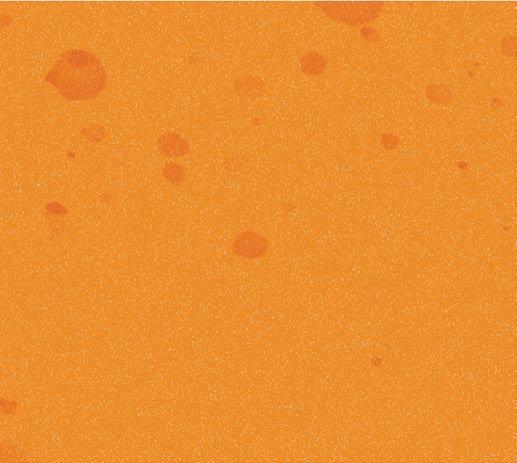
The orange is a souvenir of history. Across time, it has been a harbinger of God and doom, fortune and failure, pleasure and su ering. It is a fruit containing metaphors, dreams, mythologies, superstitions, parables and histories within its tough rind.
So, what happens when the fruit is peeled and each segment - each moment of history, each meaning in time - is pulled apart?




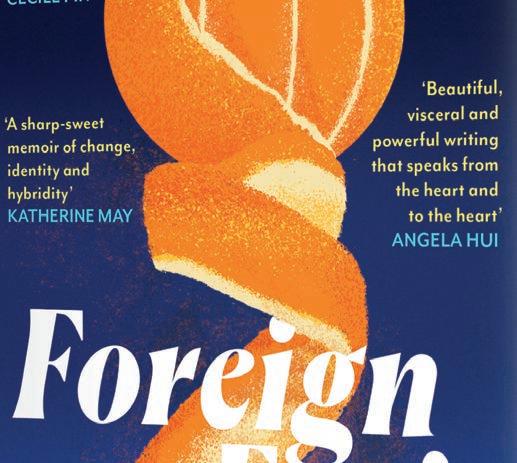

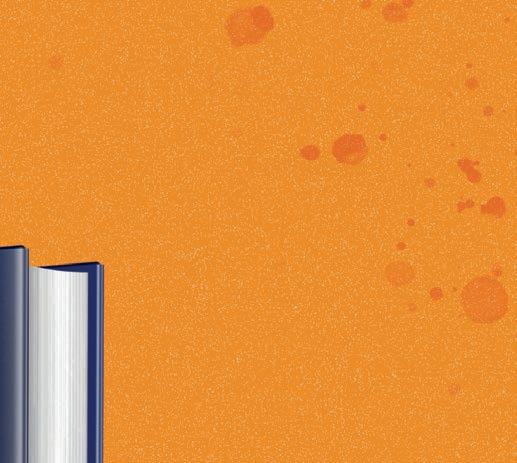
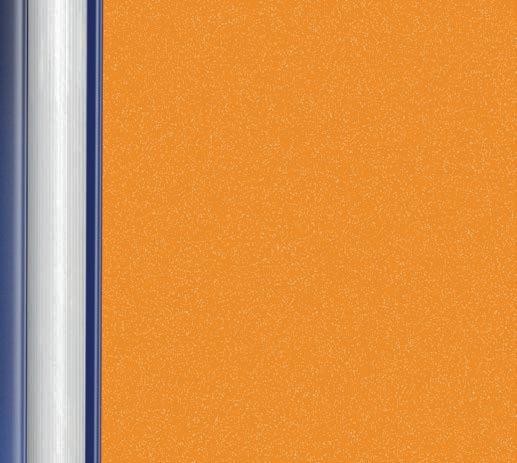
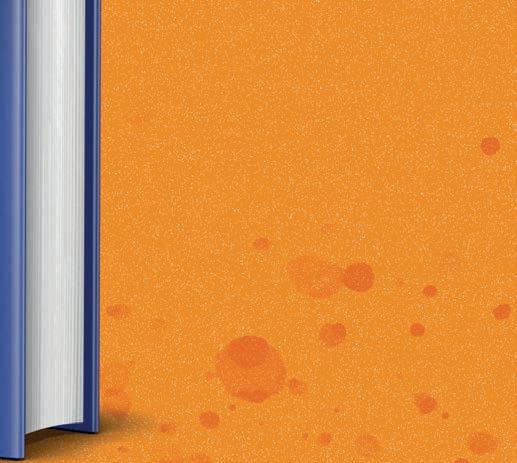

Available now in hardback, ebook and audio

Festival Theatre
SCOTTISH OPERA: THE MERRY WIDOW
THU 29 MAY-SAT 7 JUN
Franz Lehár’s The Merry Widow is an intoxicating whirl of elegant ladies, eligible bachelors, Maxim’s can-can dancers, and everflowing champagne.
SCOTTISH OPERA:
TRIAL BY JURY
FRI 30 MAY-FRI 6 JUN
An unforgettable night of Gilbert and Sullivan comedy.
QUADROPHENIA, A MOD BALLET
TUE 10 JUN-SAT 14 JUN
Pete Townshend's iconic rock song and subsequent film gets the ballet treatment.
THE CROFT
WED 25 JUN-SAT 28 JUN
In the remote Scottish Highlands two women arrive at a former Crofters Hut and have to reckon with the past contained there.
Royal Lyceum
Theatre
THE MOUNTAINTOP
SAT 31 MAY-SAT 21 JUN
Katori Hall’s Olivier awardwinning play about Martin Luther King Jr's last night on Earth.
The Studio THE HORSE OF JENIN
FRI 20 JUNComedy and storytelling meld together to tell a story of Palestinian resistance. THE BALFOUR REPARATIONS 20242044
SAT 21 JUNPerformance lecture investigating ways of confronting the United Kingdom's colonial legacy in Palestine.
Traverse Theatre
EVERY BRILLIANT
THING
WED 4 JUN-SAT 7 JUN
A play about depression and the lengths we go to for those we love.
LEAR
THU 5 JUN-SAT 7 JUN
A contemporary reimagining of King Lear told through Ramesh Meyyappan’s fearless, visual storytelling.
LIVIN' ON A PRAYER
WED 18 JUN-SAT 21 JUN 4000 years after a flood wipes out most of humanity, the Greek gods have to reckon with their own transience.
IN THE CULT OF WORK
THU 19 JUN-SAT 21 JUN
In a parallel Edinburgh, miracles are a fact of childhood.
THE STARS AND AFTER
FRI 20 JUN-SAT 21 JUN
A post-apocalyptic political play questioning class, entitlement and sacrifice.
Dundee Theatre
Dundee Rep
CHESS: DUNDEE
YOUTH MUSIC
THEATRE
WED 11 JUN-SAT 14 JUN
A gripping tale of love, politics, and high-stakes competition, set against the backdrop of the Cold War.
ALL WILL BE WELL
TUE 24 JUN-SAT 28 JUN
This new collaboration between Scottish Dance Theatre and Dundee Rep features the songs of Dundee legend Michael Marra and a hundred strong cast of community performers.
Art
CCA:
Centre for Contemporary Art
ALIA SYED: THE RING IN THE FISH
SAT 17 MAY-SAT 26 JUL
A multi-part exhibition featuring a new experimental 16mm film work presented as a series of moving image vignettes, exploring what role the imagination holds in migration.
David Dale Gallery
PHOTINUS STUDIO + ZOË IRVINE: TIME BASED: SONIC INTERVENTIONS
THU 12 JUN-SAT 14 JUN
Ukrainian new media artist group and Scottish sound artist create a sound installation bridging the sonic non-human landscapes of Ukraine and Scotland.
Glasgow Print Studio
CHRISTIAN NOELLE
CHARLES: WAIT A MINUTE?!!
FRI 4 APR-SAT 31 MAY
A new exhibition by New York-born, Glasgow-based printmaker exploring the complexities of solitude in the Black female experience.
Glasgow School of Art
DEGREE SHOW 2025
FRI 30 MAY-SUN 8 JUN
Degree show for this year's graduating class, spanning across media and genres from painting to moving image.
Glasgow Women's Library
KEYS TO MY MIND
THU 27 MAR-SAT 28 JUN
A showcase of twenty years of work by the Adult Literacy and Numeracy team exploring creative ways of learning.
Glue Factory
GSA POSTGRADUATE
DEGREE SHOW 2025
THU 29 MAY-FRI 6 JUN
Fine Art graduate showcase from Glasgow. Street Level Photoworks
DEPTH OF FIELD
SAT 12 APR-SUN 29 JUN
A group exhibition featuring photographers from the Glasgow Photography Group between 1987-1989, whose work led to the establishment of Street Level Photoworks.
The Briggait
MARIIA NECHALUIK: BLESSED
THU 8 MAY-MON 9 JUN
Grounded in exploring human beings and their relationships with religion, inspired by the artist's childhood experiences.
Tramway
SOLANGE PESSOA
SAT 10 MAY-MON 22 SEP
One of Brazil's most preeminent living sculptors brings together large-scale constellations of organic materials referencing landscapes, archaeology and historical narratives from both Brazil and Scotland.
Art
City Art Centre
OUT OF CHAOS: POSTWAR SCOTTISH ART
1945-2000
SAT 17 MAY-SUN 12 OCT
A survey of work looking at the diversity and ambition of work that came out of the tumult of the Second World War.
JOHN BELLANY: A LIFE IN SELF-PORTRAITURE
SAT 31 MAY-SUN 28 SEP
Over 80 autobiographical sketches and paintings documenting the work of one of the most eminent modern Scottish painters.
HND/BA GRADUATE
EXHIBITION 2025
WED 4 JUN-SUN 15 JUN
Get ready to experience the future of Art and Design as graduating students proudly present their innovative work.
Collective Gallery MERCEDES
AZPILICUETA: FIRE ON THE MOUNTAIN, LIGHT ON THE HILL
FRI 20 JUN-SUN 7 SEP
Large-scale tapestries and installations by Argentinian artist explore lesser known gendered stories from history.
Dovecot Studios
DOUG COCKER: THREADS
SAT 24 MAY-SAT 19 JUL
One of Scotland's leading sculptors unveils a new series of work drawing inspiration from the landscape surrounding his Angus studio.
Edinburgh College ART AND DESIGN
SHOWCASE 2025
WED 28 MAY-TUE 3 JUN
A creative showcase of students unveiling their exceptional final projects.
Edinburgh
College of Art
ECA GRADUATE SHOW 2025
FRI 30 MAY-SUN 8 JUN Cutting edge work by students from across the schools of Art, Design, Music, Architecture, and Landscape Architecture.
Edinburgh
Sculpture
Workshop
CAMILA OSPINA
GAITÁN: UNCONQUERED
NATURES –
TROPICALISM
SAT 5 APR-TUE 17 JUN
Colombian artist examining the legacies of colonialism through the lens of orchid collection.
Ingleby Gallery
IAN HAMILTON
FINLAY: FRAGMENTS
SAT 3 MAY-SAT 14 JUN
Part of a series of exhibitions marking the centenary of Ian Hamilton Finlay's birth, focusing on a group of sculptural installations in stone dating from the 1980s and 90s.
AUBREY LEVINTHAL: MIRROR MATTER
SAT 28 JUN-SAT 13 SEP
Passing quotidian moments of a cast of characters living urban lives.
Jupiter Artland
JONATHAN BALDOCK: WYRD
SAT 10 MAY-SUN 28 SEP
A zoo of hybrid animals formed from textile and clay exploring ideas of myth-making, queerness and hybridity.
Out of the Blue Drill Hall
EXPOSED 25
SAT 3 MAY-THU 12 JUN
The highly anticipated EXPOSED 25, an exhibition spotlighting the work of graduating photography students, revealing a cohort of creative and professional artists.
KERRY SIMMS: THE SMALL PRINT
FRI 16 MAY-SAT 12 JUL
New exhibition by Out of the Blueprint artist-inresidence focusing on the cultural and economic forces that shape our everyday, using abstractions from circuit board imagery to act as a birds eye view of these systems.
RSA: Royal Scottish Academy
199TH RSA ANNUAL EXHIBITION
SAT 3 MAY-SUN 8 JUN
The largest and longestrunning annual exhibition of contemporary art and architecture in Scotland, featuring everything from painting and installation to photography and printmaking.
GEORGE DONALD: THEMES AND VARIATIONS
SAT 3 MAY-SUN 8 JUN
Contemplative paintings of gardens, figures and landscapes that combine and subvert expectations of colour, texture and pattern.
Scottish National Gallery of Modern Art
YOUR ART WORLD
SAT 10 MAY-SUN 2 NOV
Artworks by young people across Scotland created specifically for this exhibition, supported by a team of freelance artists.
Stills
PUTTING OURSELVES IN THE PICTURE
SAT 3 MAY-SAT 7 JUN
A group show by newly emerging photographers.
Summerhall
YOU AND ME AND EVERYONE
SAT 31 MAY-SUN 22 JUN
An exhibition of portraiture exploring identity, representation and connection through the artwork of learning-disabled, autistic and neurodiverse artists.
Talbot Rice Gallery
WAEL SHAWKY
SAT 28 JUN-SUN 28 SEP
A new exhibition by Egyptian artist incorporating previous work for the Venice Biennale, exploring ideas of historicity and postcolonial identity.
The Stand Glasgow
FIRST MONDAY OF THE MONTH
MONDAY NIGHT IMPROV, 20:30
Host Billy Kirkwood & guests act entirely on your suggestions.
TUESDAYS
RED RAW, 20:30
Legendary new material night with up to 8 acts.
FRIDAYS THE FRIDAY SHOW, 20:30
The big weekend show with four comedians.
SATURDAYS THE SATURDAY SHOW, 20:30
The big weekend show with four comedians.
Glee Club
FRIDAYS FRIDAY NIGHT COMEDY, 19:00
The perfect way to end the working week, with four superb stand-up comedians.
SATURDAYS SATURDAY NIGHT COMEDY, 19:00
An evening of awardwinning comedy, with four superb stand-up comedians that will keep you laughing until Monday.
Regular Edinburgh comedy nights
Edinburgh
MONDAYS
RED RAW, 20:30
Legendary new material night with up to 8 acts.
TUESDAYS (FIRST OF THE MONTH)
STU & GARRY’S IMPROV SHOW, 20:30
The Stand’s very own Stu & Garry’s make comedy cold from suggestions.
THURSDAYS THE BEST OF SCOTTISH COMEDY, 20:30
Simply the best comics on the contemporary Scottish circuit.
FRIDAYS THE FRIDAY SHOW, 21:00
The big weekend show with four comedians.
SATURDAYS THE SATURDAY SHOW (THE EARLY SHOW), 17:00
A slightly earlier performance of the big weekend show with four comedians.
The National Gallery of Modern Art
RESISTANCE: HOW PROTEST SHAPED BRITAIN AND PHOTOGRAPHY
SHAPED PROTEST
SAT 21 JUN-SUN 4 JAN
An unmissable exhibition conceived by acclaimed artist and filmmaker Steve McQueen.
THEY HAD FOUR YEARS 2025 SAT 17 MAY-SUN 22 JUN
Generator Projects present their annual graduate show, featuring new work by five recent graduates from various art colleges across Scotland.
V&A Dundee
GARDEN FUTURES: DESIGNING WITH NATURE
SAT 17 MAY-SAT 25 JAN
Bringing together artists and thinkers such as Derek Jarman and Jamaica Kincaid, this exhibition looks at the politics and aesthetics of the modern garden.
SATURDAYS THE SATURDAY SHOW, 20:30
The big weekend show with four comedians. Monkey Barrel Comedy Club
SECOND AND THIRD TUESDAY OF EVERY MONTH THE EDINBURGH REVUE, 19:00
The University of Edinburgh’s Comedy Society, who put on sketch and stand-up comedy shows every two weeks.
WEDNESDAYS TOP BANANA, 19:00
Catch the stars of tomorrow today in Monkey Barrel’s new act night every Wednesday.
THURSDAYS SNEAK PEAK, 19:00 + 21:00
Four acts every Thursday take to the stage to try out new material.
FRIDAYS
MONKEY BARREL COMEDY’S BIG FRIDAY SHOW, 19:00/21:00
Monkey Barrel’s flagship night of premier stand-up comedy.
FRIDAYS
DATING CRAPP, 22:00
Tinder, Bumble, Grindr, Farmers Only...Come and laugh as some of Scotland’s best improvisers join forces to perform based off two audience members dating profiles.
SATURDAYS
MONKEY BARREL COMEDY’S BIG SATURDAY SHOW, 17:00/19:00/21:00
Monkey Barrel’s flagship night of premier stand-up comedy.
SUNDAYS
MONKEY BARREL COMEDY’S BIG SUNDAY SHOW, 19:00/21:00
Monkey Barrel’s flagship night of premier stand-up comedy.
Fresh from releasing their excellent new record Hard Times Furious Dancing, and ahead of their appearance at Hidden Door, Snapped Ankles’ Austin Ankles takes on this month’s Q&A
At the end of March, dance-forward, London-based post-punks Snapped Ankles released their fourth studio album, the intoxicating Hard Times Furious Dancing. The title says it all – in hard times, what else is there to do but dance? Headlining the opening night of this year’s Hidden Door arts festival, where they play alongside Mermaid Chunky, Bikini Body, Pearling, Roller Disco Death Party and more, Snapped Ankles invite you into their ghillie-suited world of escapism with big energy, big motorik beats, and big, bold statements. Ahead of their performance, frontman Austin Ankles takes on this month’s Q&A.
What’s your favourite place to visit?
Dungeness. Where else can you picnic among nuclear detritus and sea-smashed shingle while being spiritually haunted by Derek Jarman’s Prospect Cottage and the Cold War concrete listening ears? It’s like the ghost of Jack Parsons built a garden out of radiation and longing.
What’s your favourite food?
Mushrooms. Fungal, feral, and fundamentally smarter than most people I know. Mycelium networks mirror neural networks – except more honest, more connected, and less obsessed with Elon Musk and the other insane Cornucopians.
What’s your favourite colour?
Green, because, as Ursula K. Le Guin warned us in a whisper filtered through moss: “The word for world is forest.” It’s the hue of camouflage, trickery, photosynthesis, and vengeance.
Who was your hero growing up?
Alvin Lucier. The only man who could make a room sing back at itself. I Am Sitting in a Room was my childhood lullaby – yes, I was raised by experimental frequencies and gently malicious oscillations.
Whose work inspires you now?
Still Alvin Lucier. If his ghost could loop itself in a reverb chamber for all eternity, I’d sign the guestbook with a steel wire in blood and static.
What three people would you invite to your dinner party and what are you cooking?
Alvin Lucier, John Hi s, and Alice Walker. I’d serve a single, unsettling caramelised garlic quiche. Cold. With too much nutmeg. We’d discuss quantum weirdness, ecstatic protest, and whether or not the quiche is sentient. (It is.)
What’s your all-time favourite album?
Transa by Caetano Veloso. It’s exile and ecstasy in one breath. It makes melancholy wear lipstick and samba in circles. It’s what I’d imagine would play in Jack Parsons’ rocket lab just before something exploded beautifully.

What book would you take to a desert island?
The Book of Lies by Aleister Crowley. Not for the content, but for the confusion. Perfect for talking back to the sea and summoning storms when bored. Plus, it makes excellent kindling for when you finally lose your mind.
Who’s the worst?
Anyone who says “just saying” at the end of a sentence... Congratulations, you’re a devil’s intern at best.
When did you last cry?
I cried at a field recording of wind whistling through
the Singing Ringing Tree in Lancashire. Tears of awe. And allergies. Possibly cursed.
What are you most scared of?
Being trapped in a departure lounge with no exits or water, no dissonance, and no mushrooms. Eternal small talk and other tourists are hell.
Tell us a secret?
I once tried to summon Jack Parsons’ ghost during a lunar eclipse using only a theremin and expired cheese. Something answered. It hasn’t stopped humming.
If you could be reincarnated as an animal, which animal would it be and why?
A raven, naturally. Trickster, scavenger, prophet, poet. Plus, I could hang out at Tower of London and whisper spoilers in tourists’ ears.
I’d love to know more about your latest album – what inspired Hard Times Furious Dancing? Alice Walker lit the fuse. Dancing as defiance, as spellwork, as survival. The world bans joy when it’s organised. This album is a waltz through outlawed hope and ecstatic resistance. Kind of if a riot learned how to bolero!
What’s your favourite thing about the album and what do you hope people get out of listening to it?
My favourite thing? That it exists in spite of everything. I hope it makes people move like they’re shaking off centuries. Like they’re conjuring something on mushrooms. Like they’re laughing at doom and daring it to dance.
You’re playing at Hidden Door in Edinburgh in June, what can people expect on the night? Any surprises up your ghillie-suited sleeves?
Expect noise and logs. Expect grace and barks. Expect a disembodied voice whispering Jack Parsons’ rocket equations backwards. Expect something bathed in greenlight. Expect fungi. And yes, the ghillie suit may contain secrets. Possibly snacks.
Hard Times Furious Dancing is out now via The Leaf Label; Snapped Ankles play Hidden Door, The Paper Factory, Edinburgh, 11 Jun snappedankles.com
Hidden Door Festival runs from 11-15 Jun; for info and tickets head to hiddendoorarts.org







You must Tap-Off to only pay the cheapest adult daily city zone fare, otherwise an airport zone fare will be charged.

